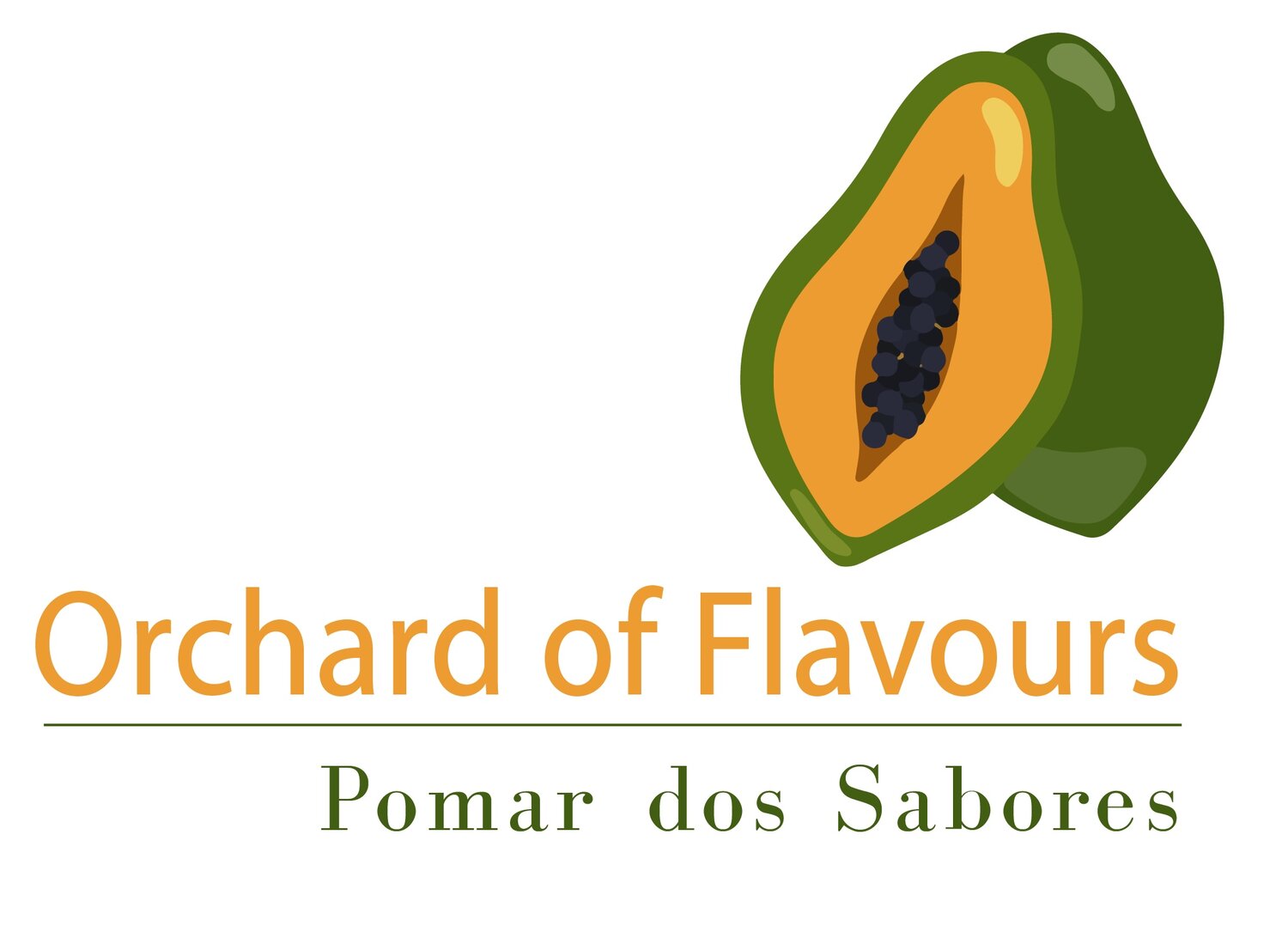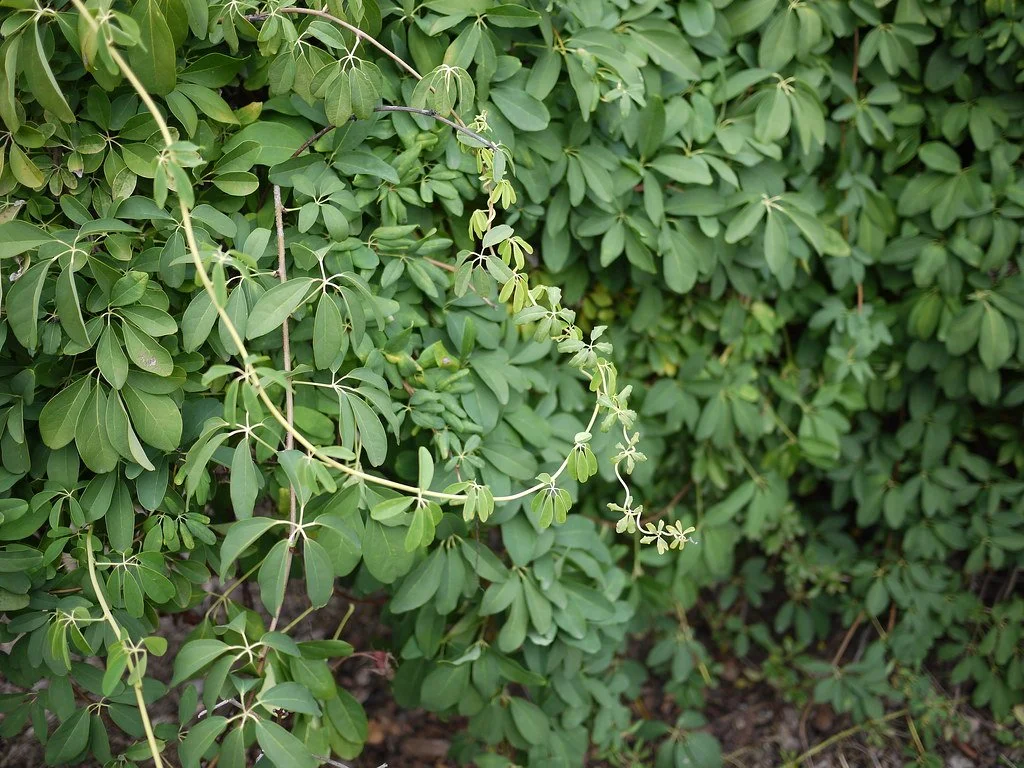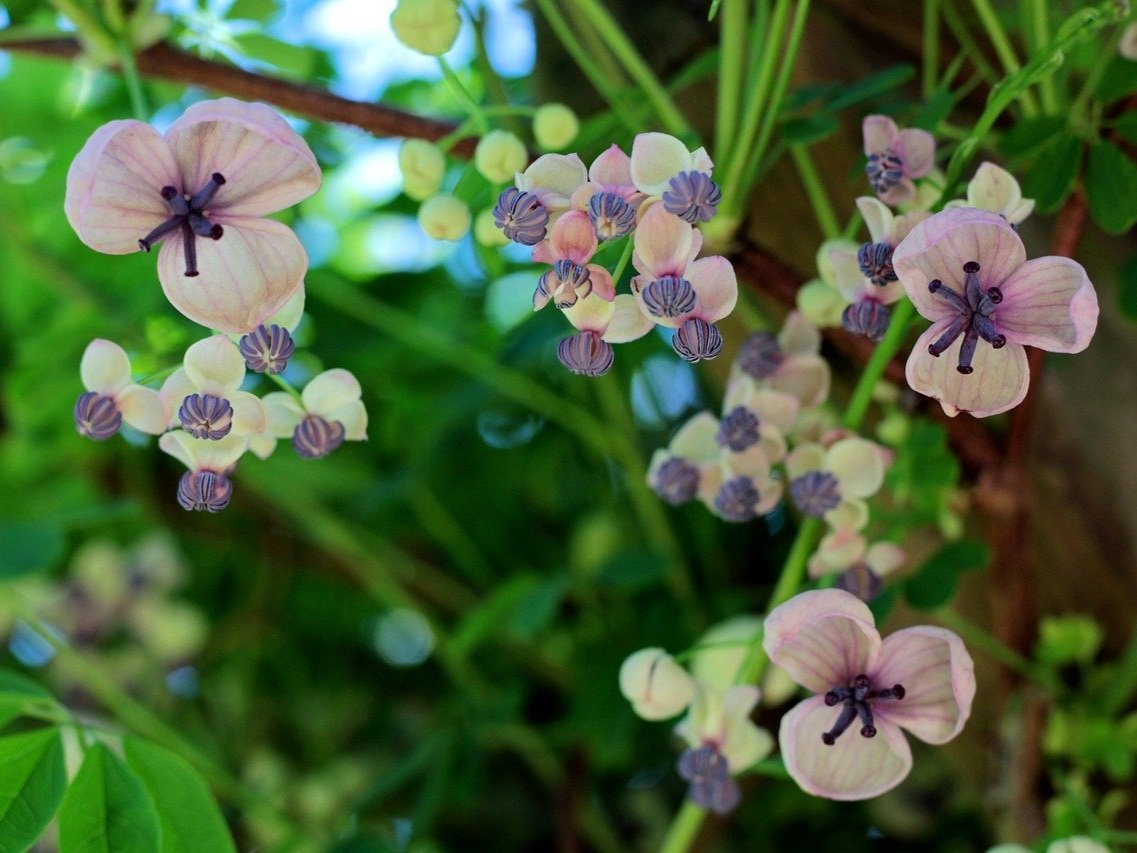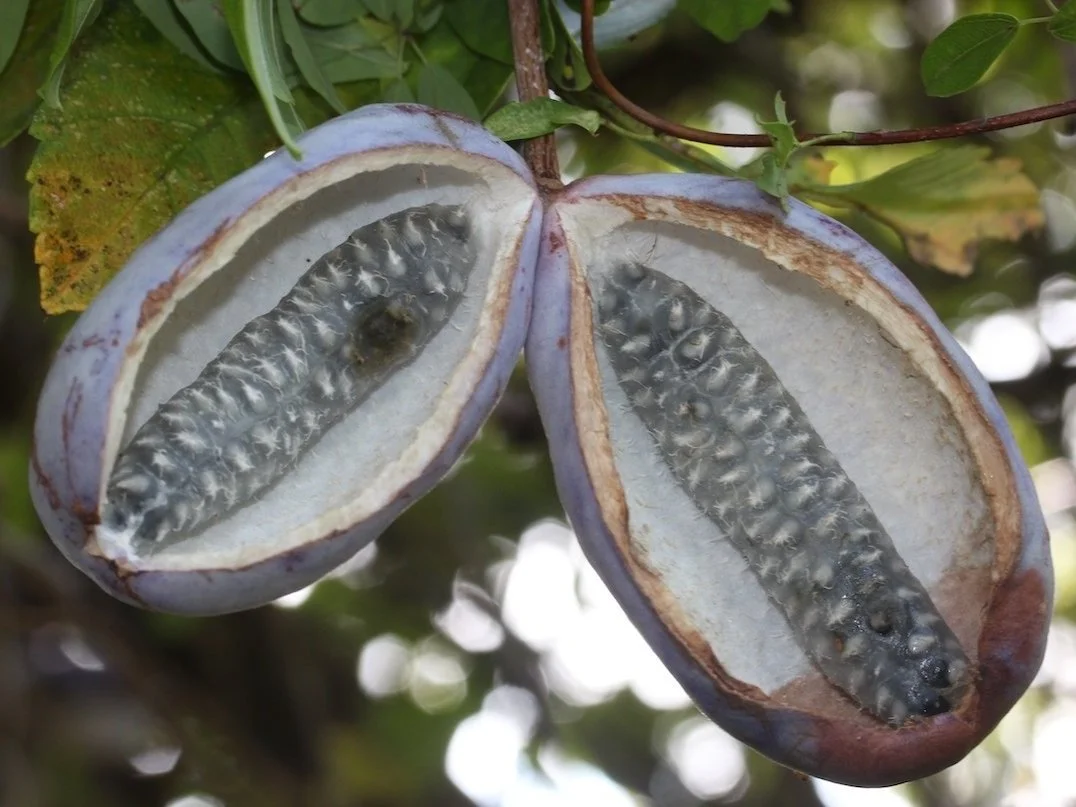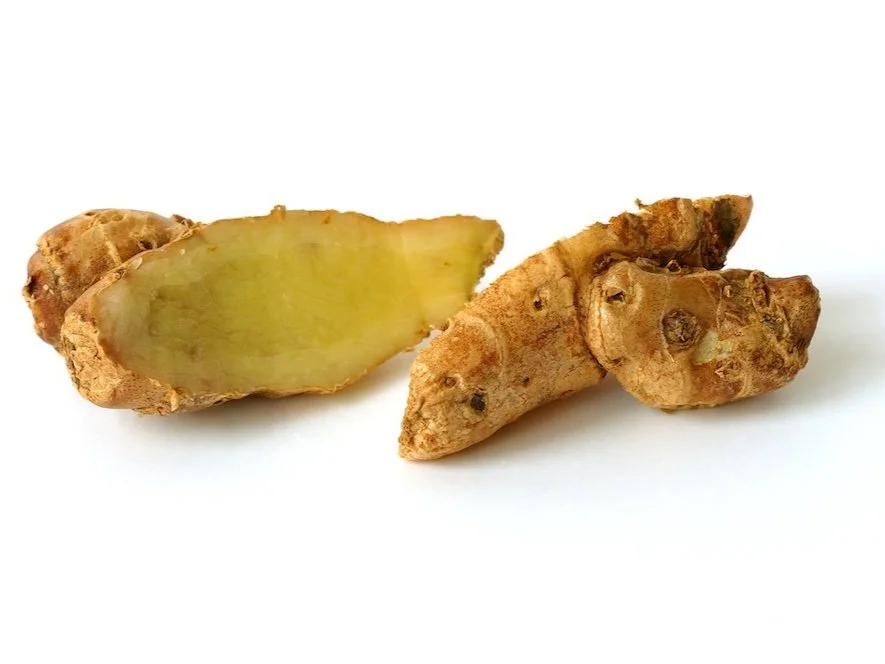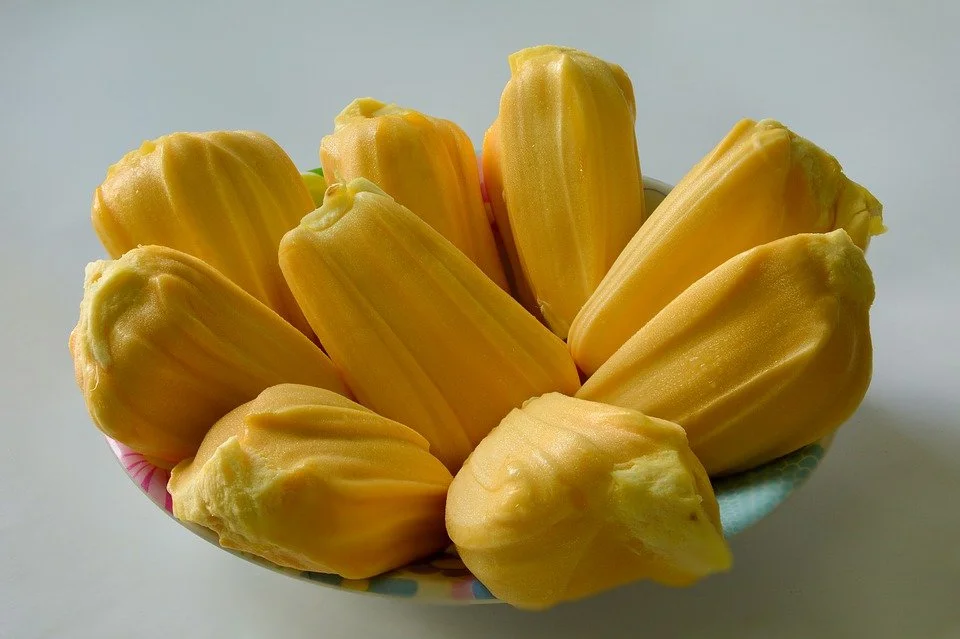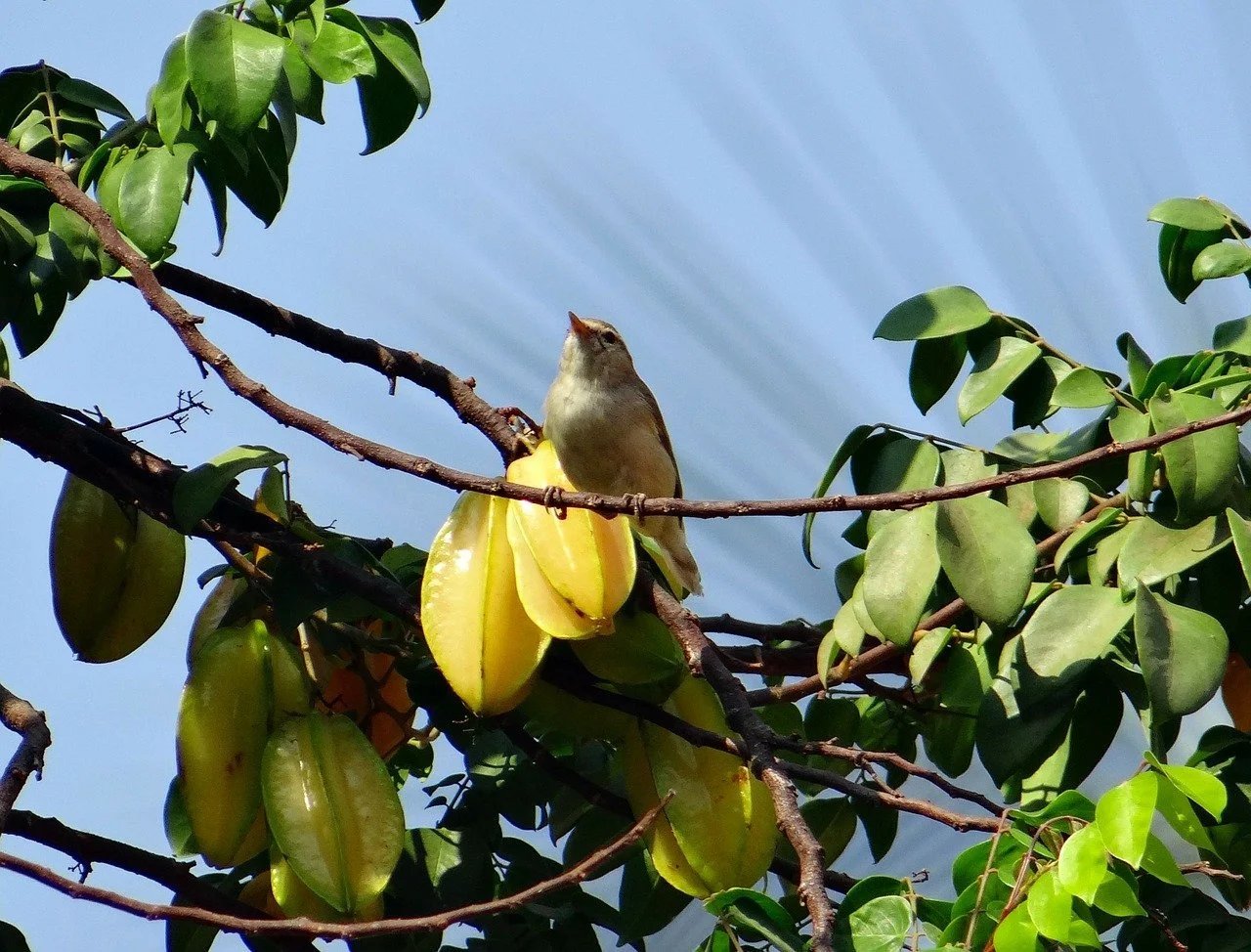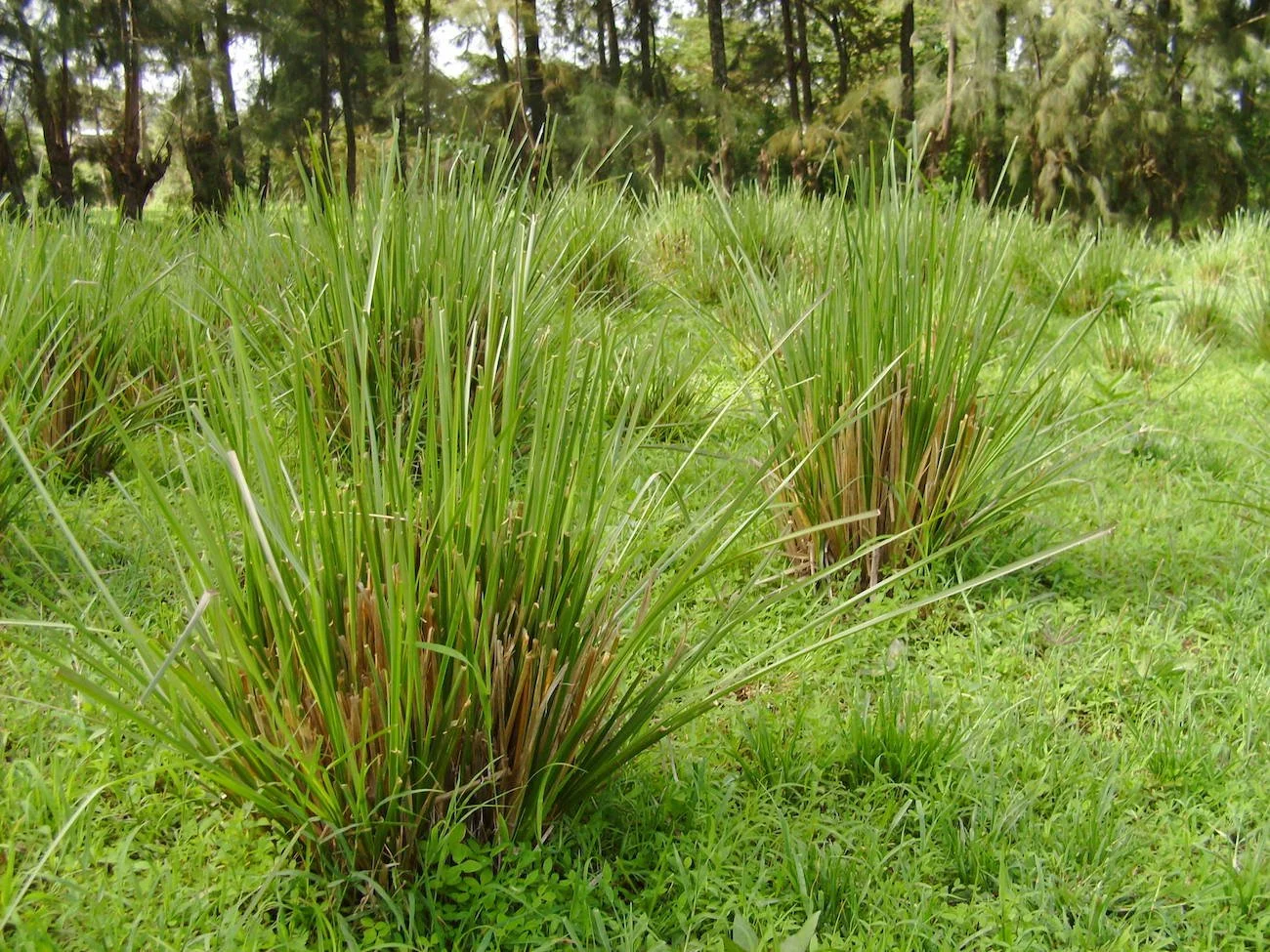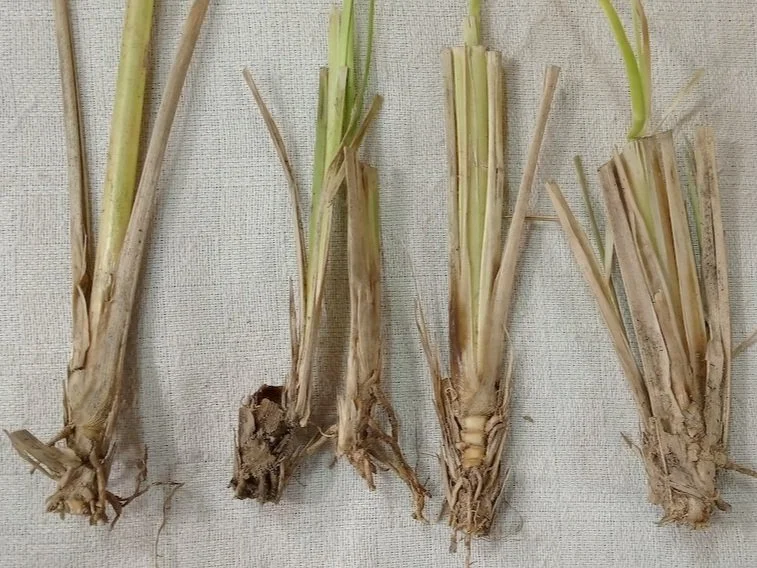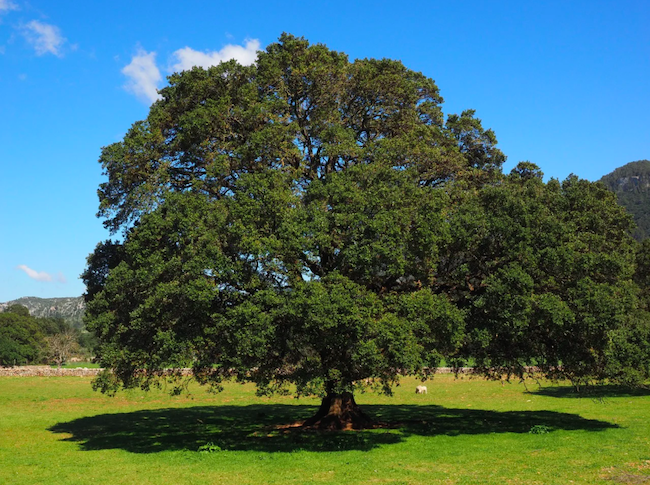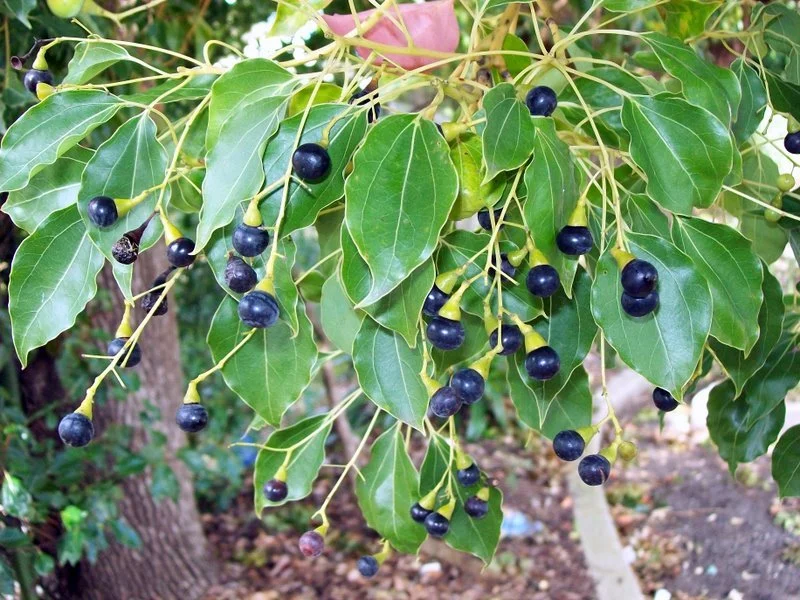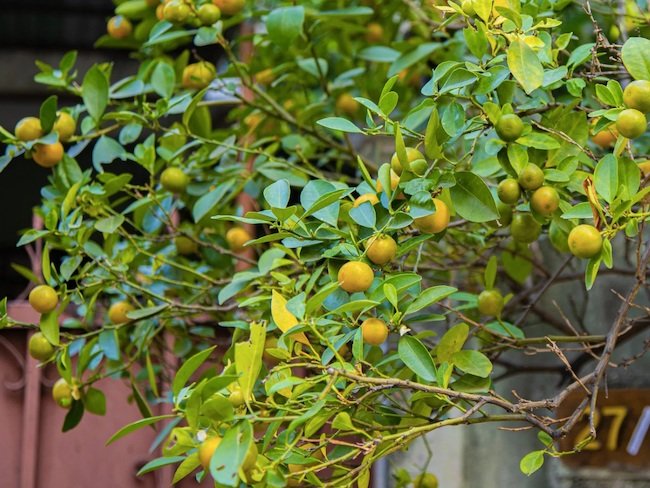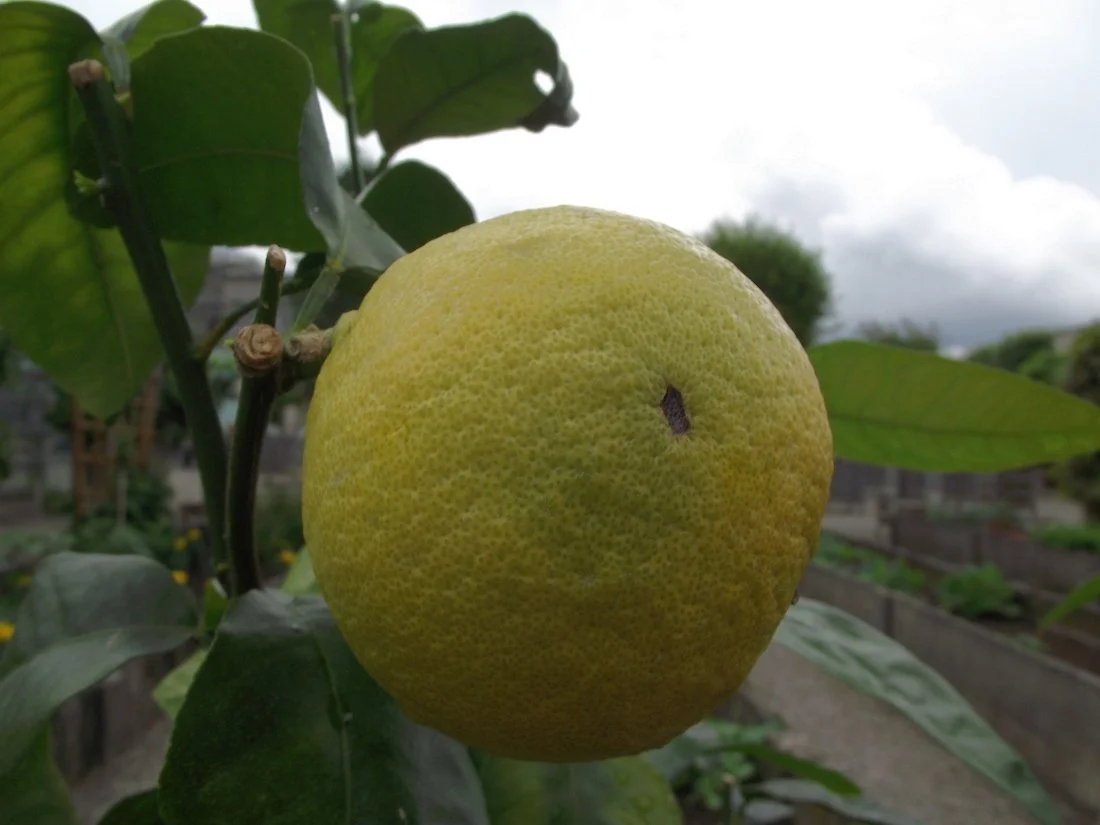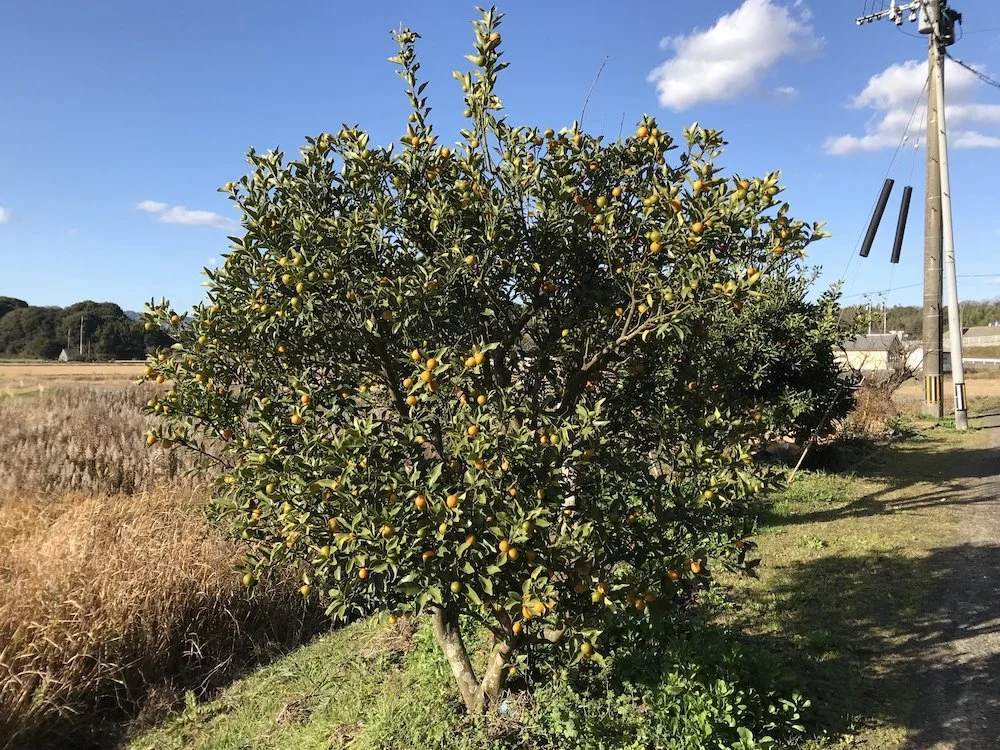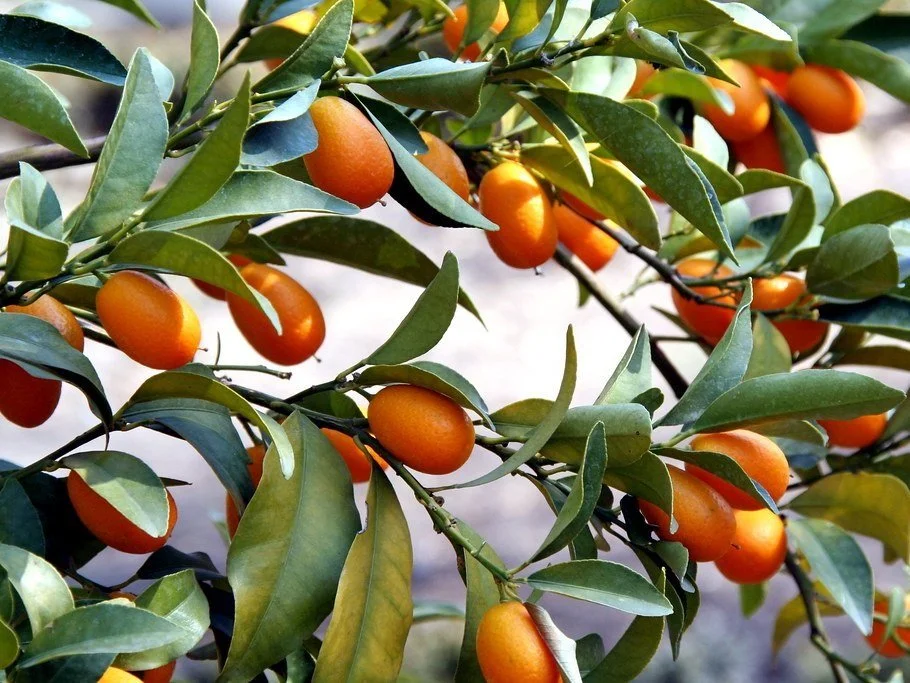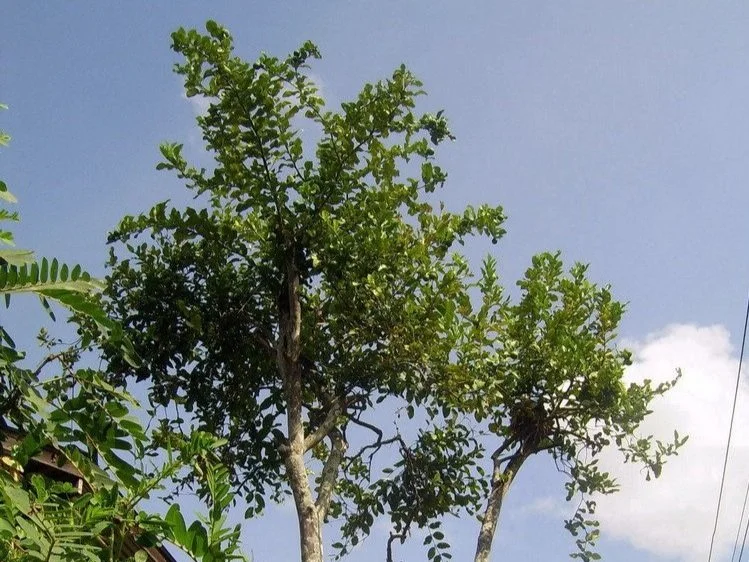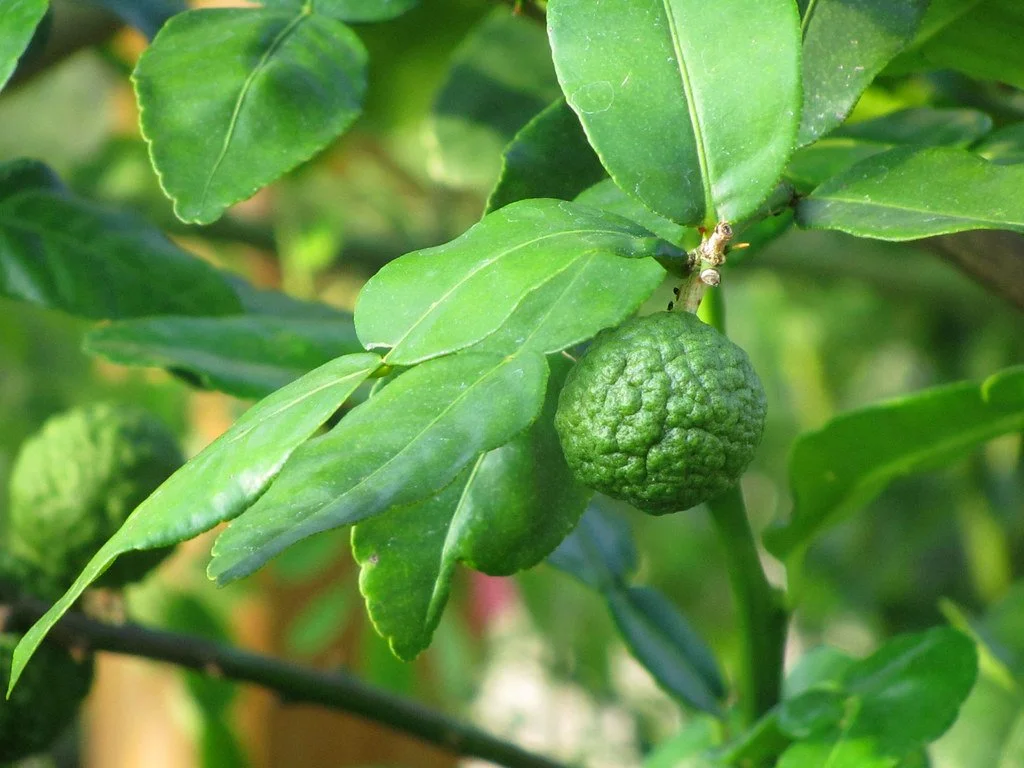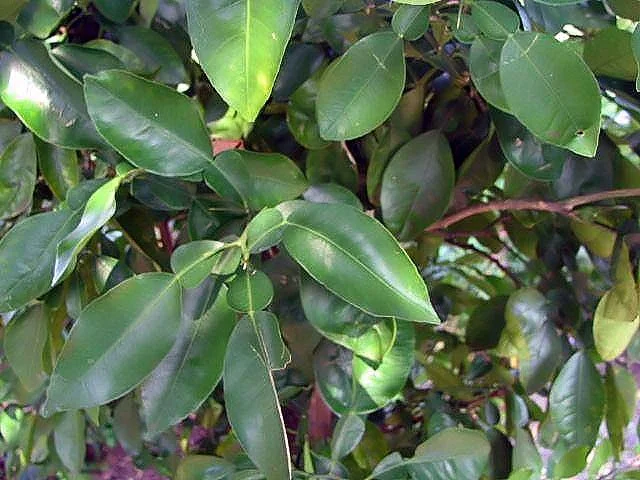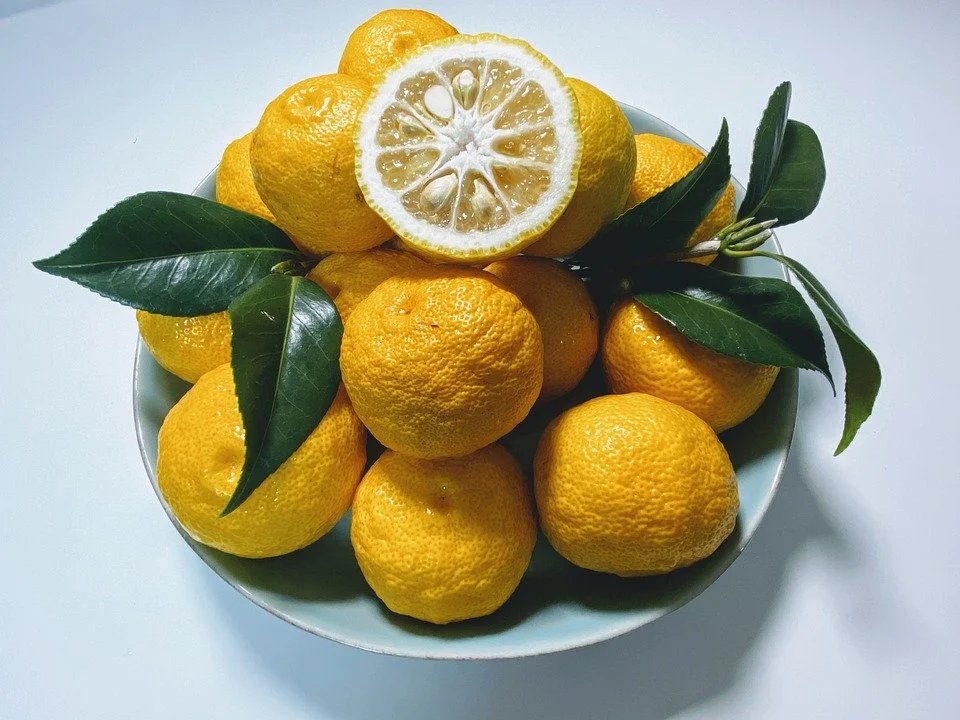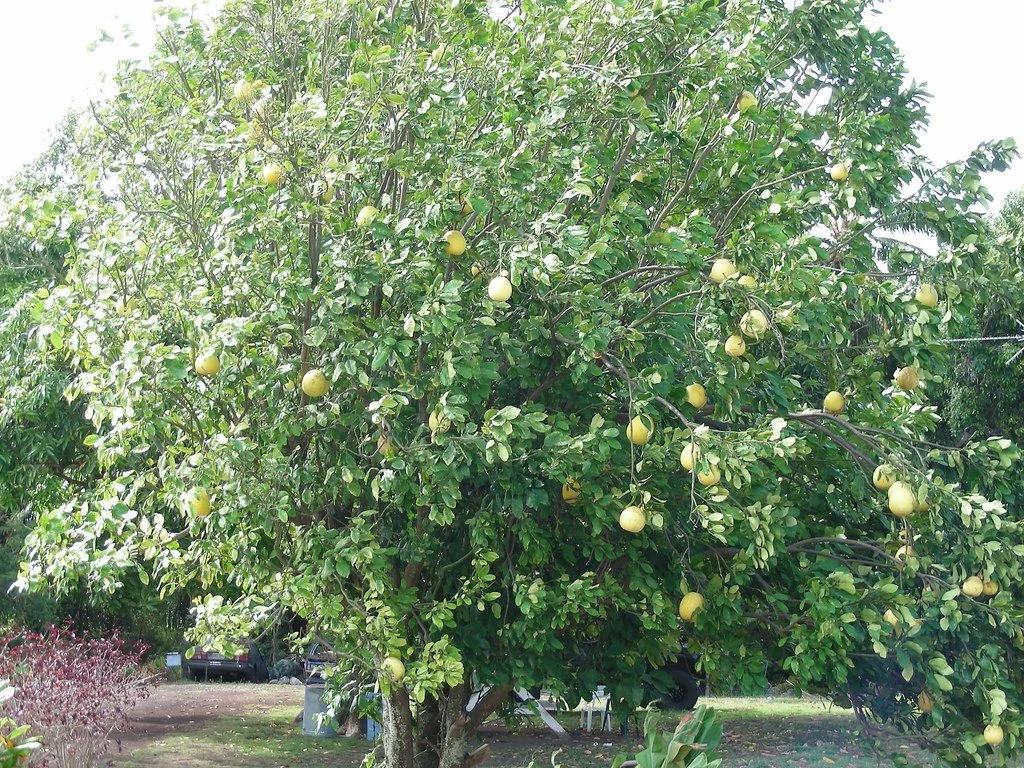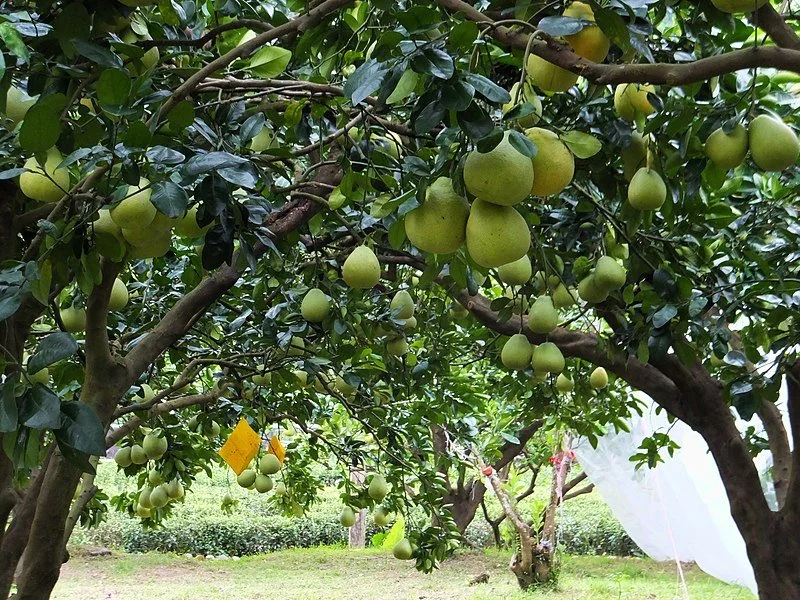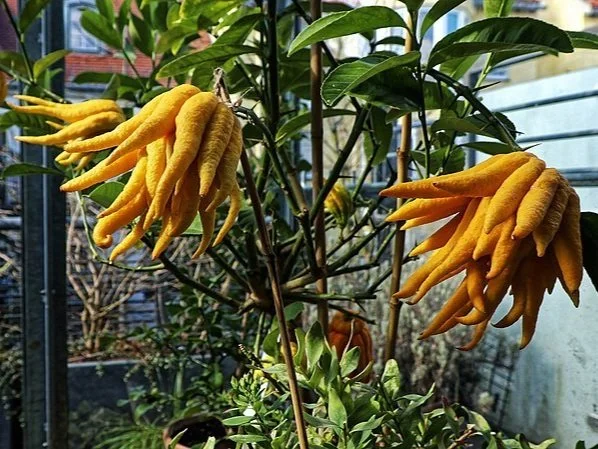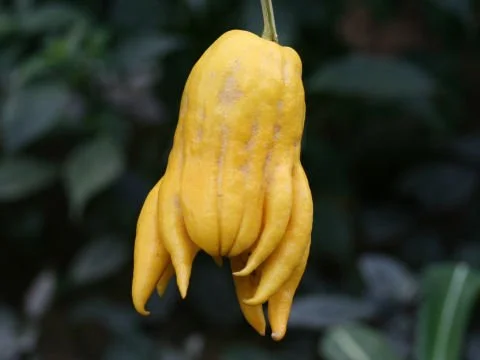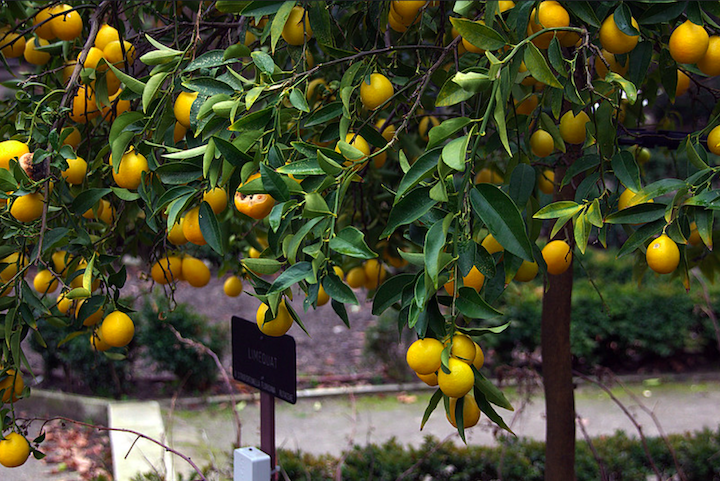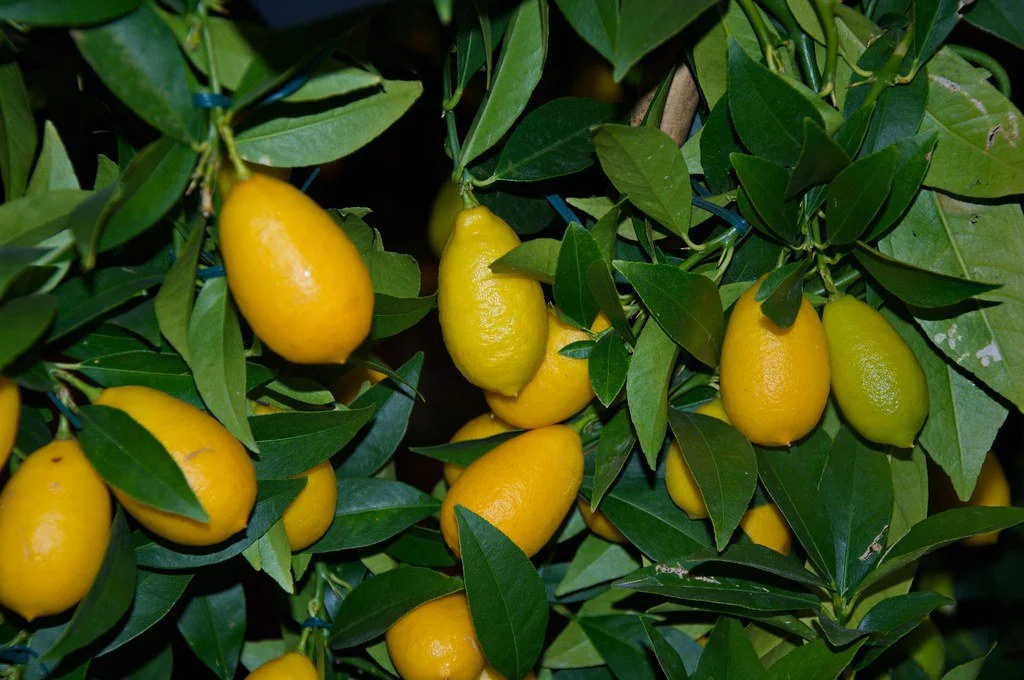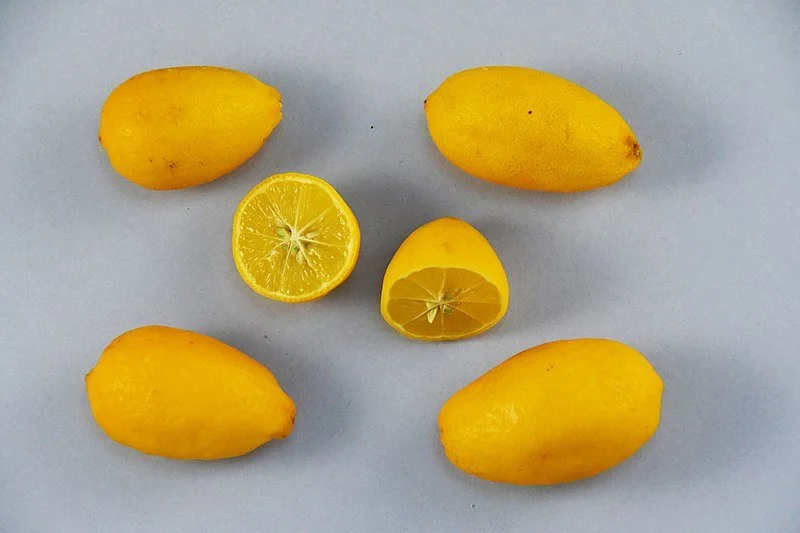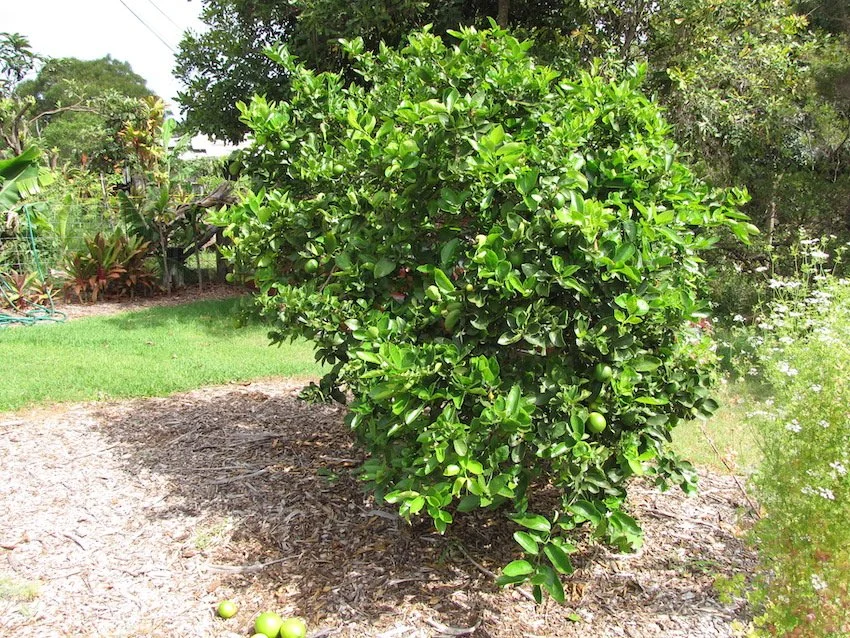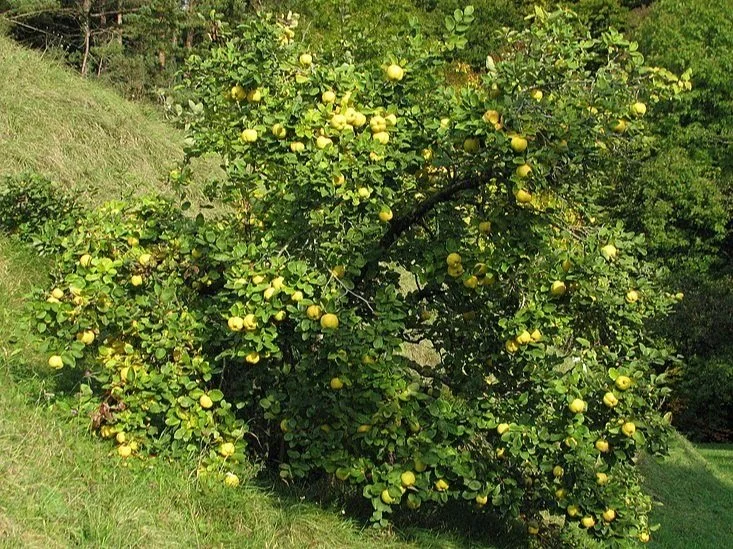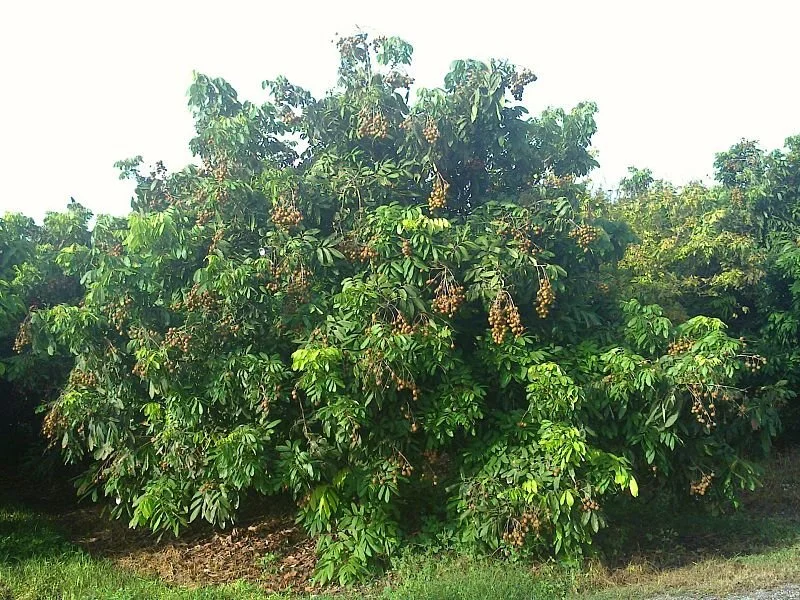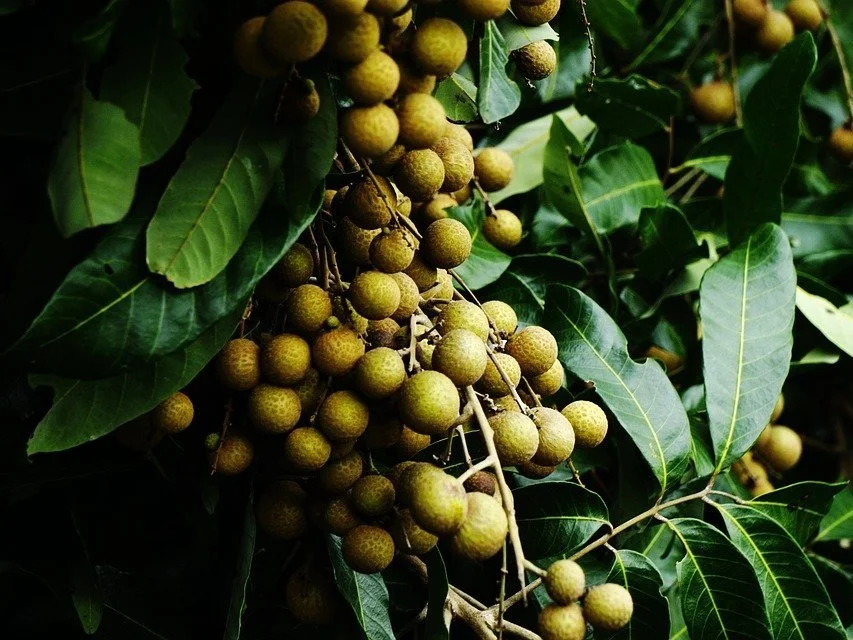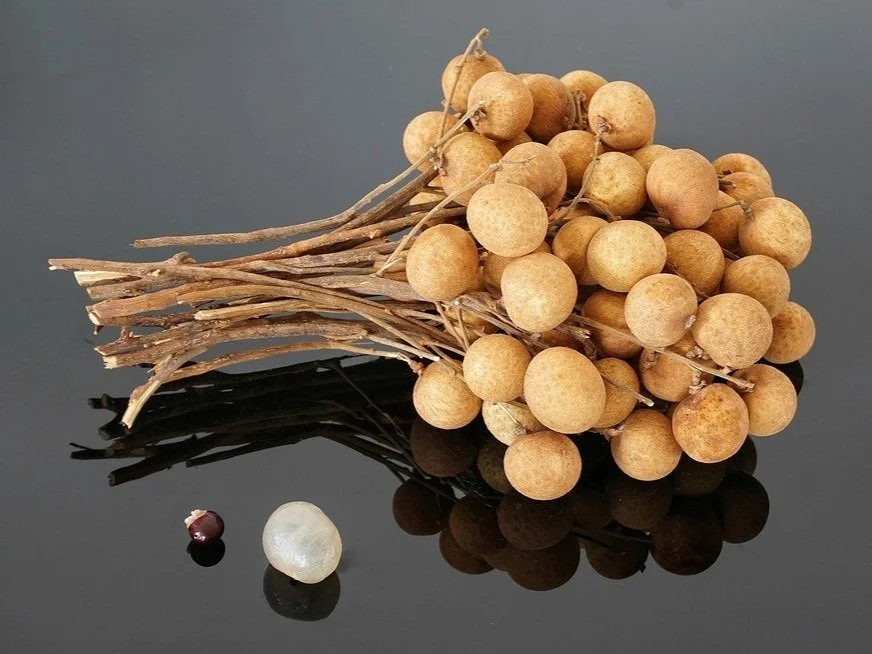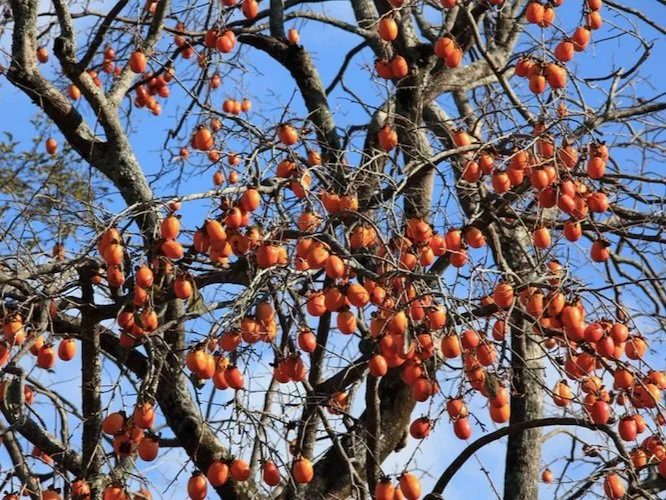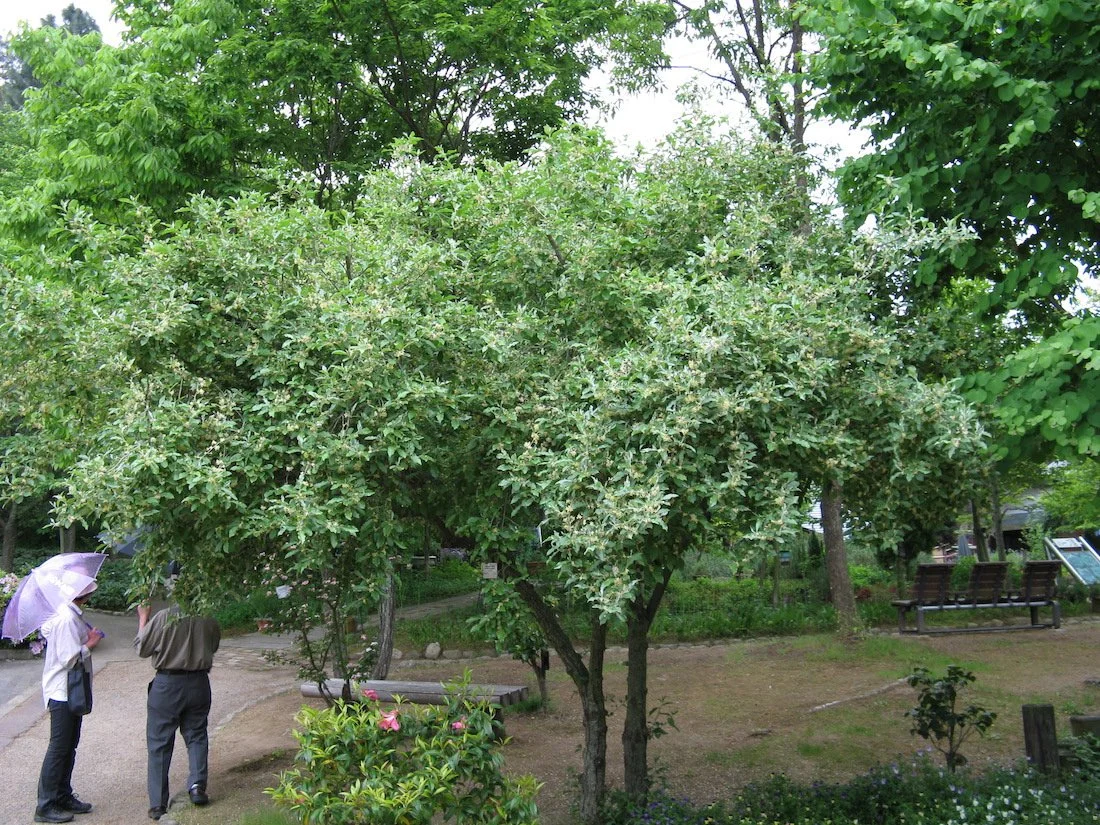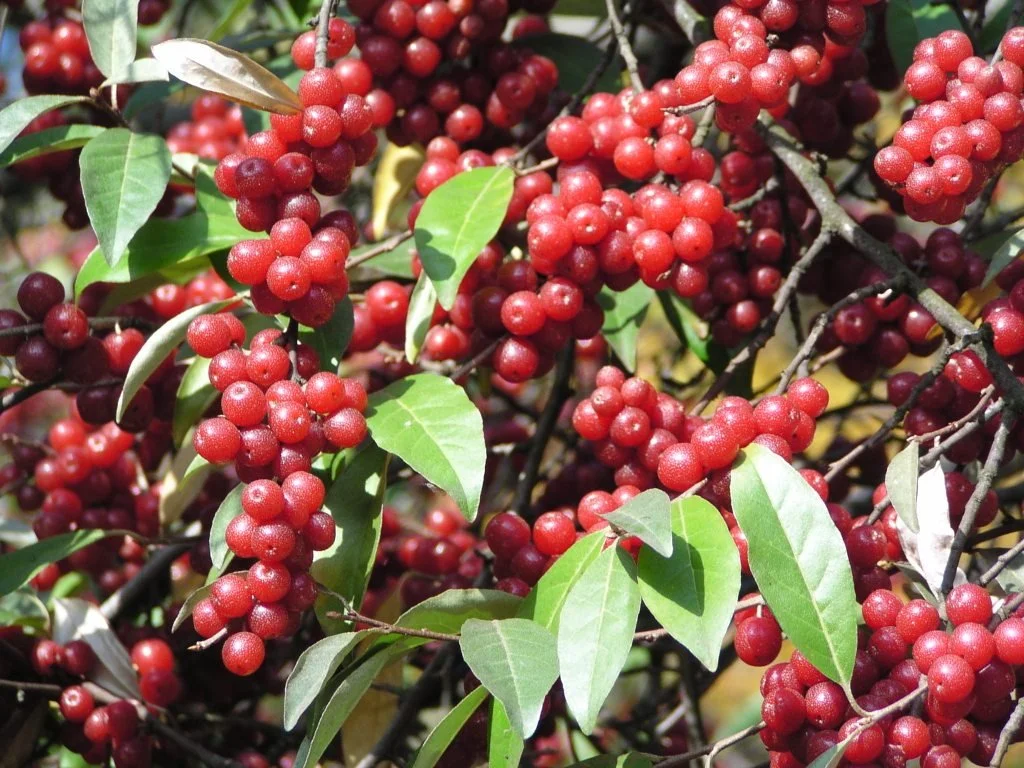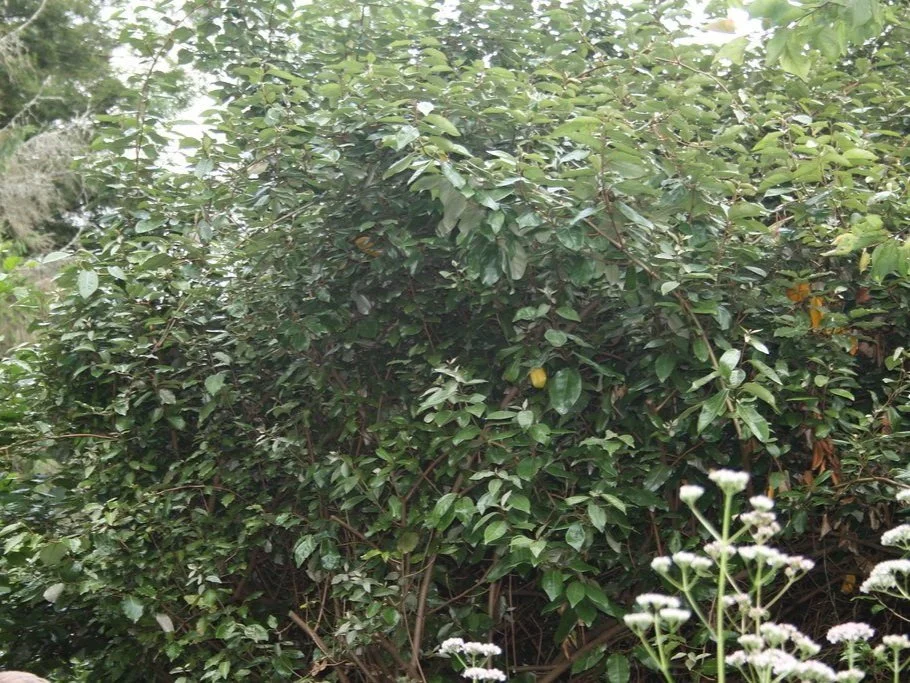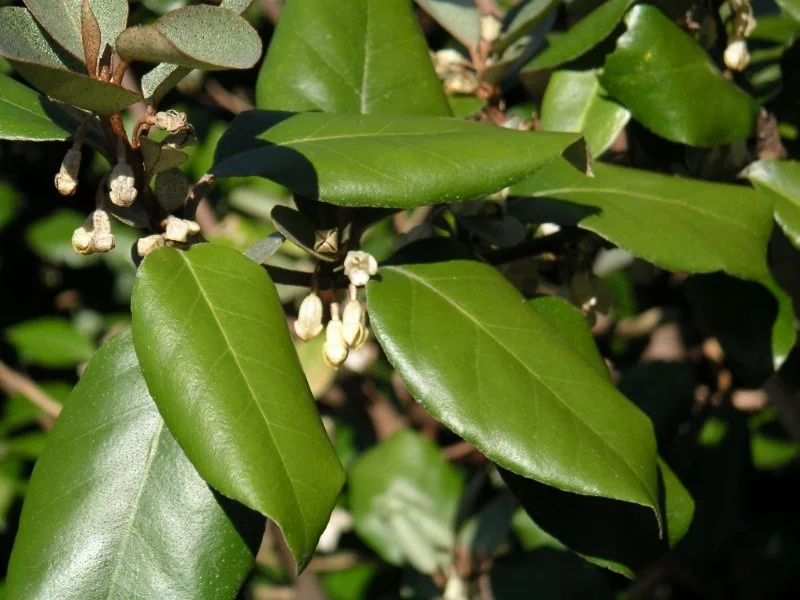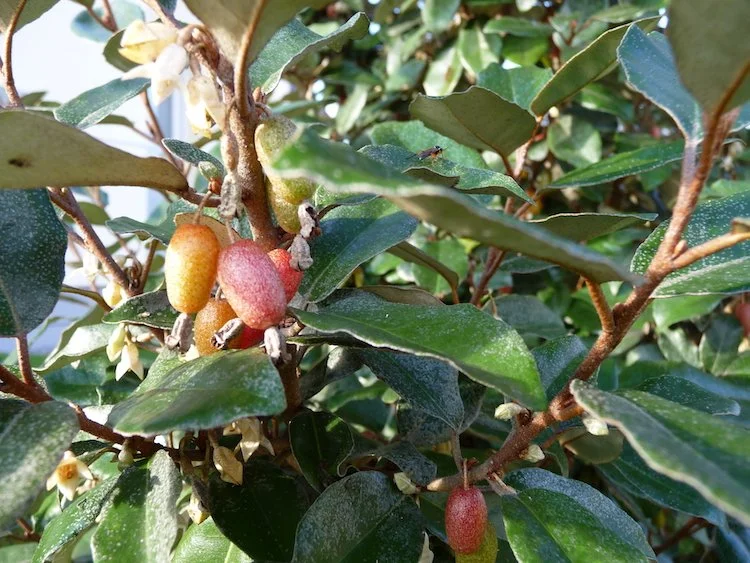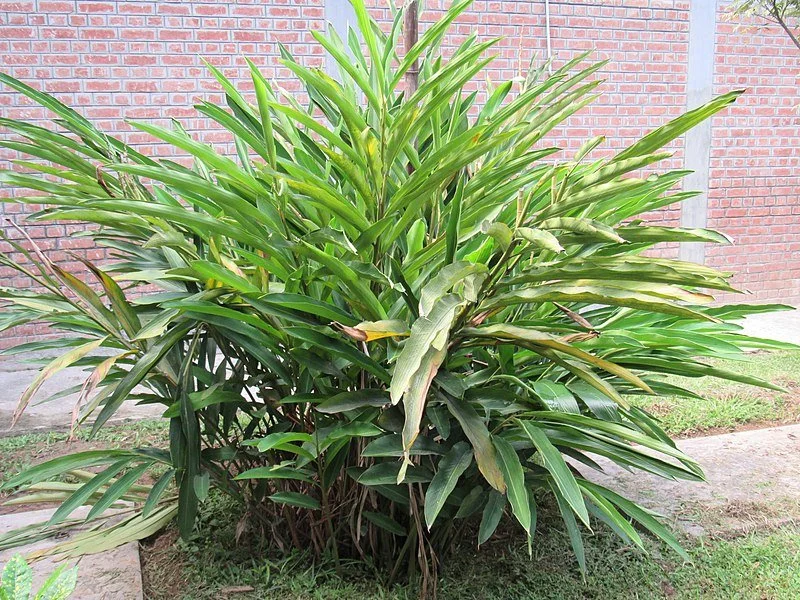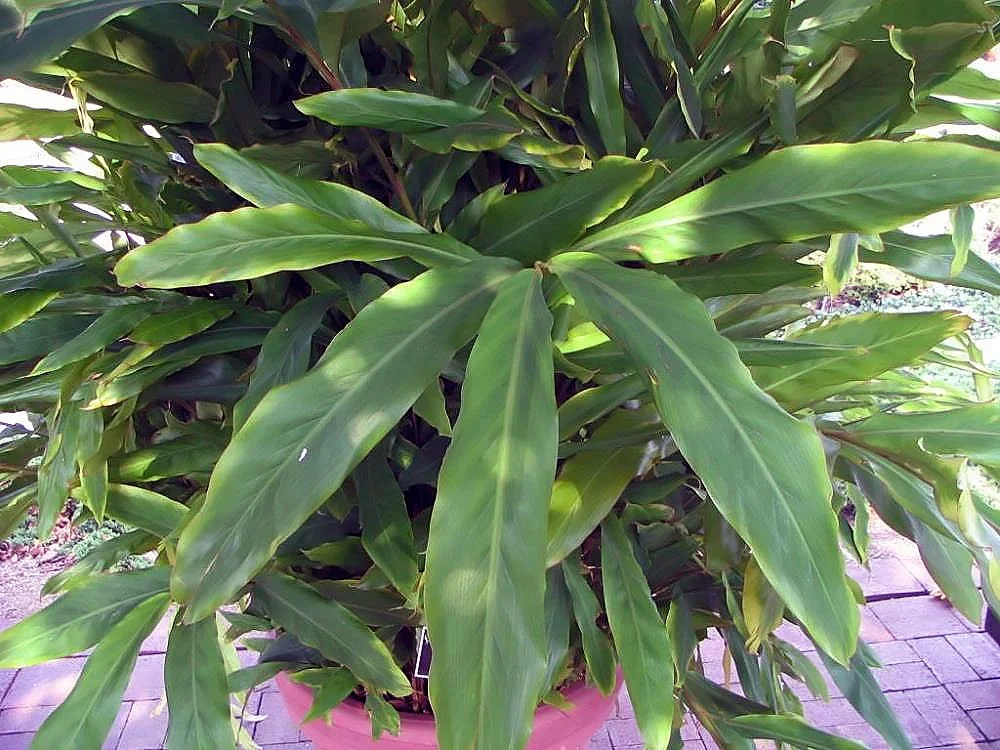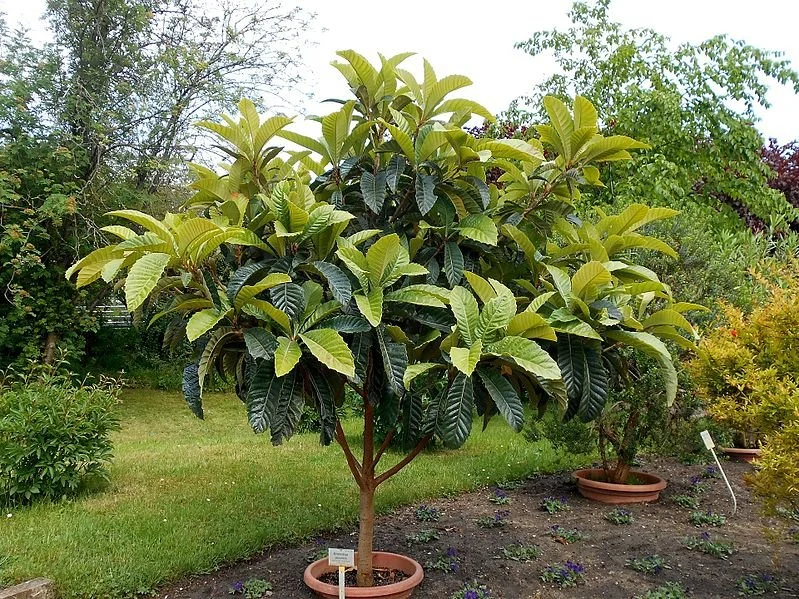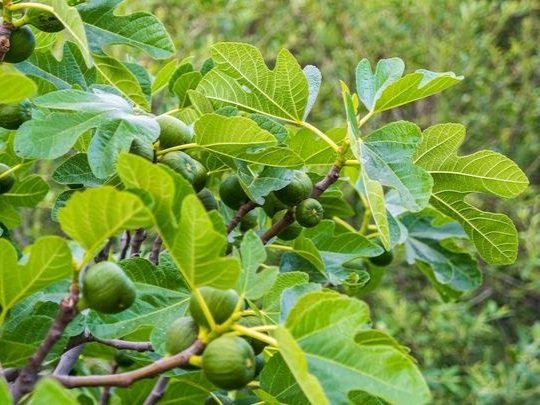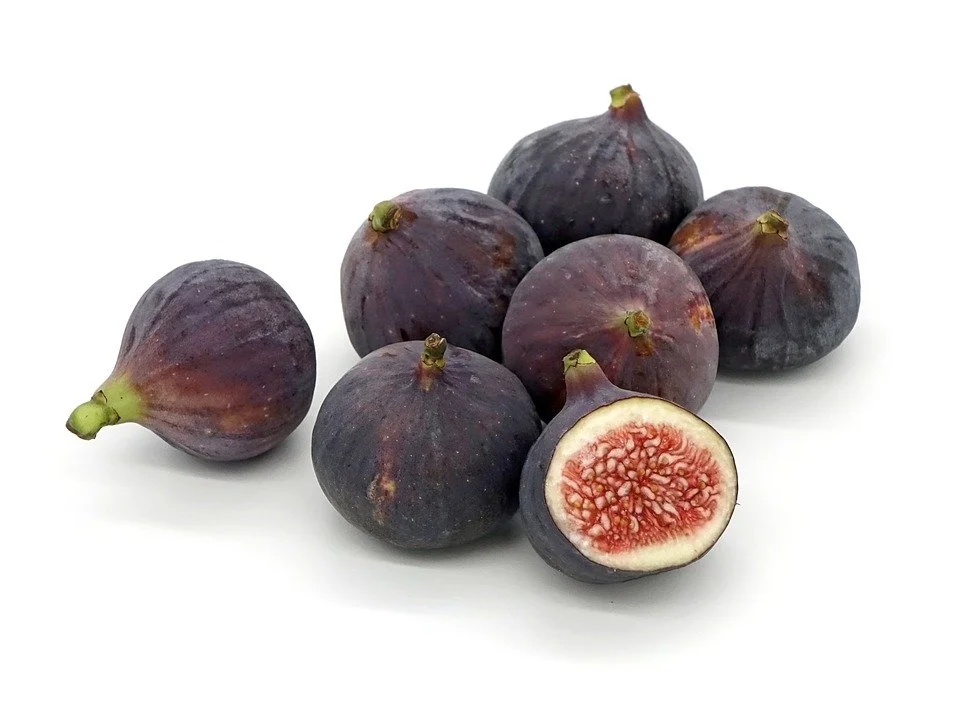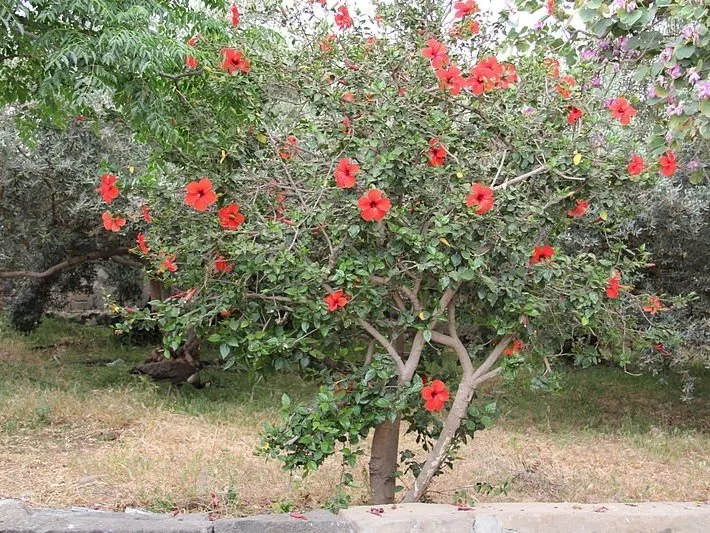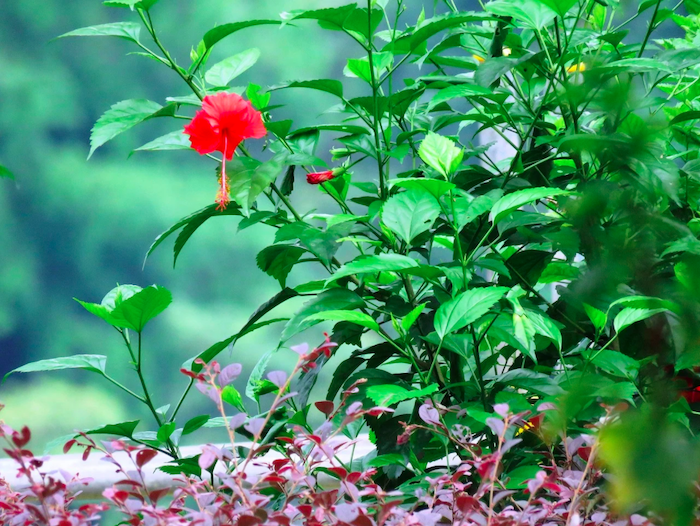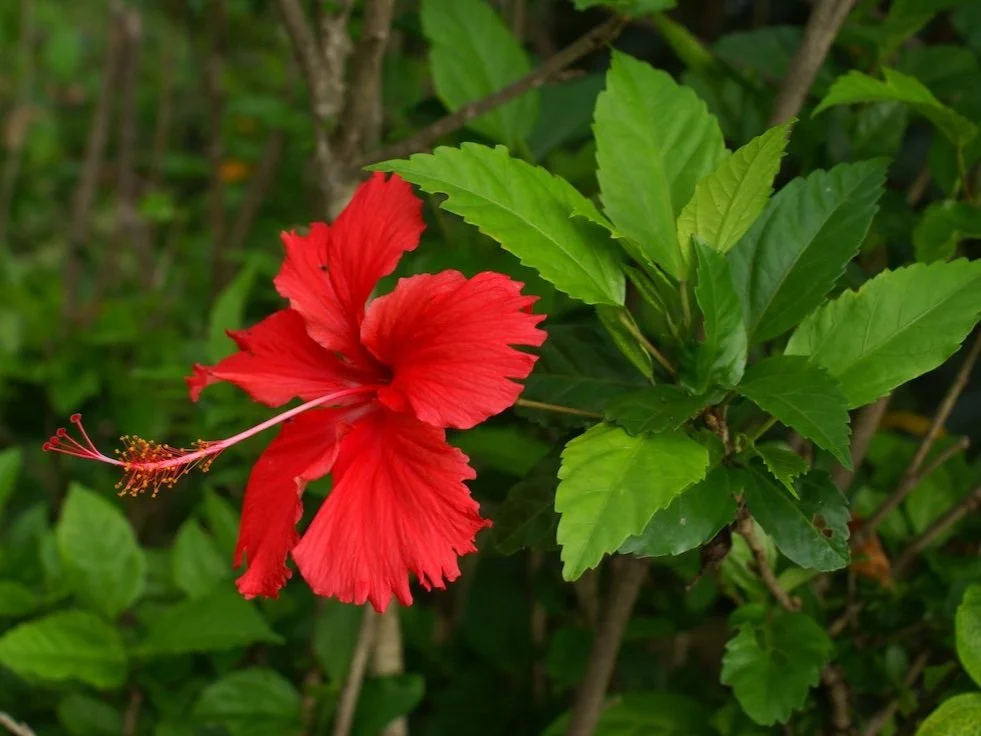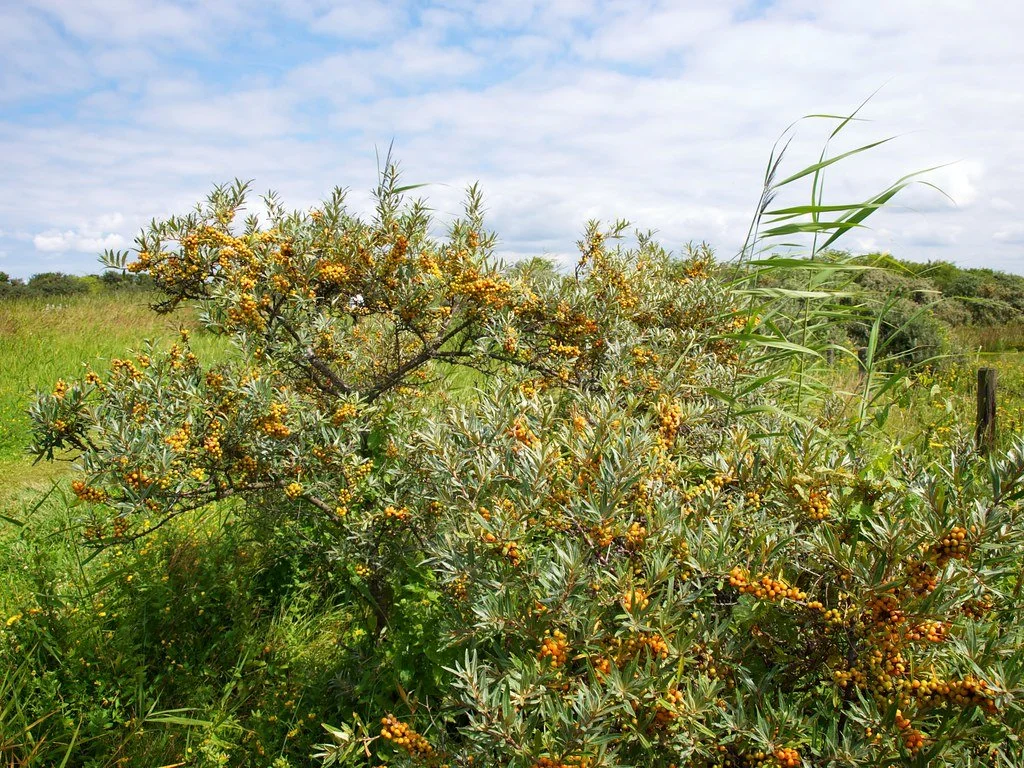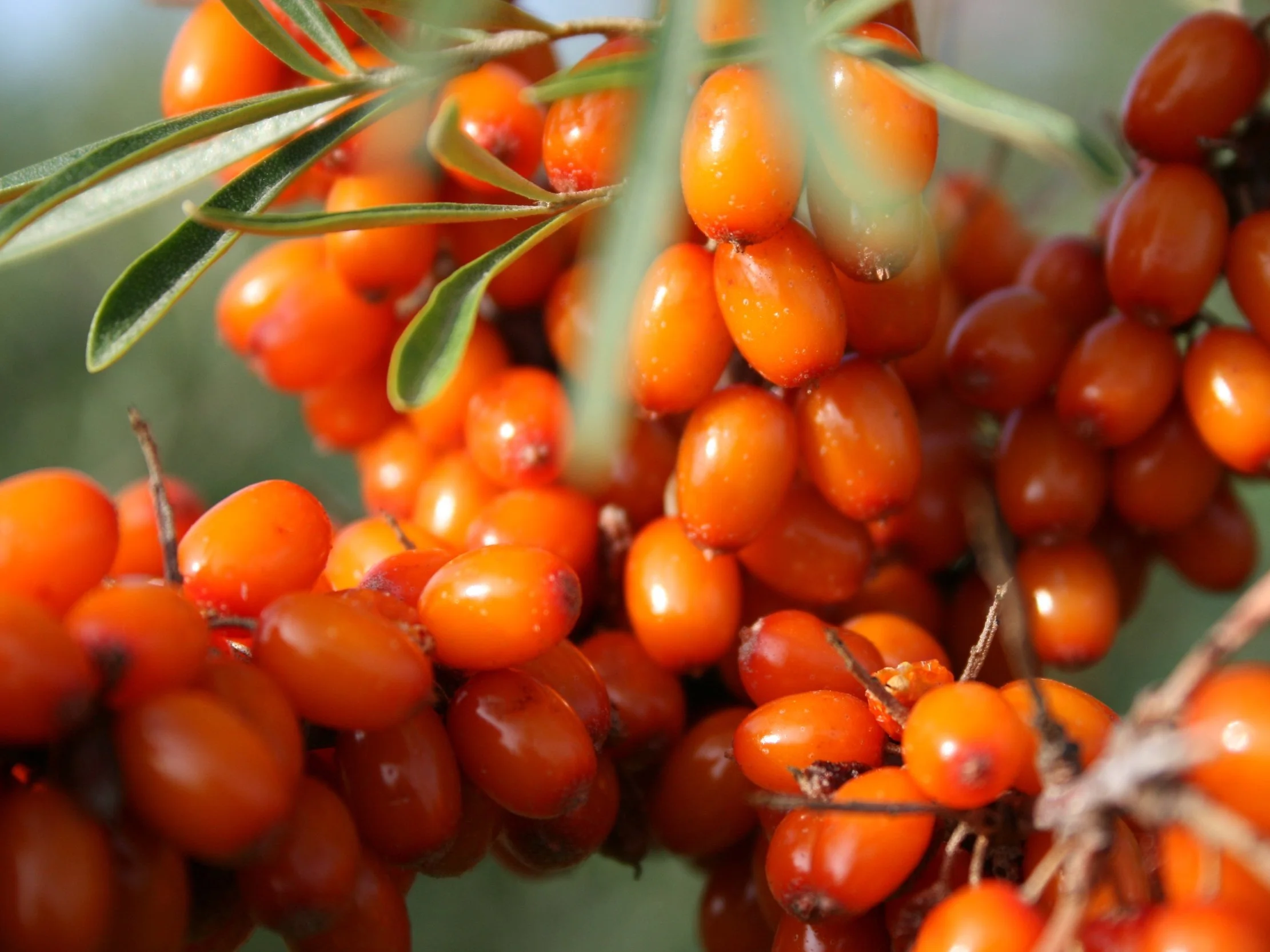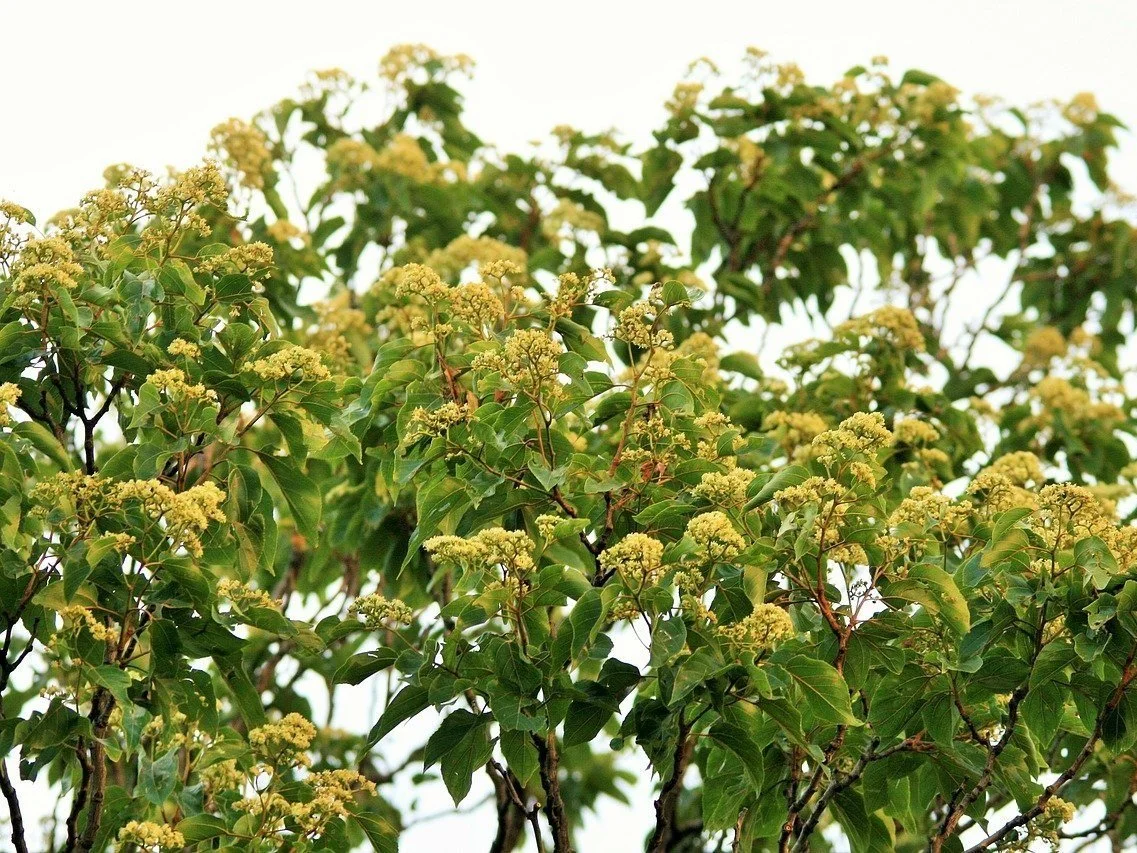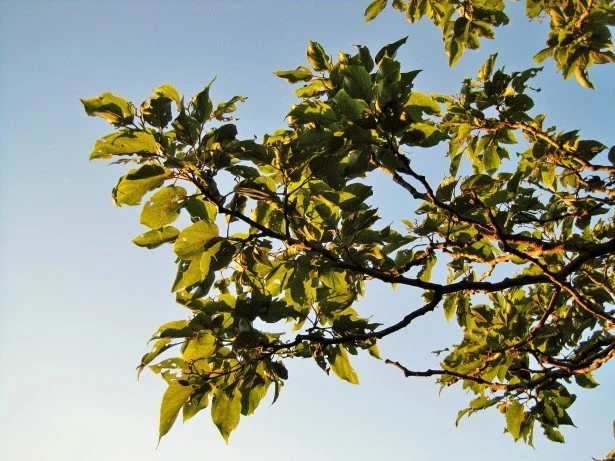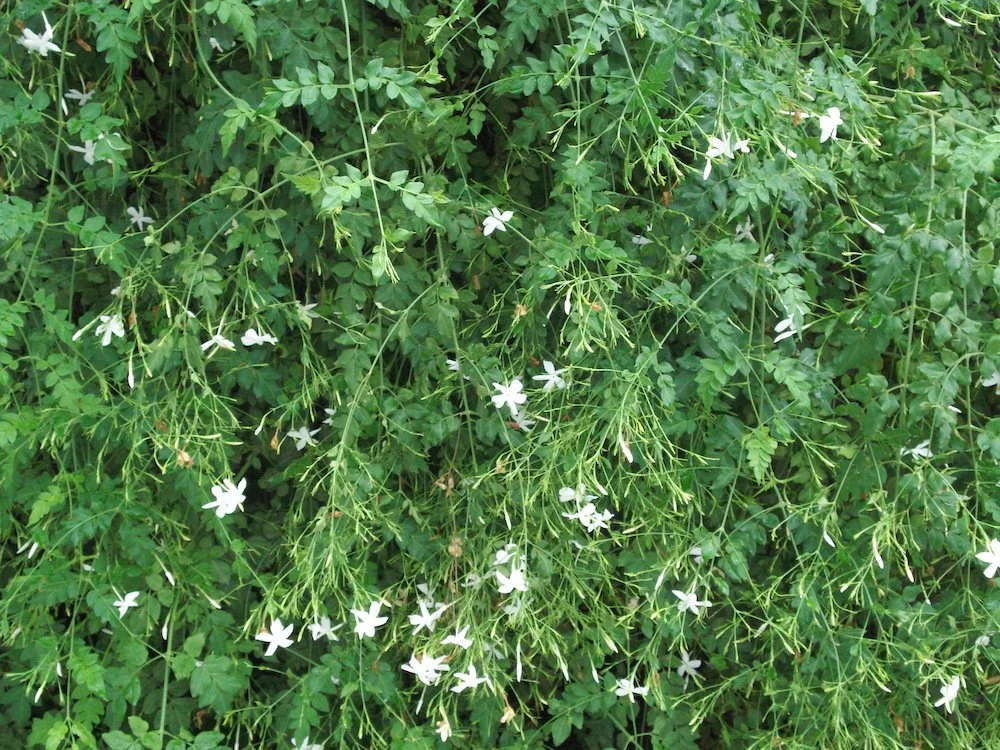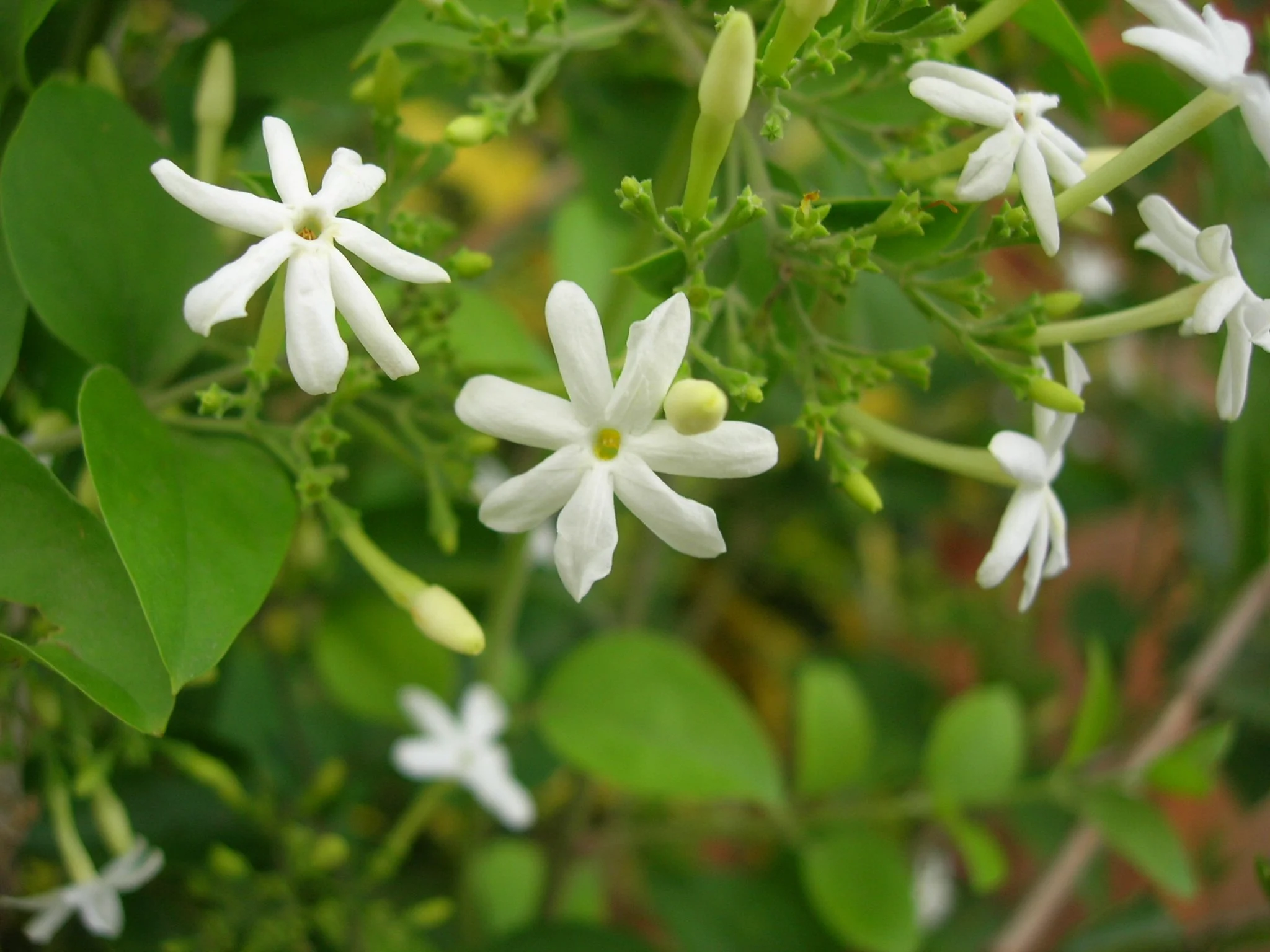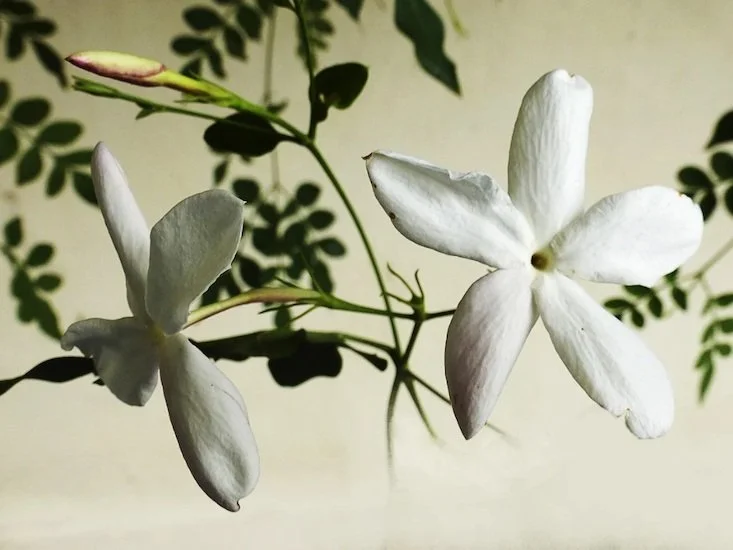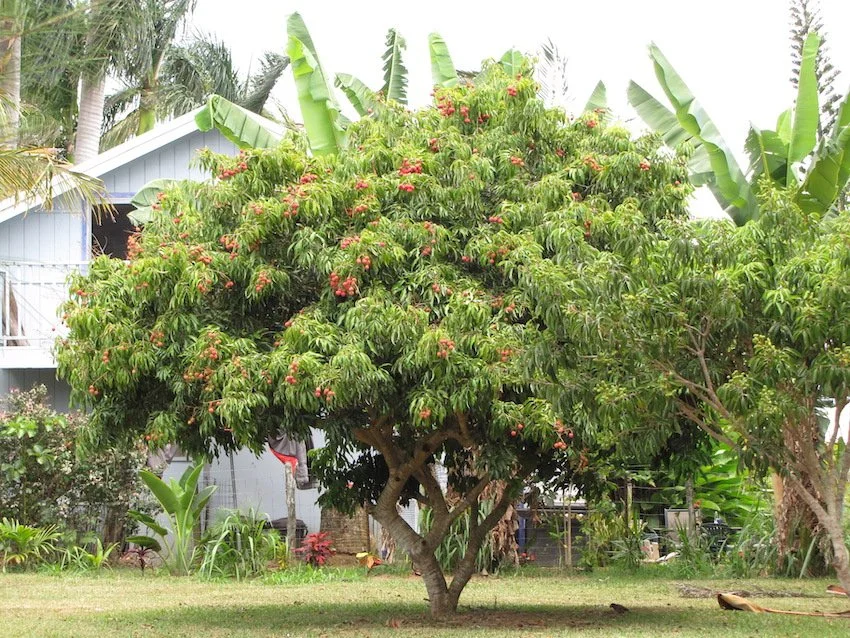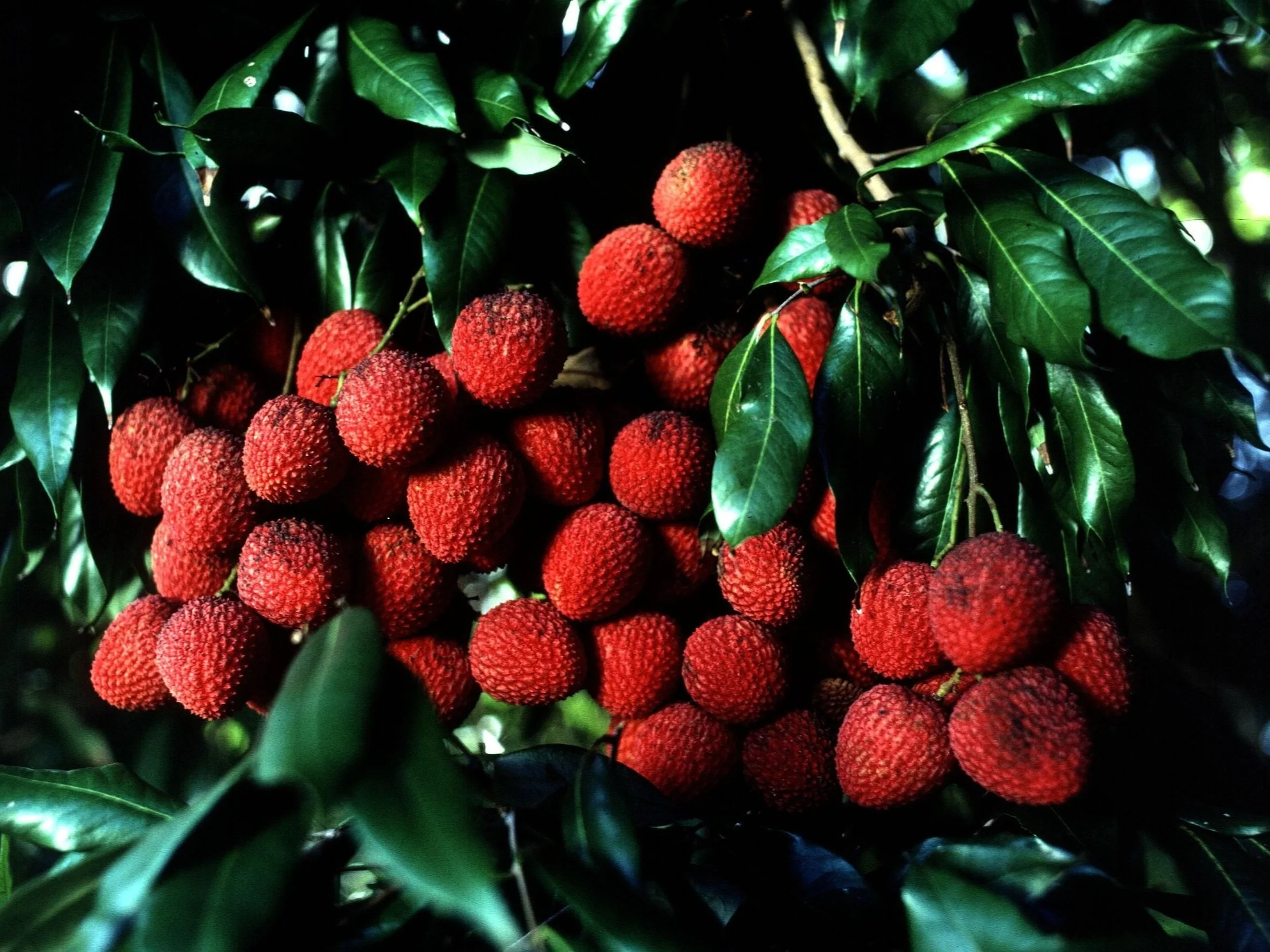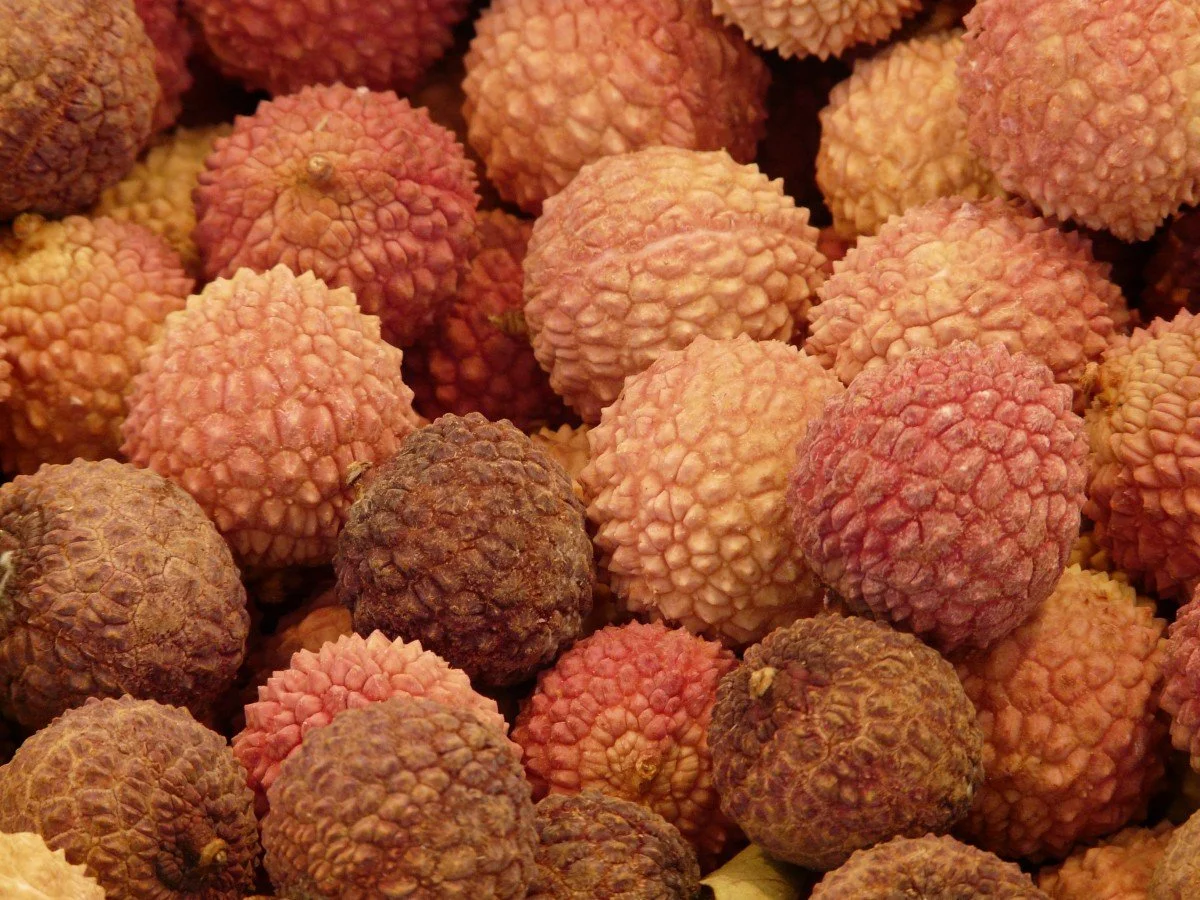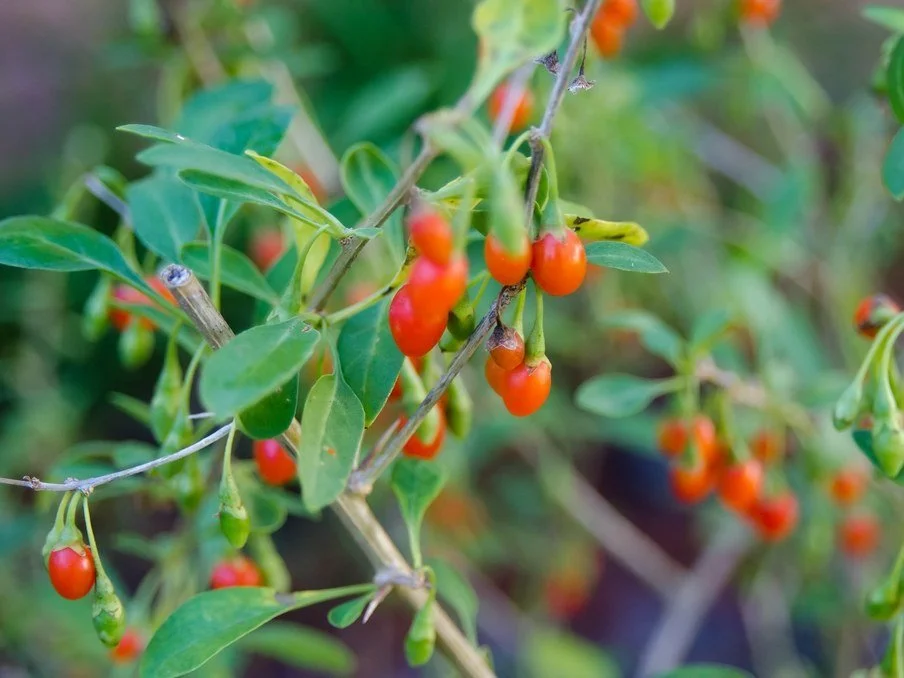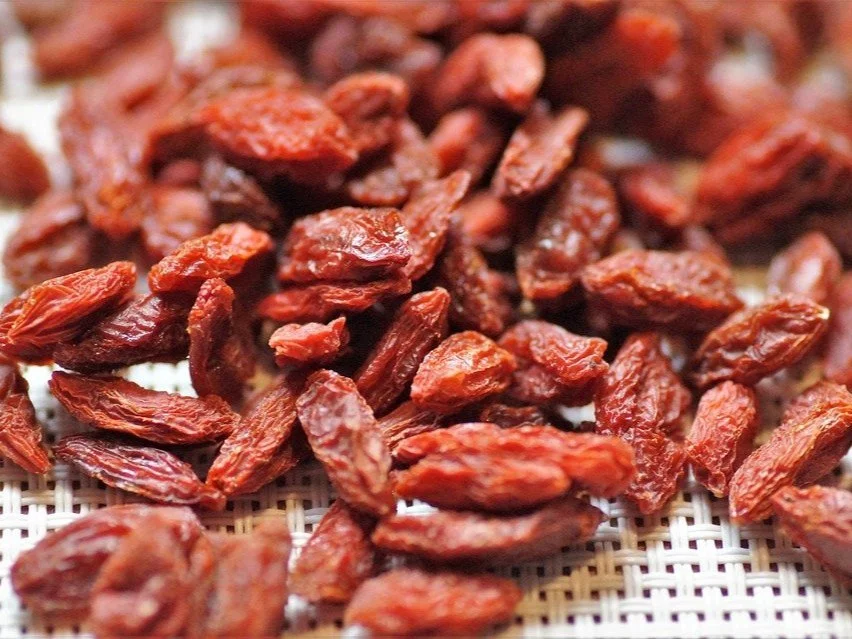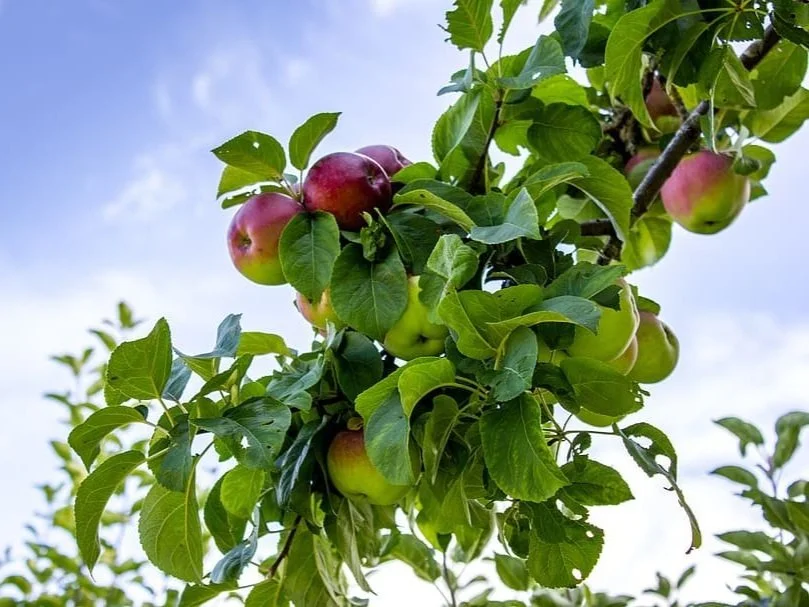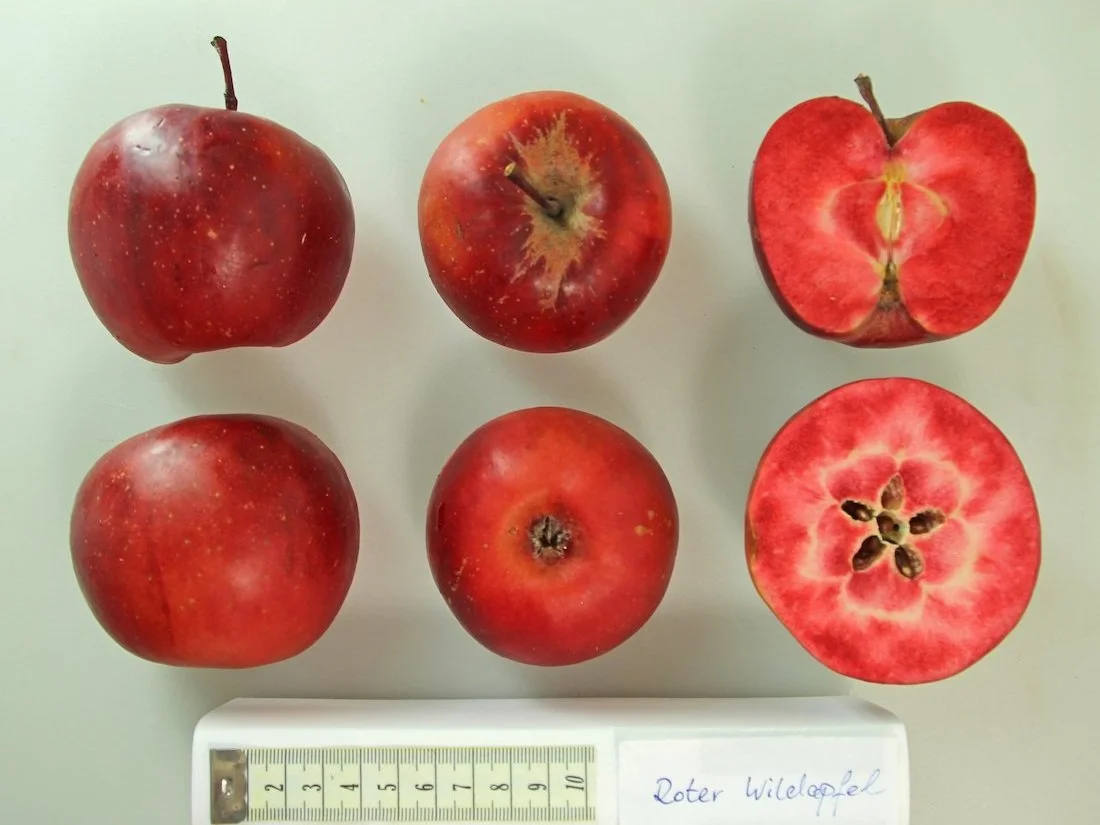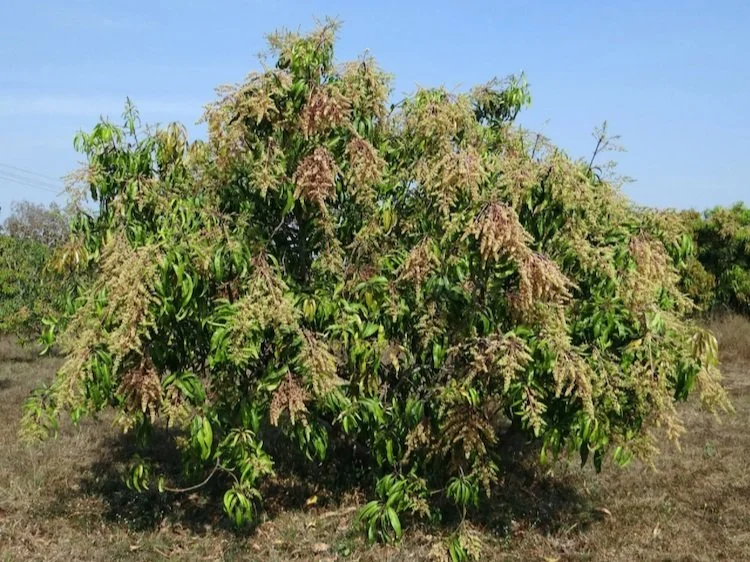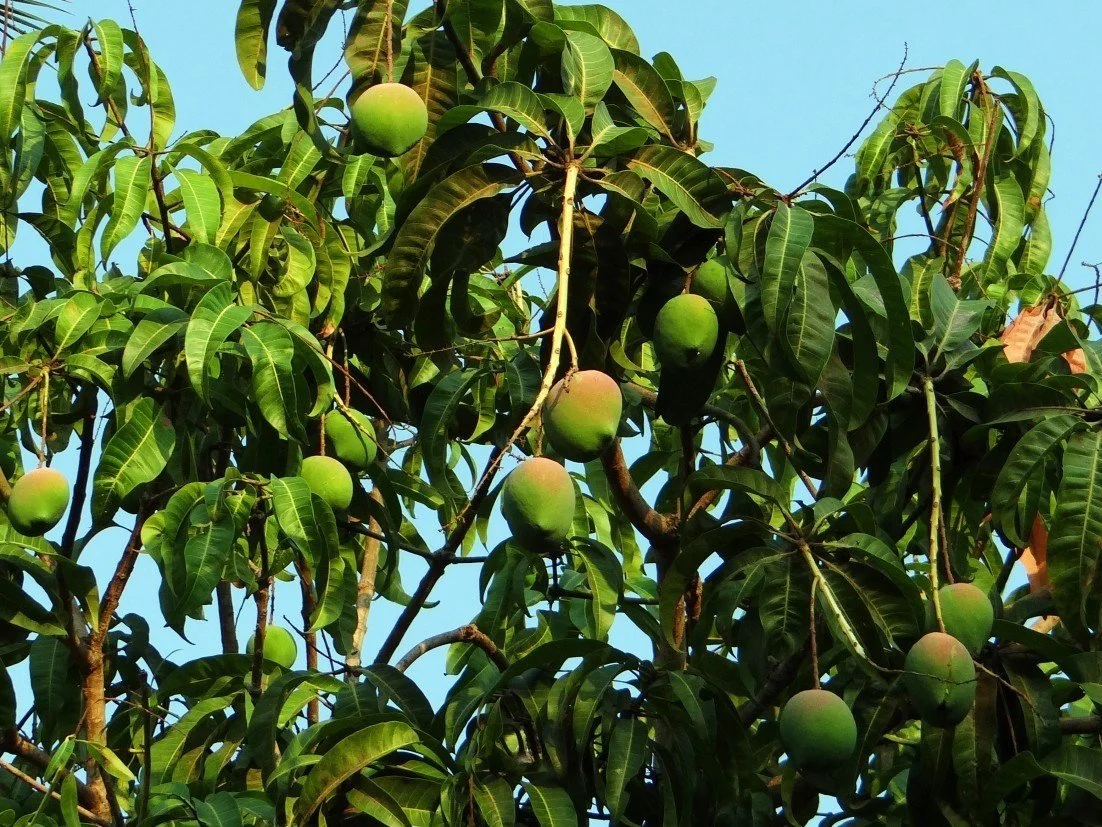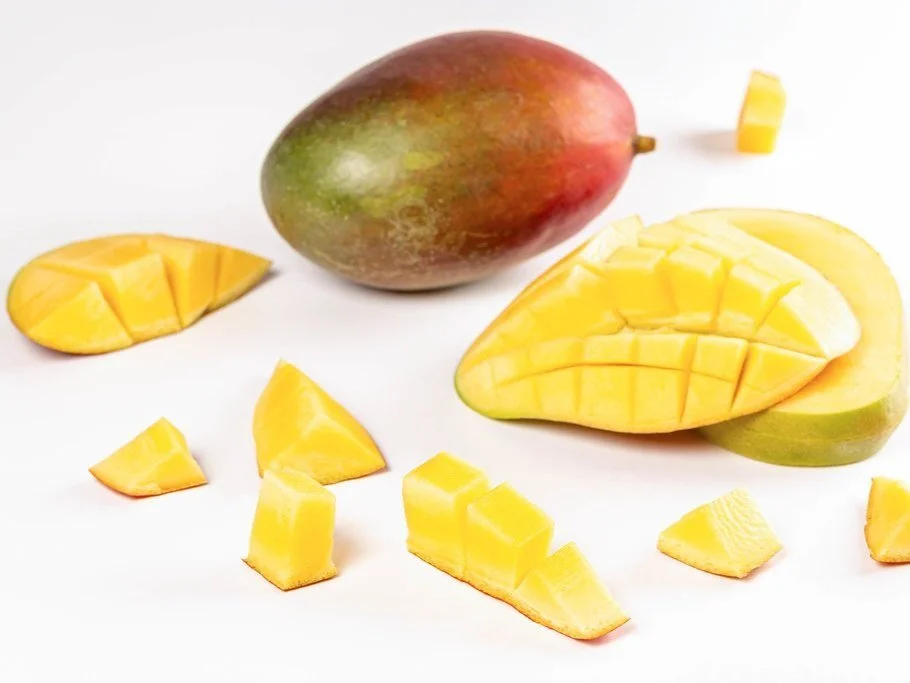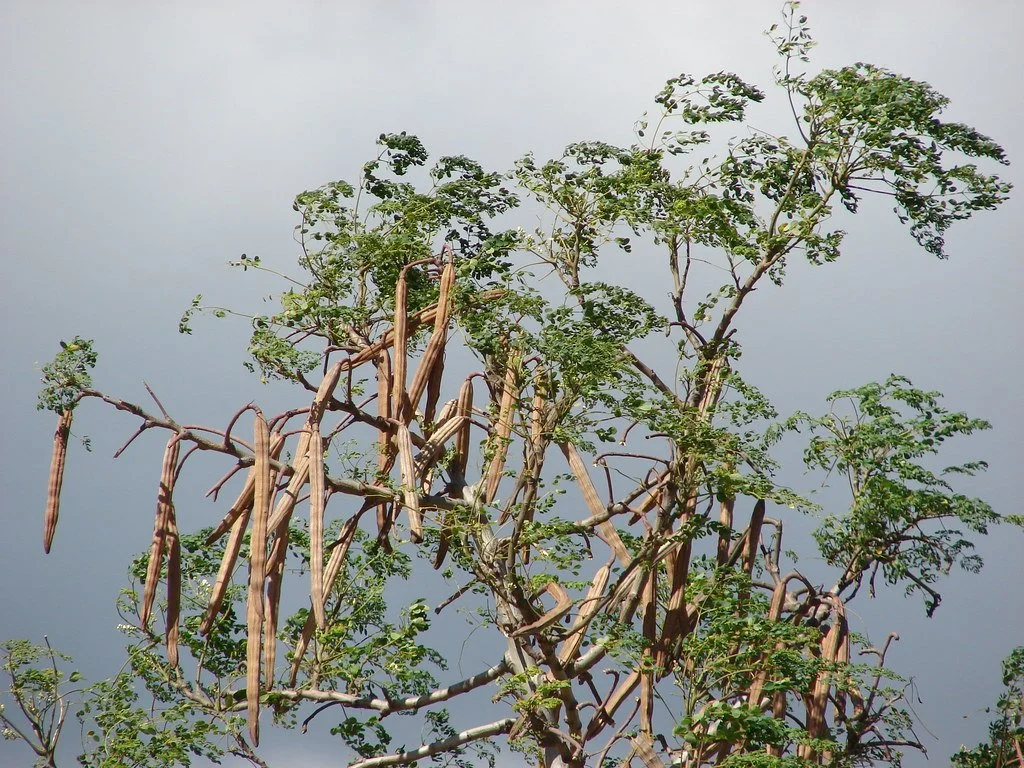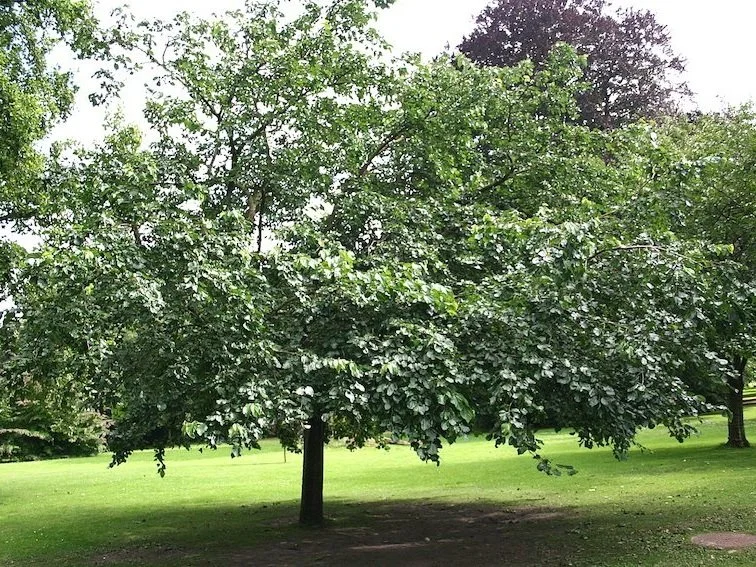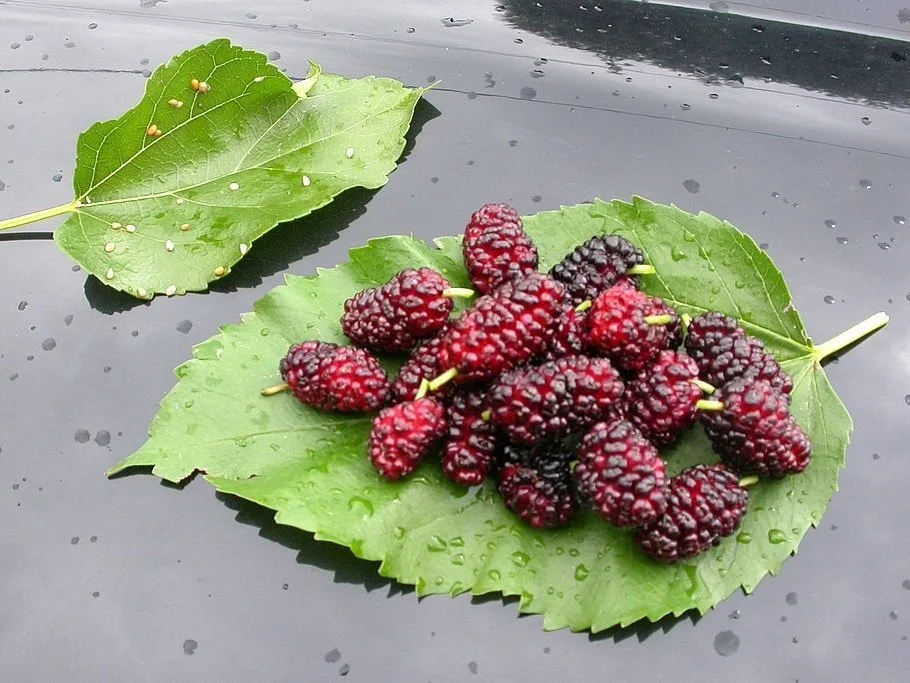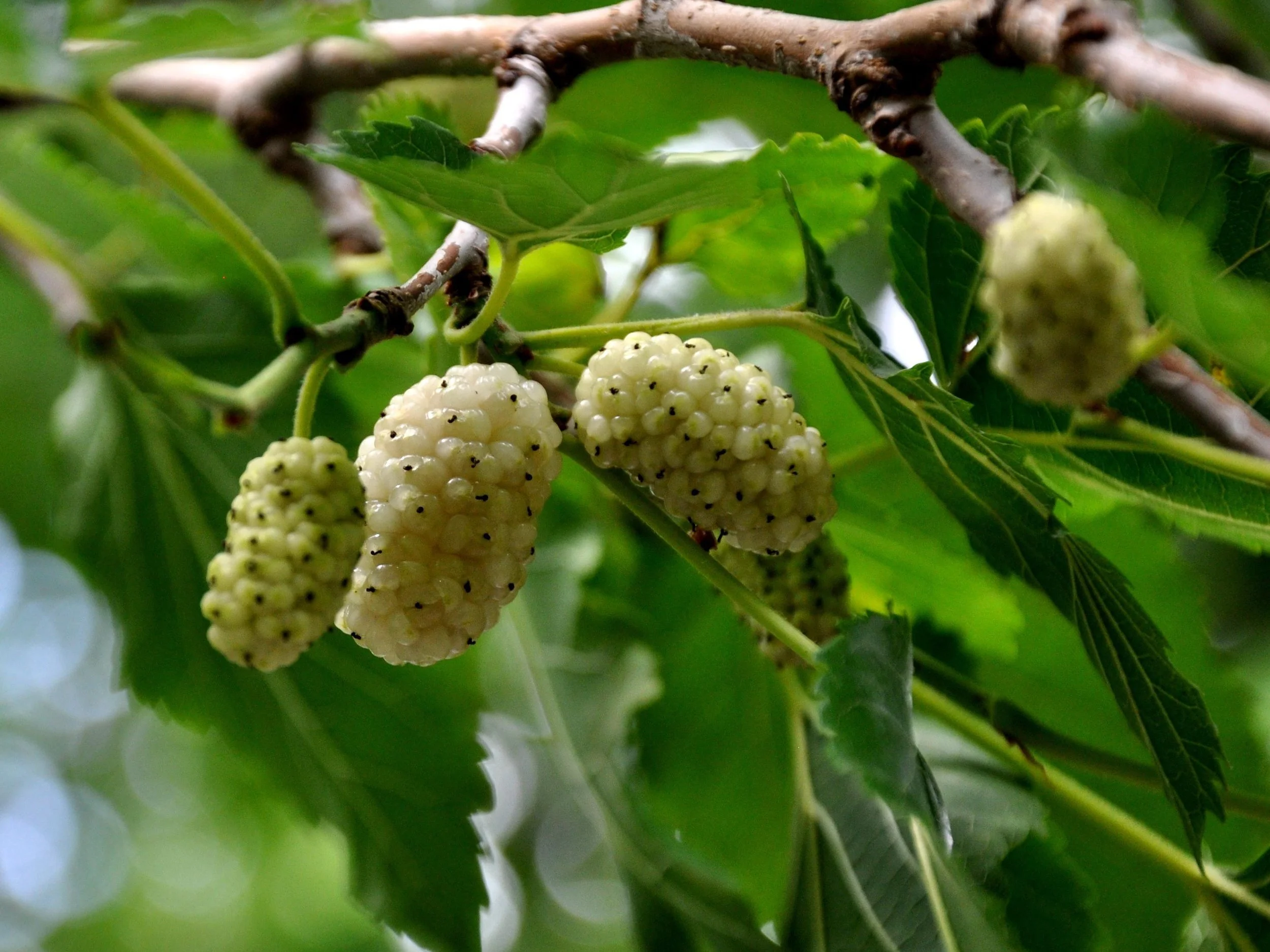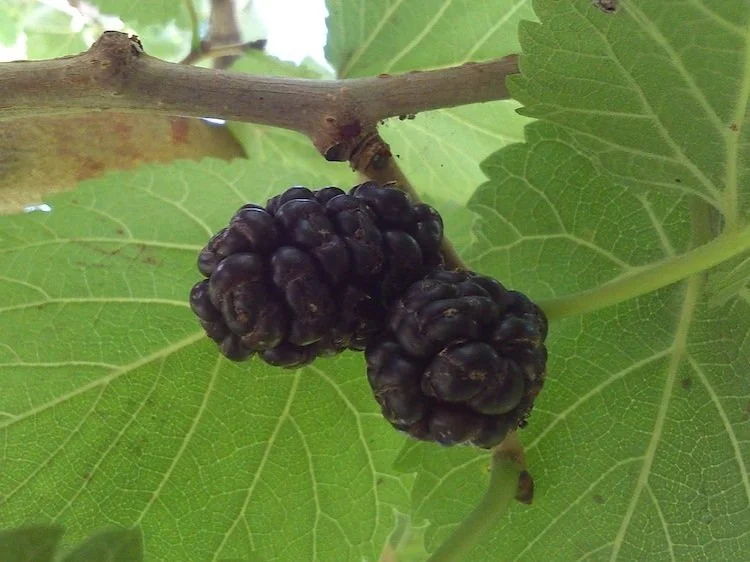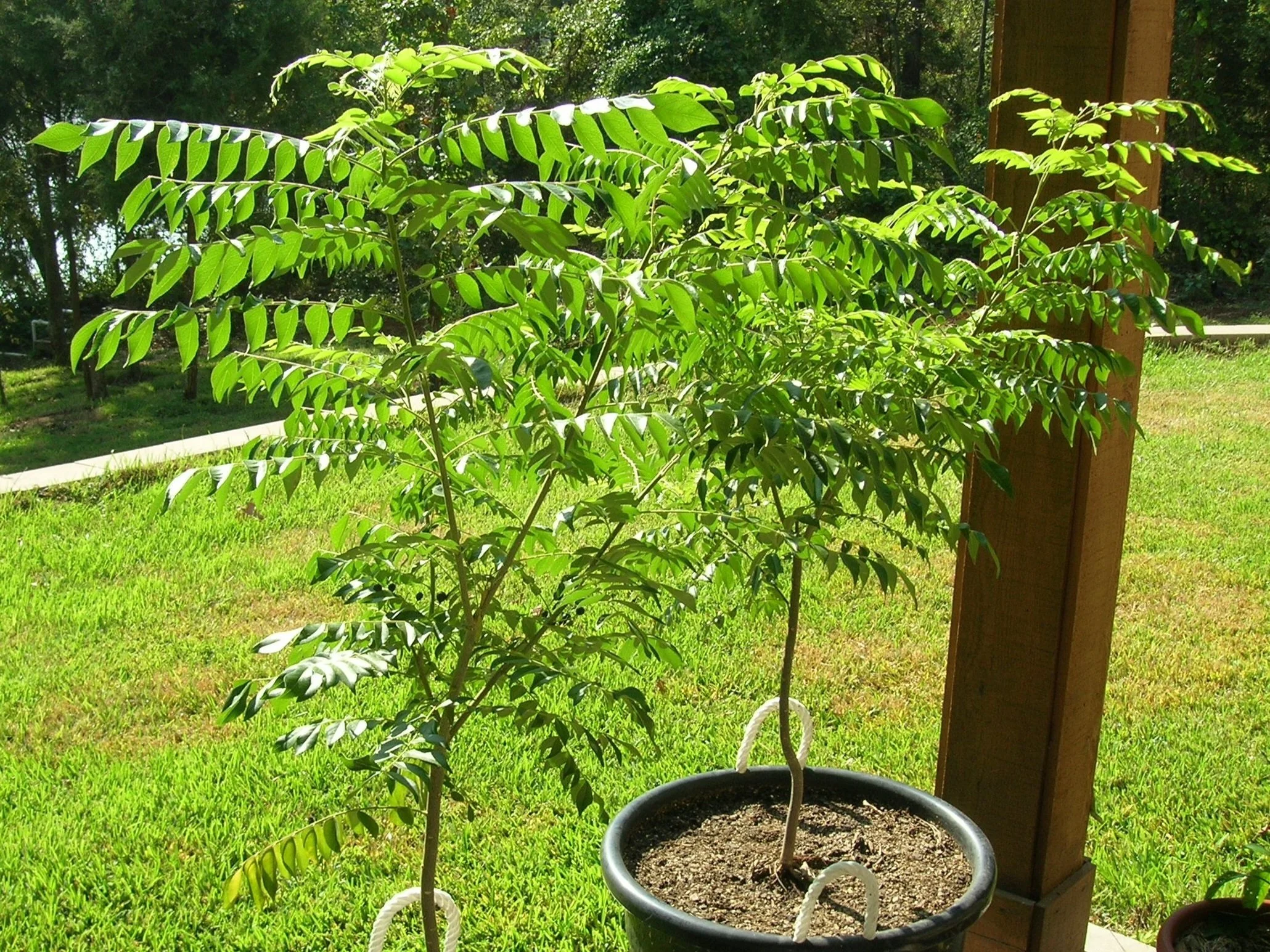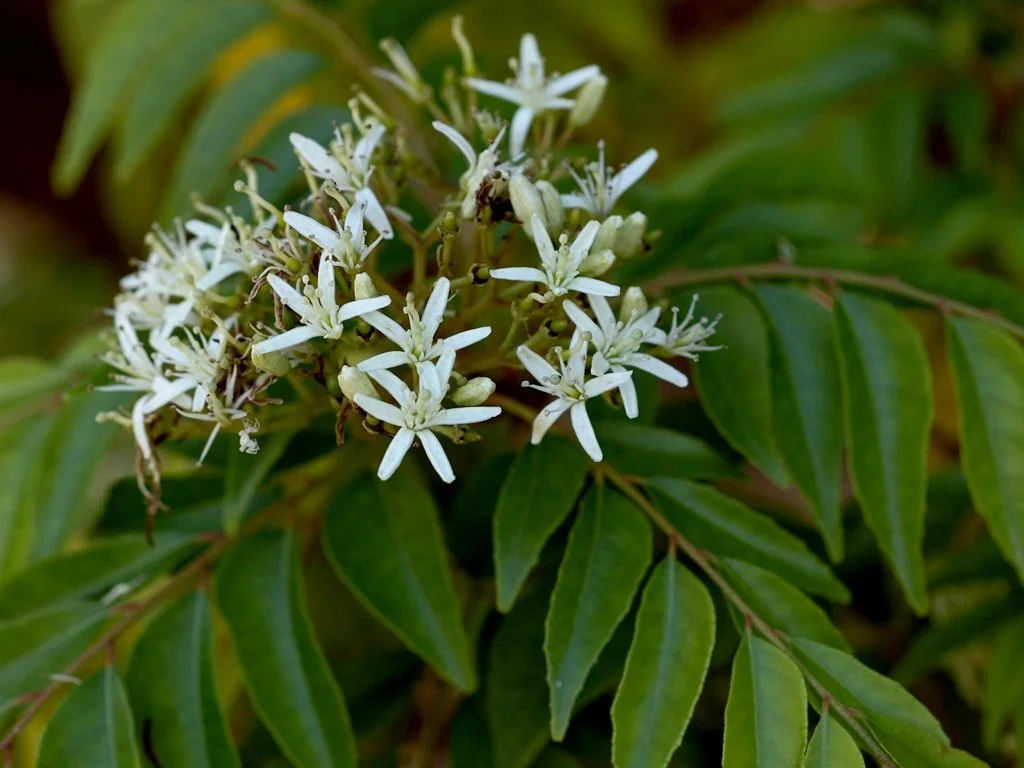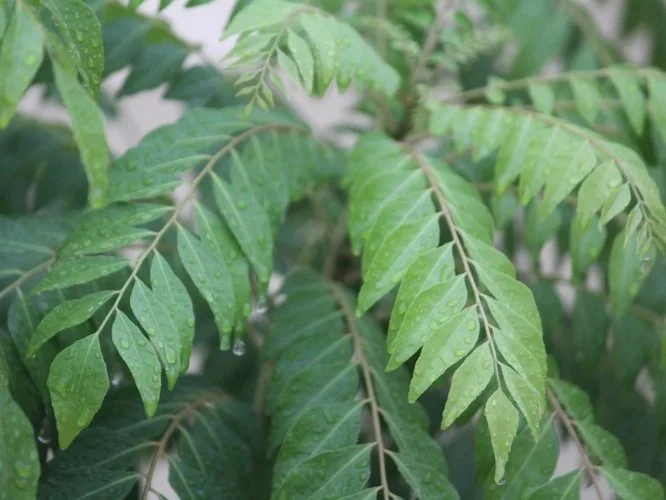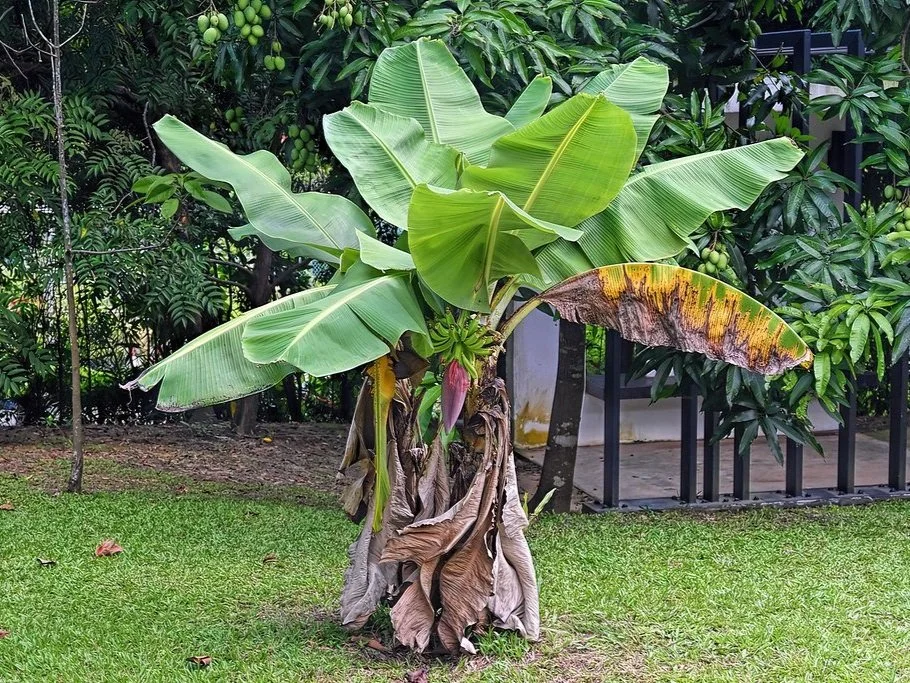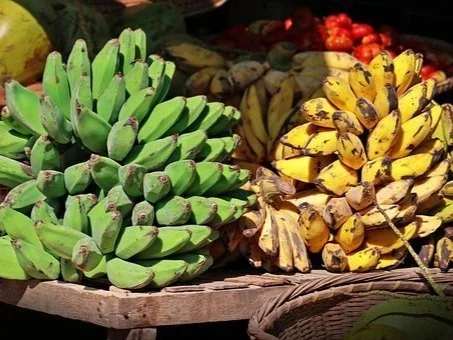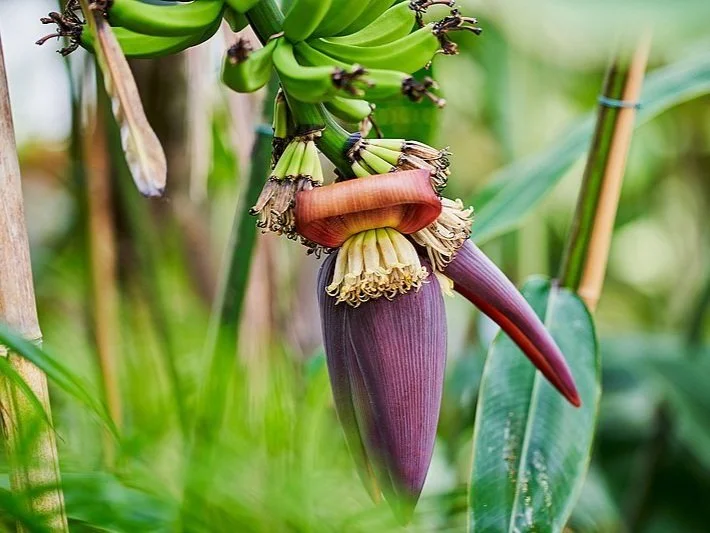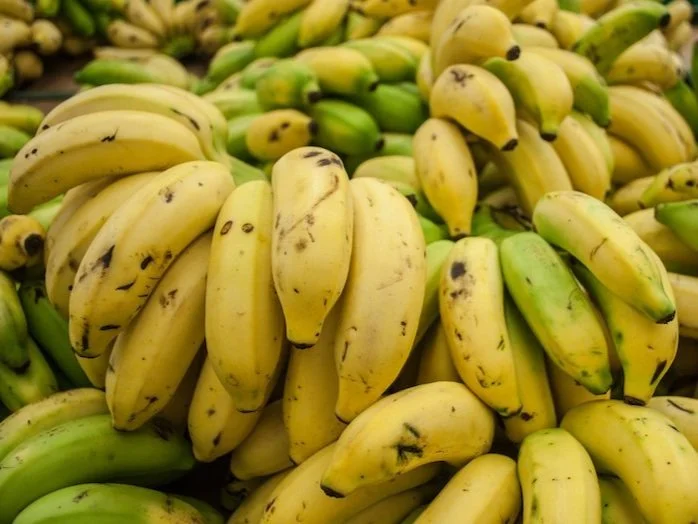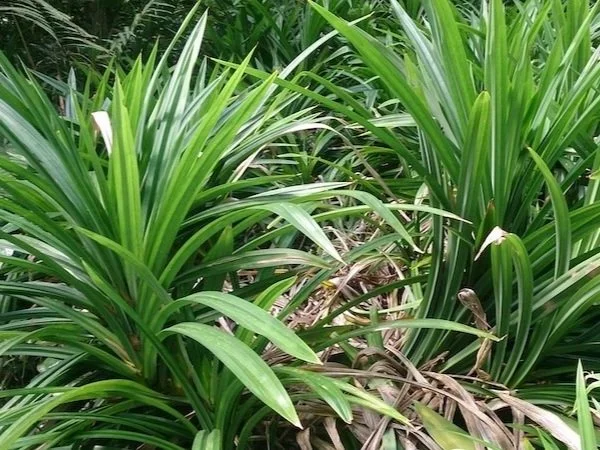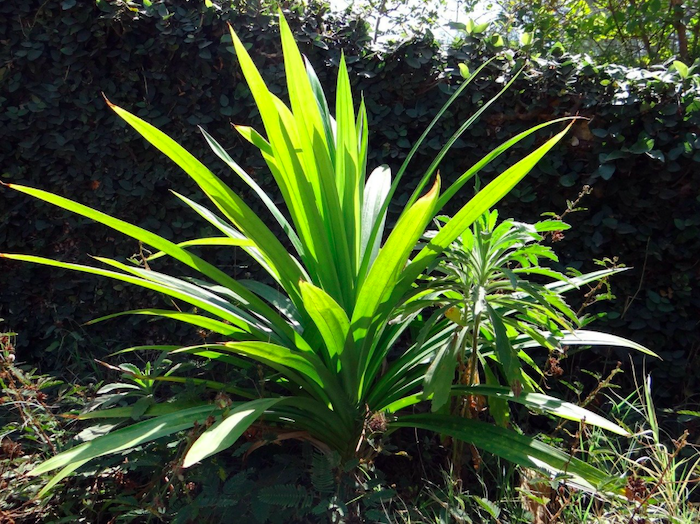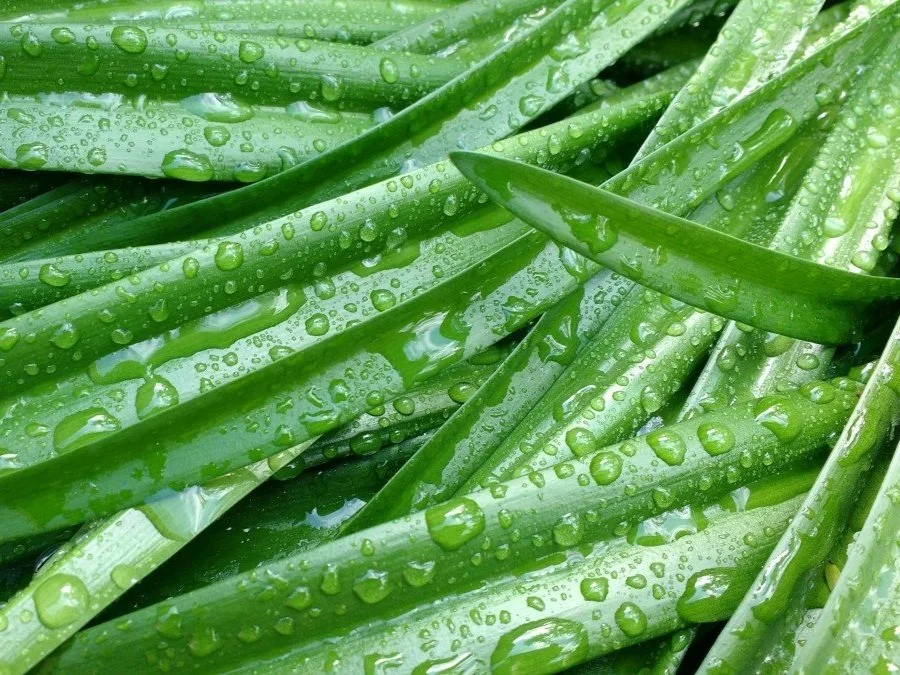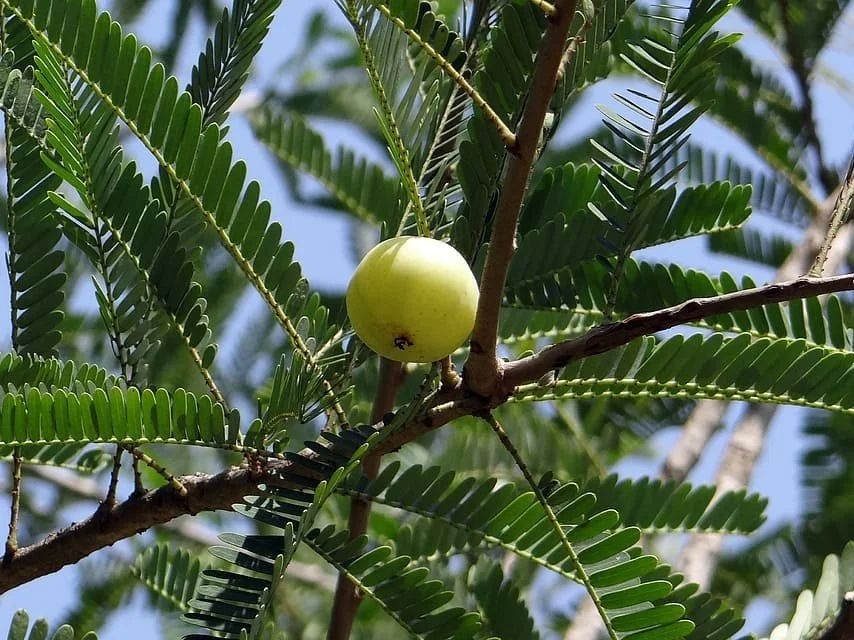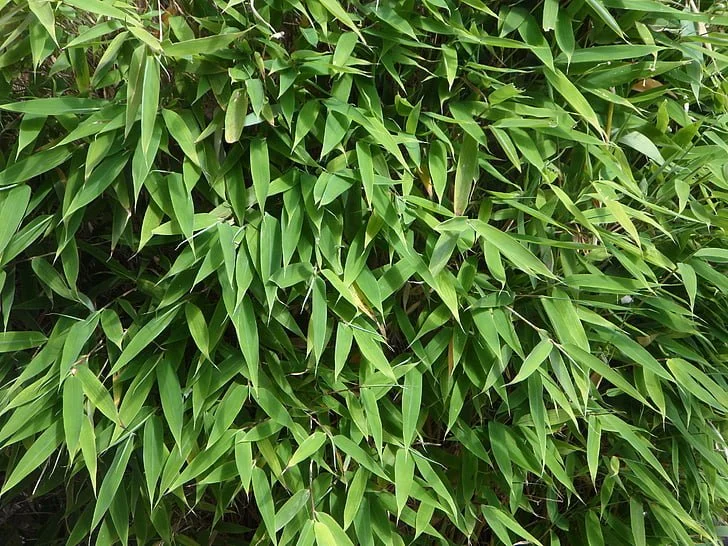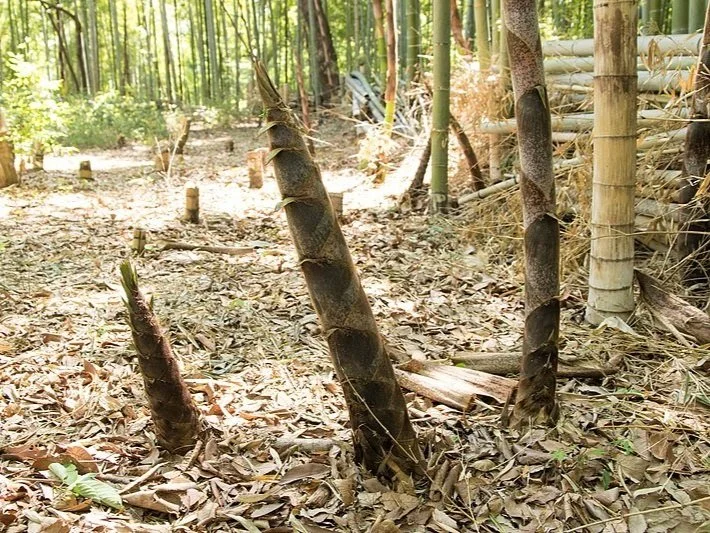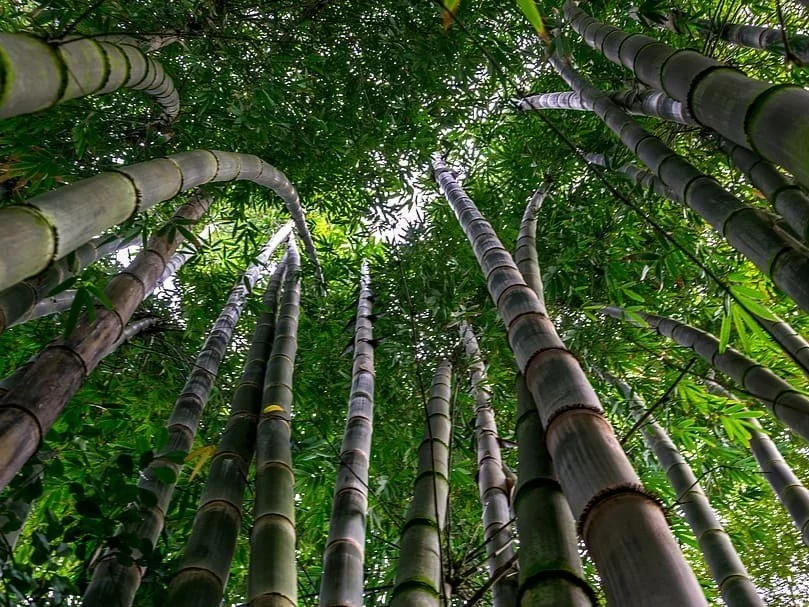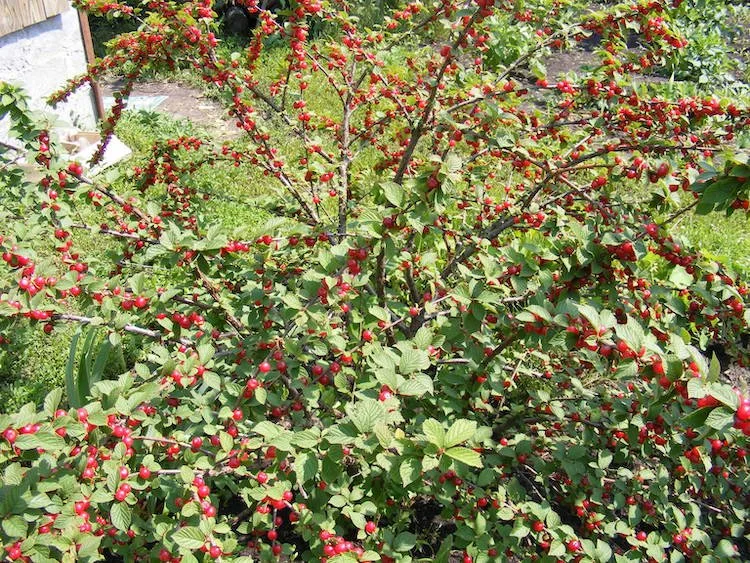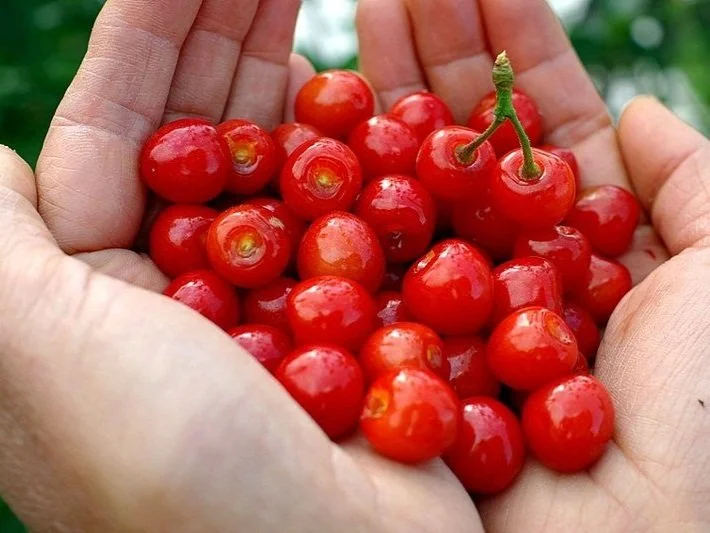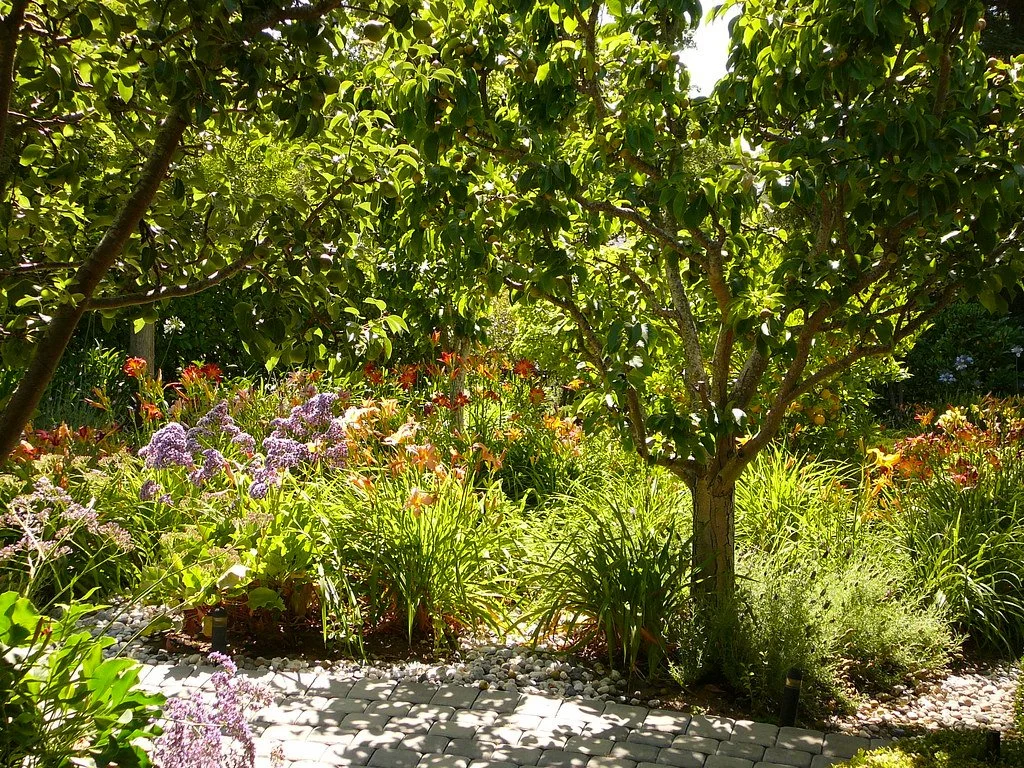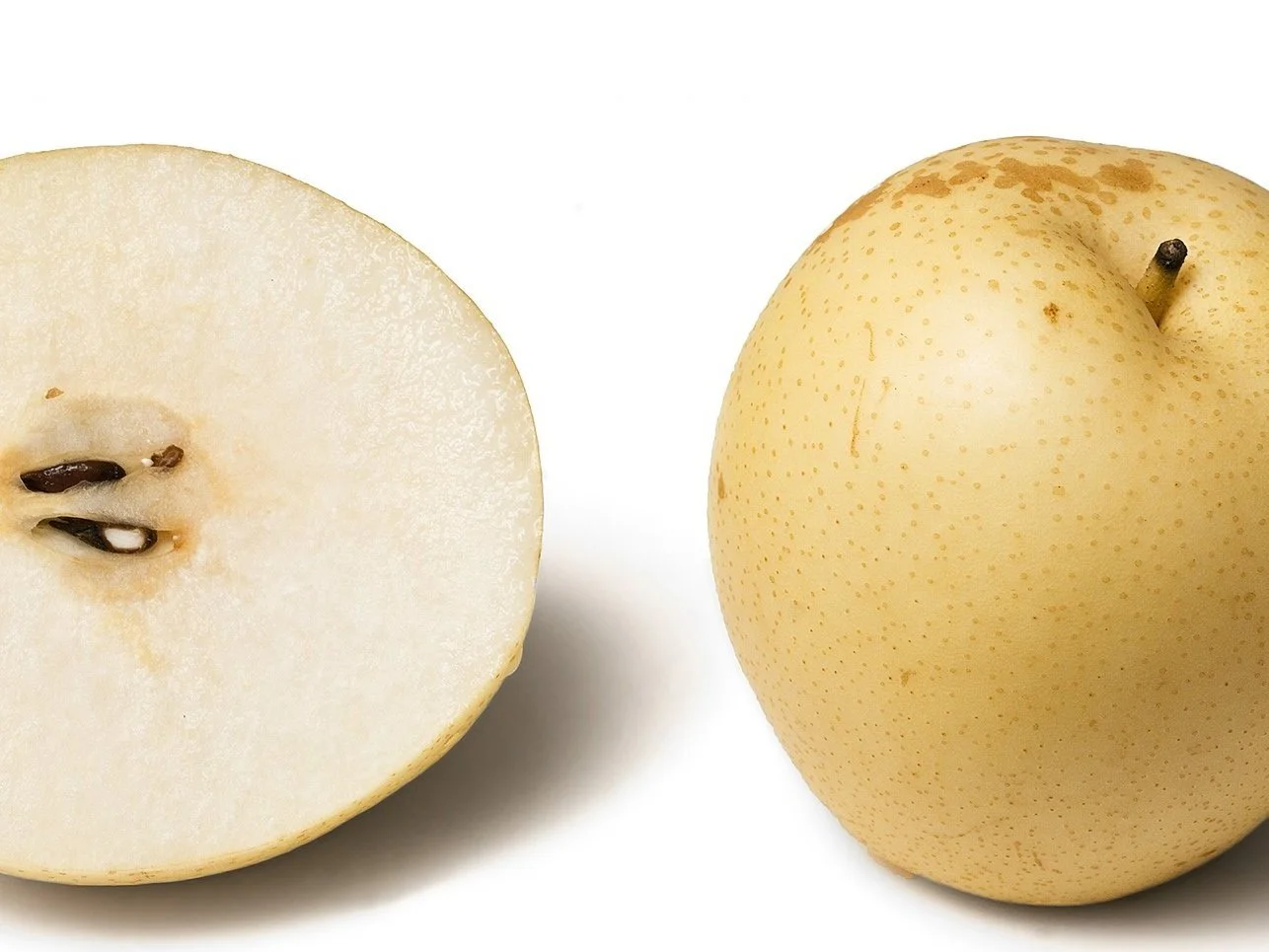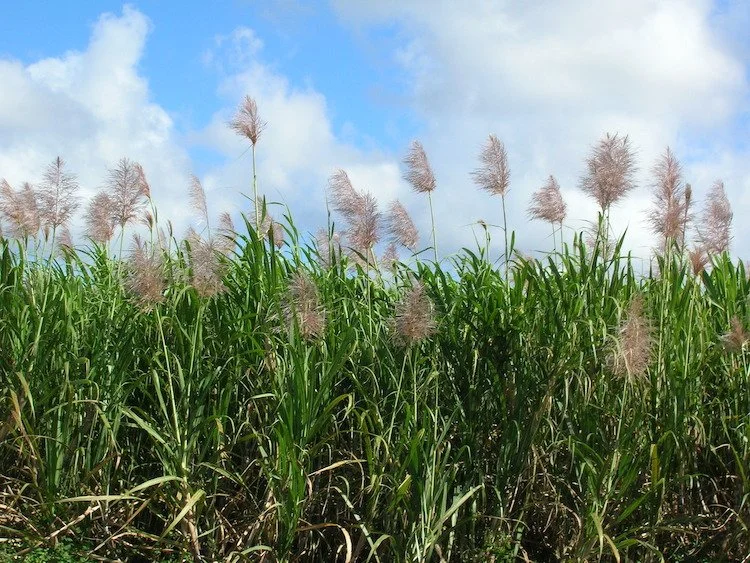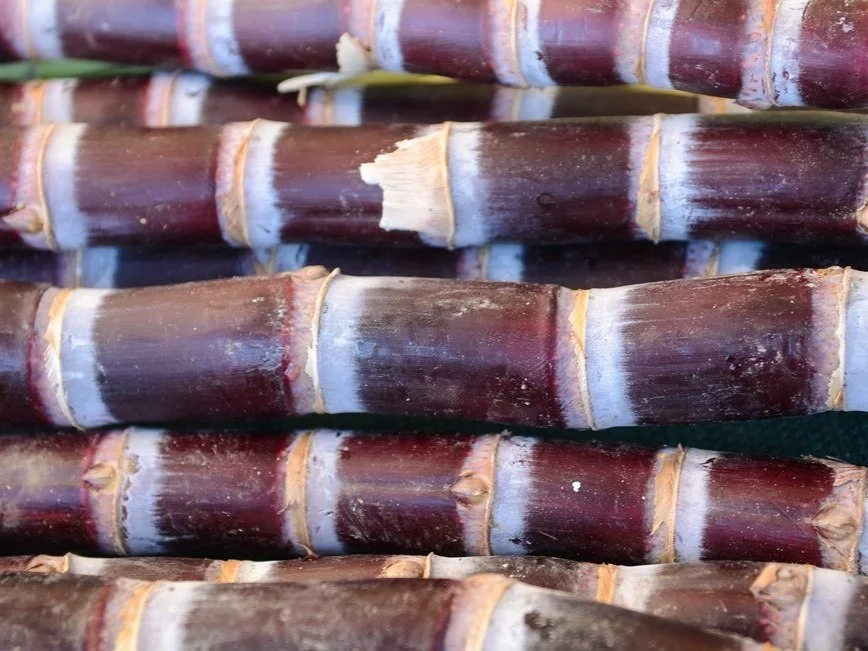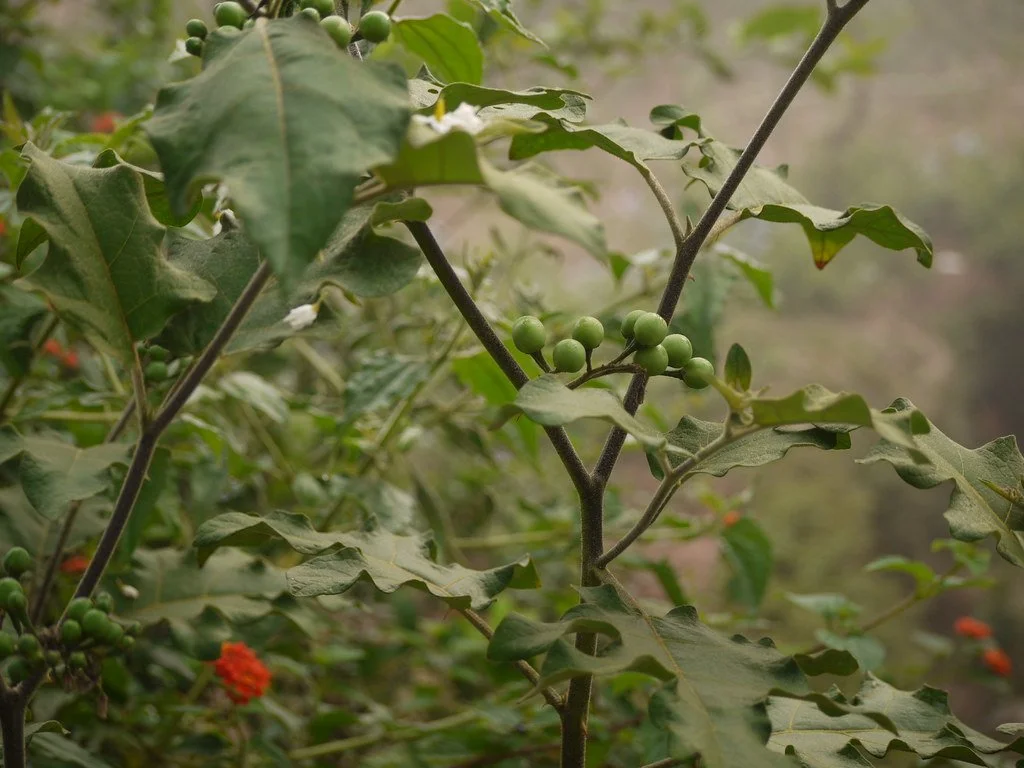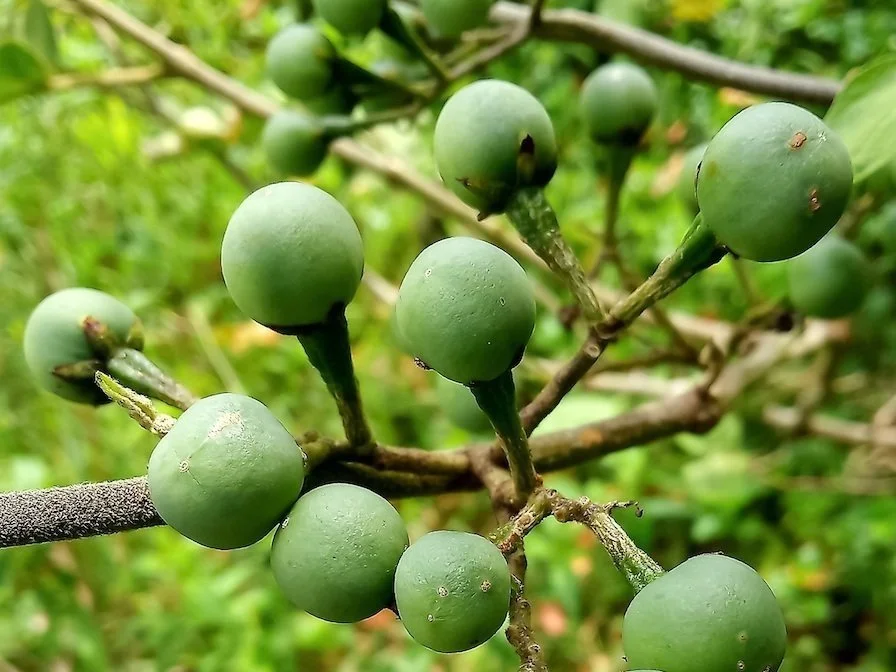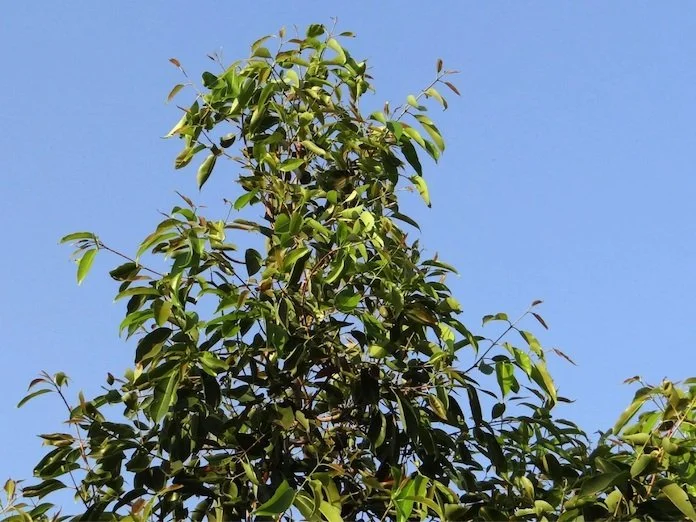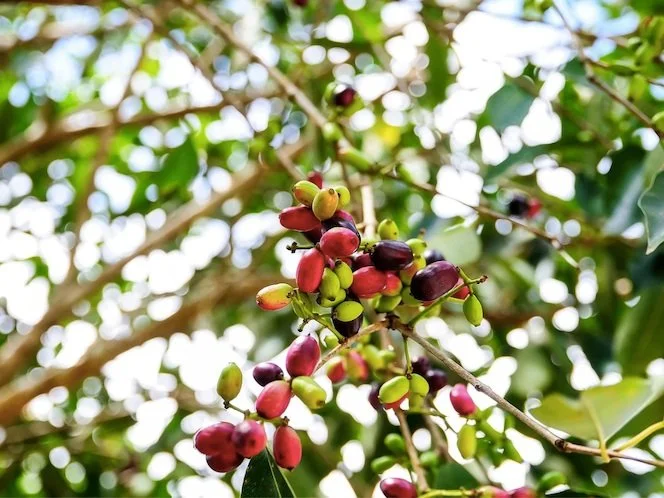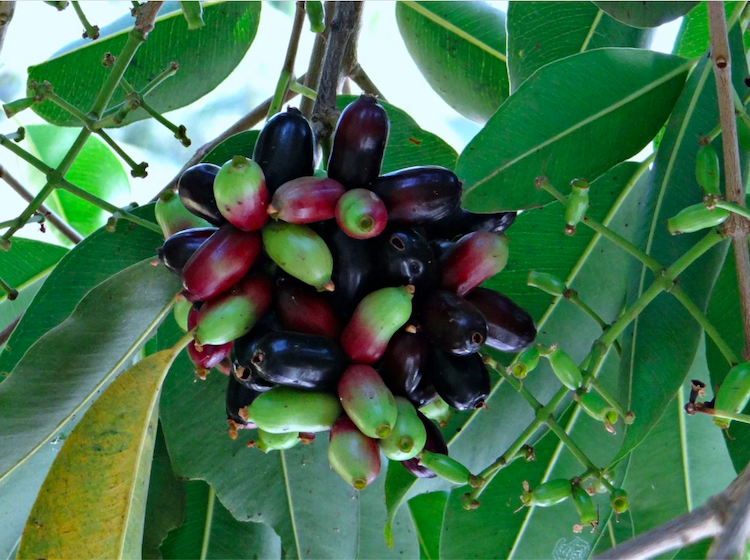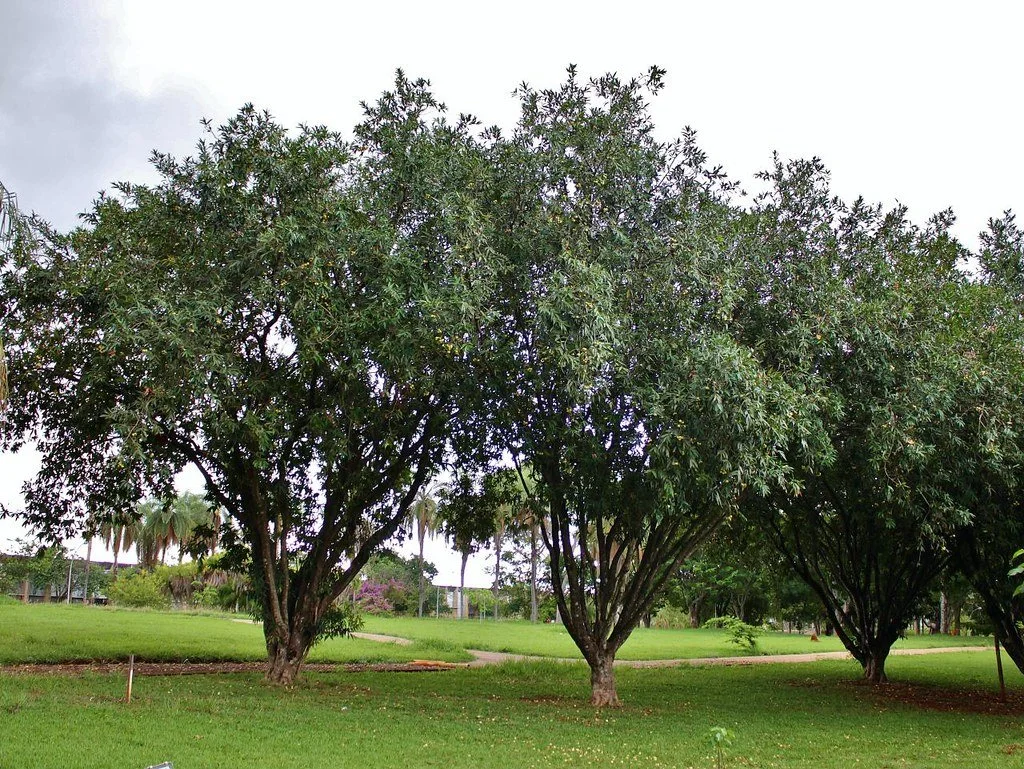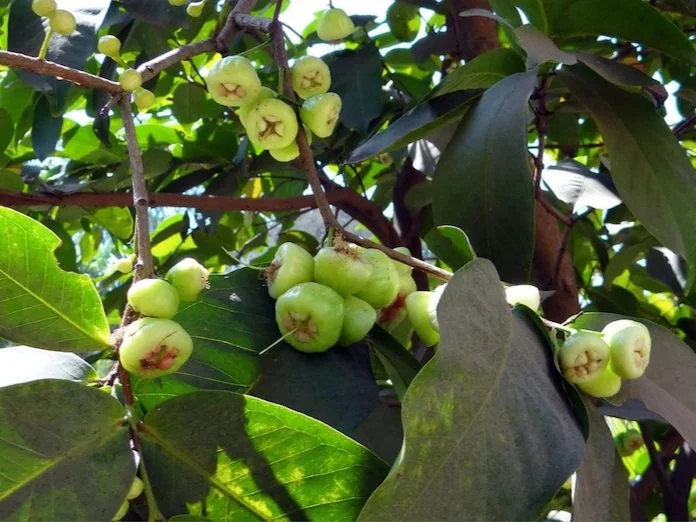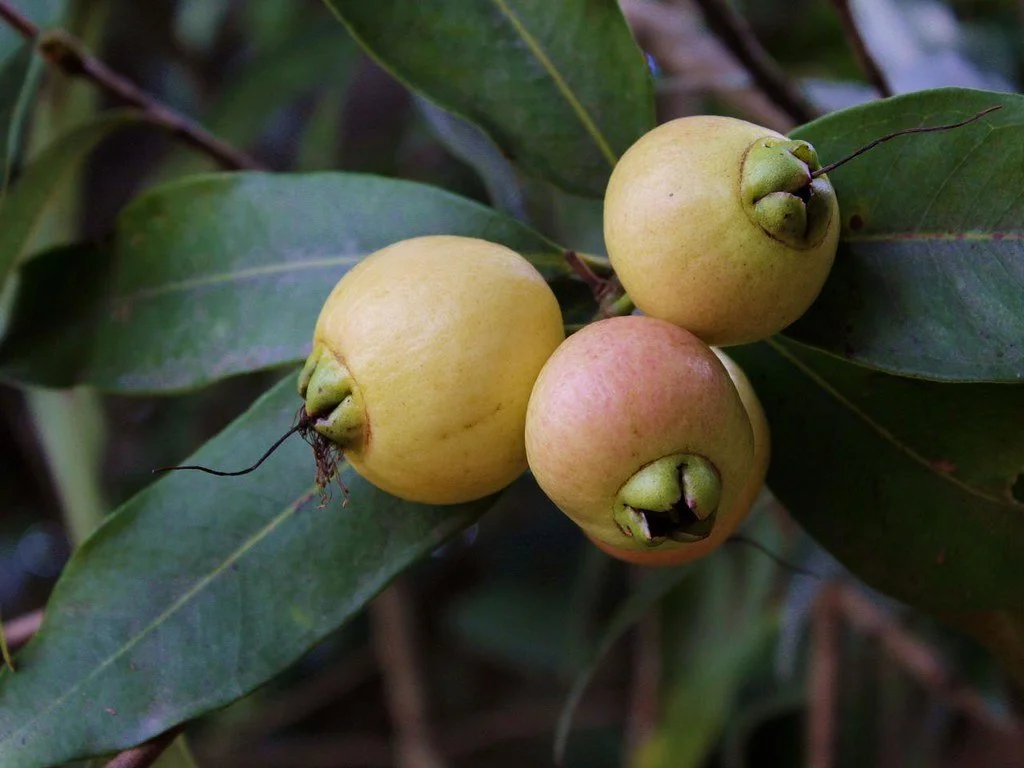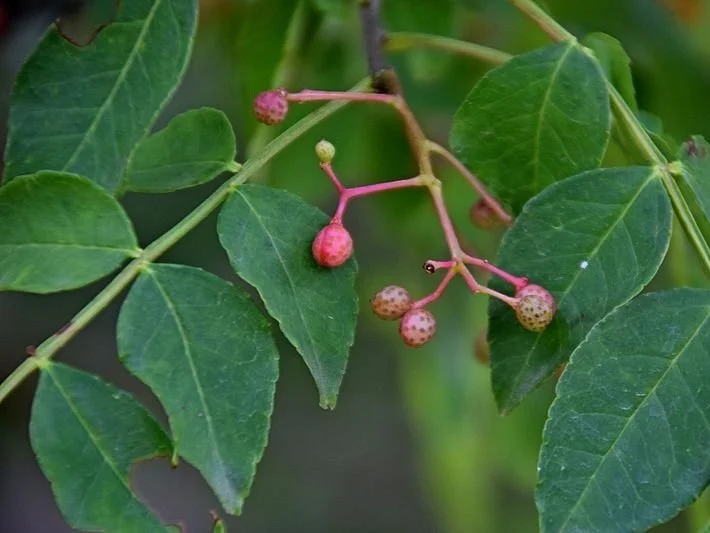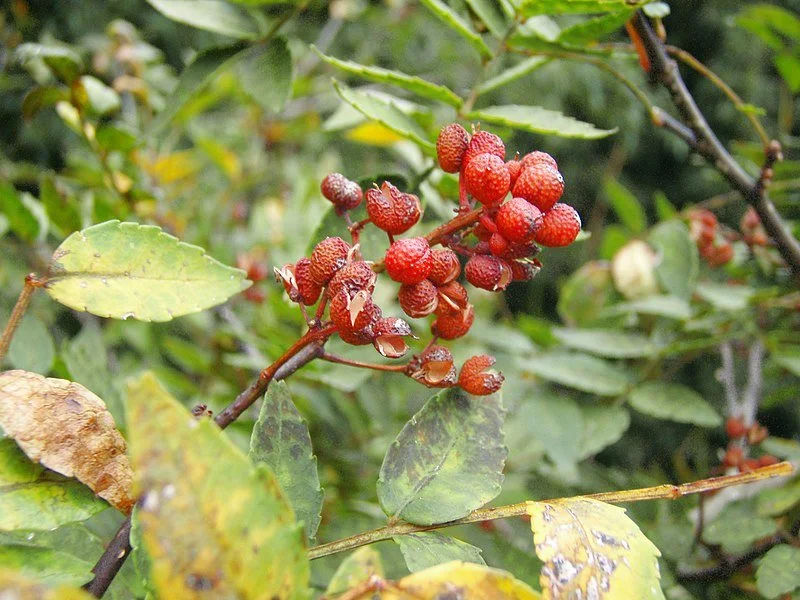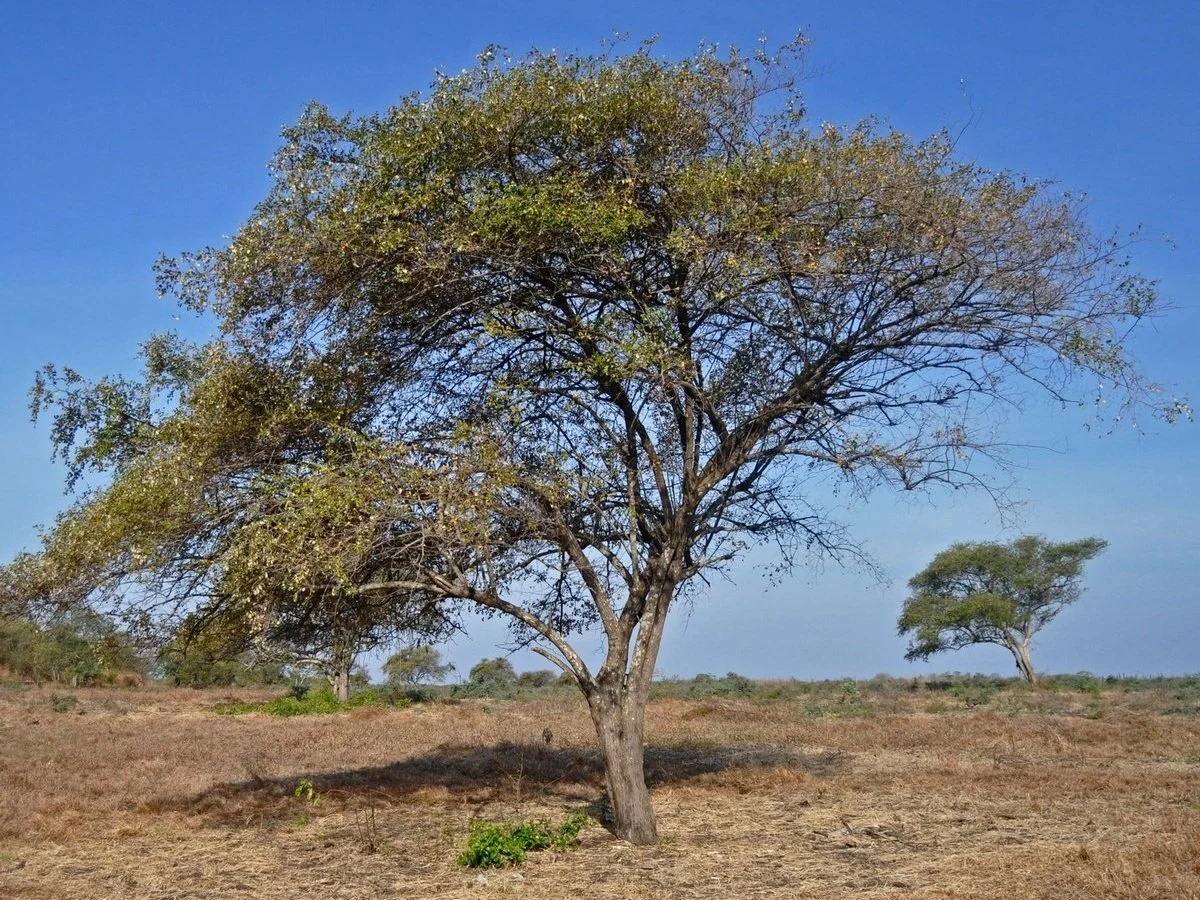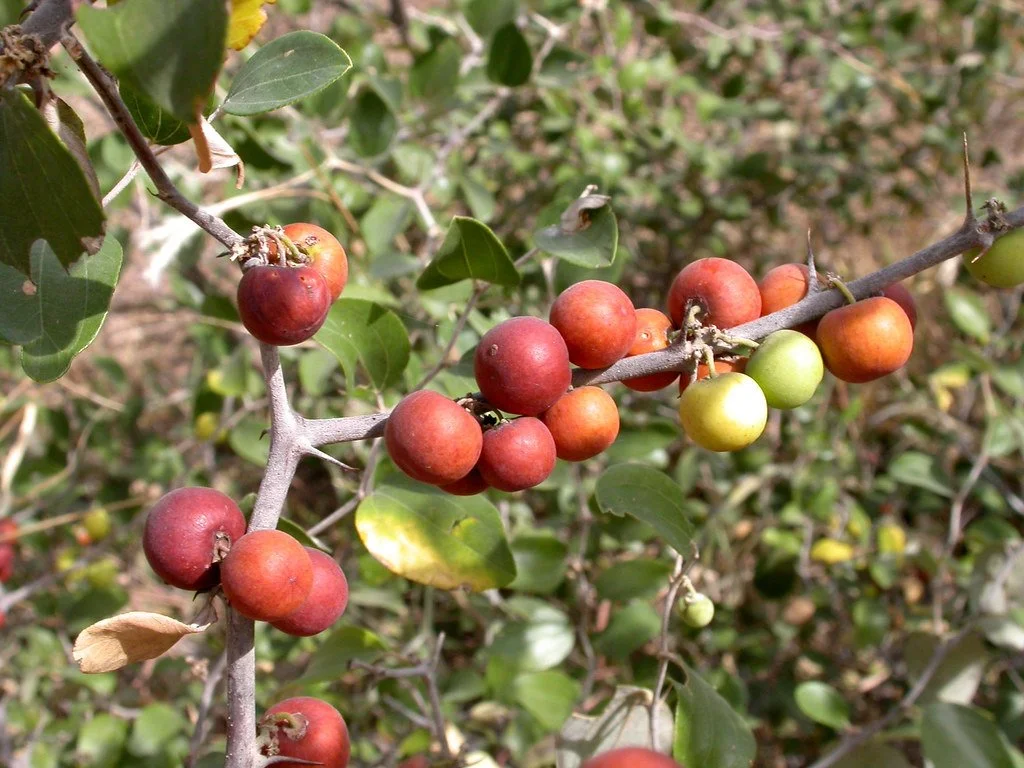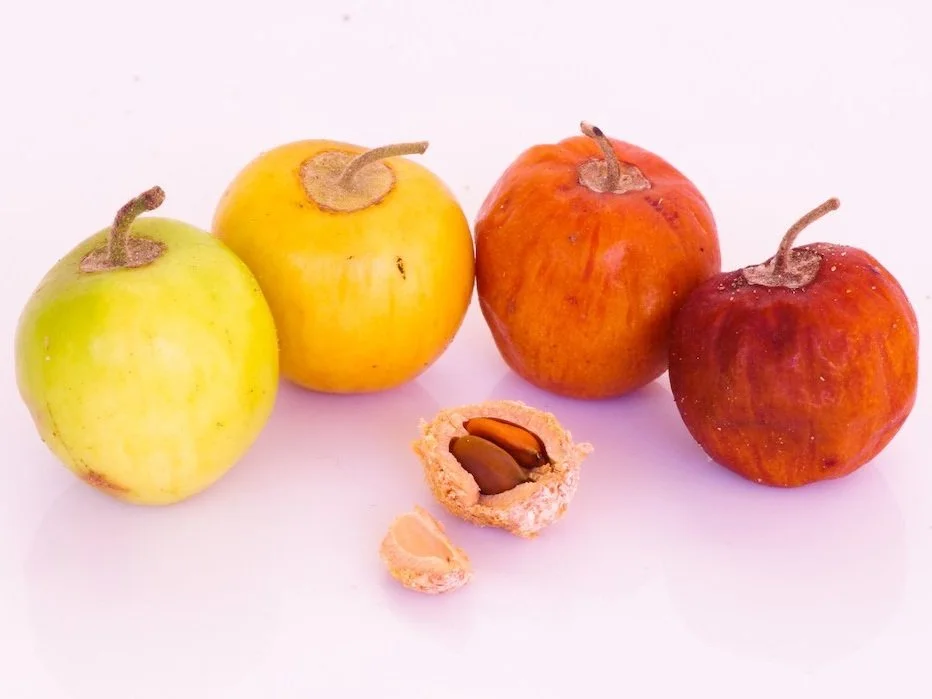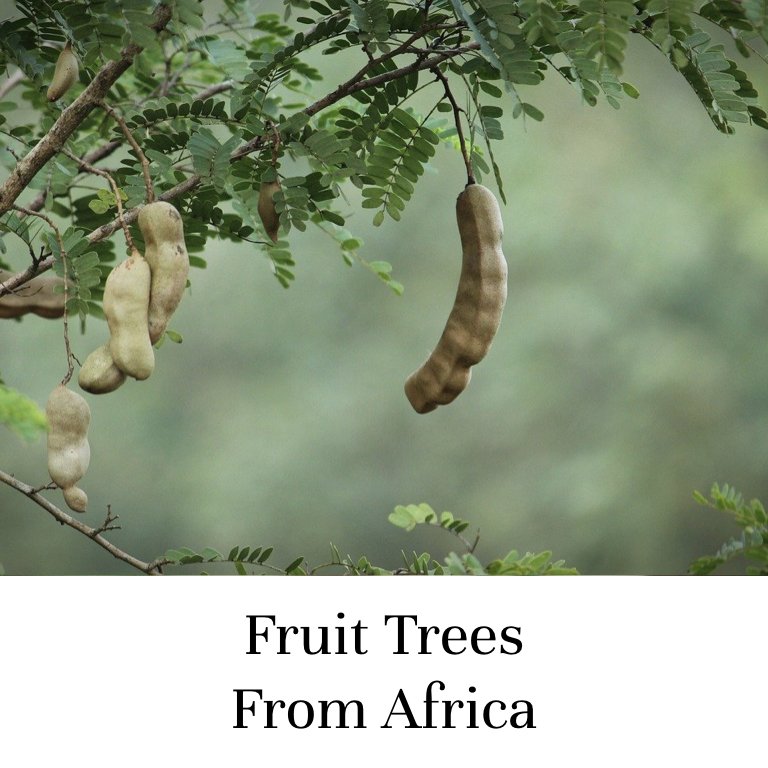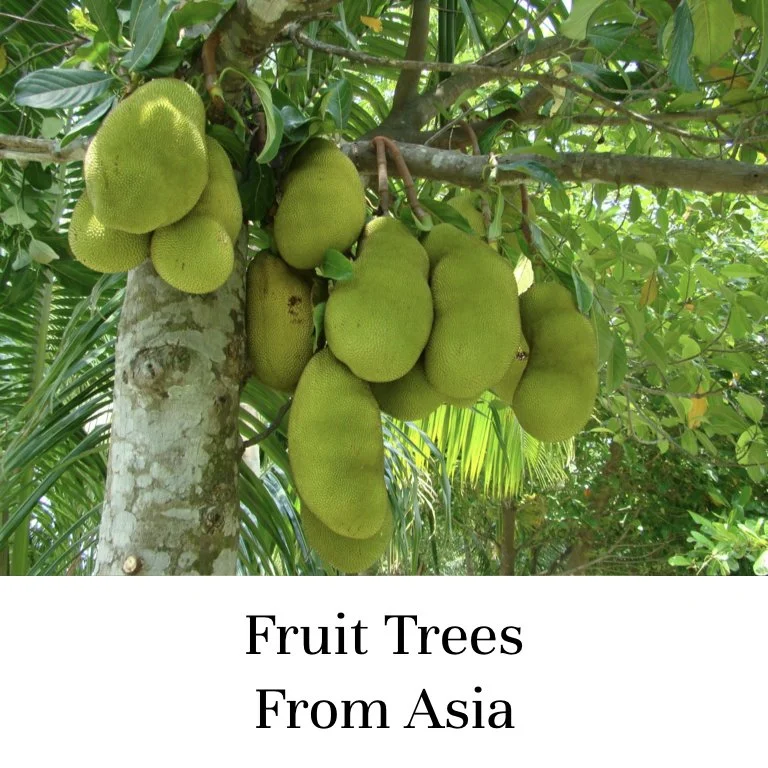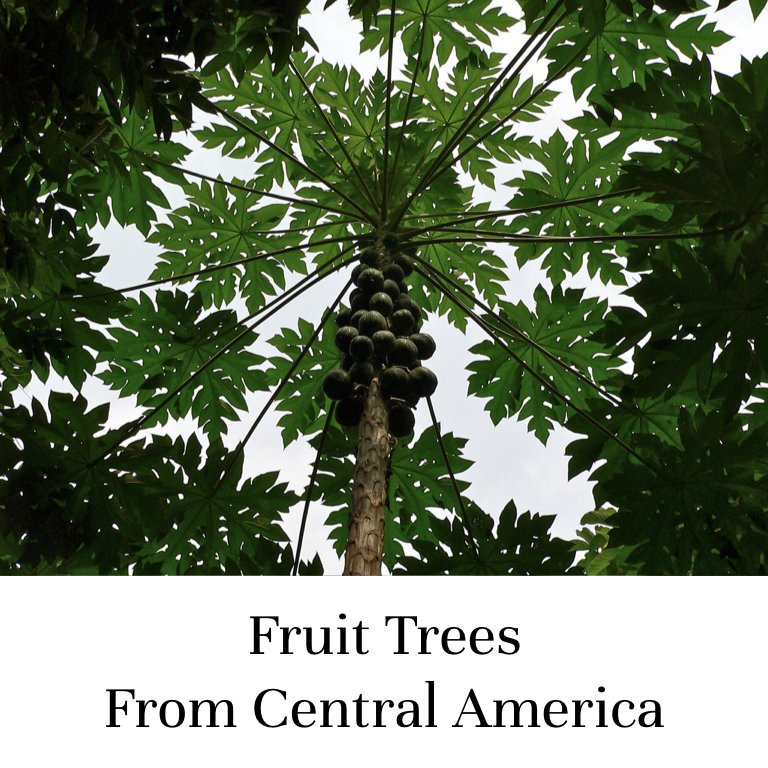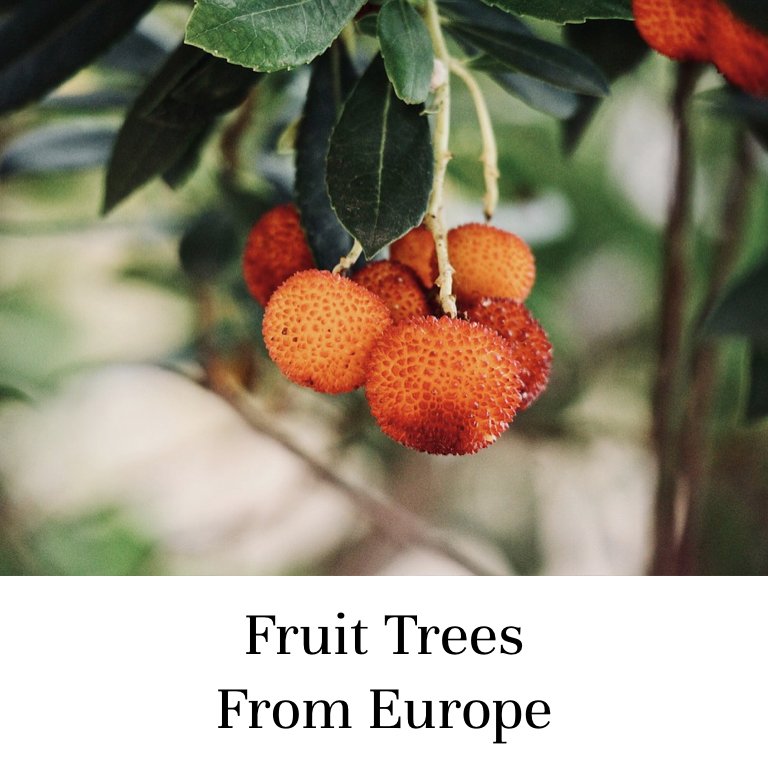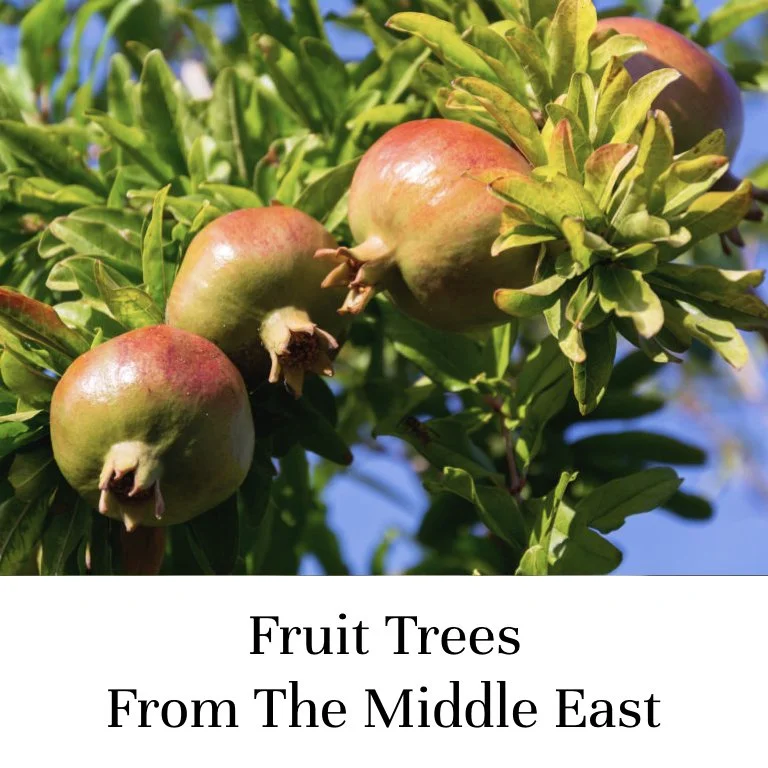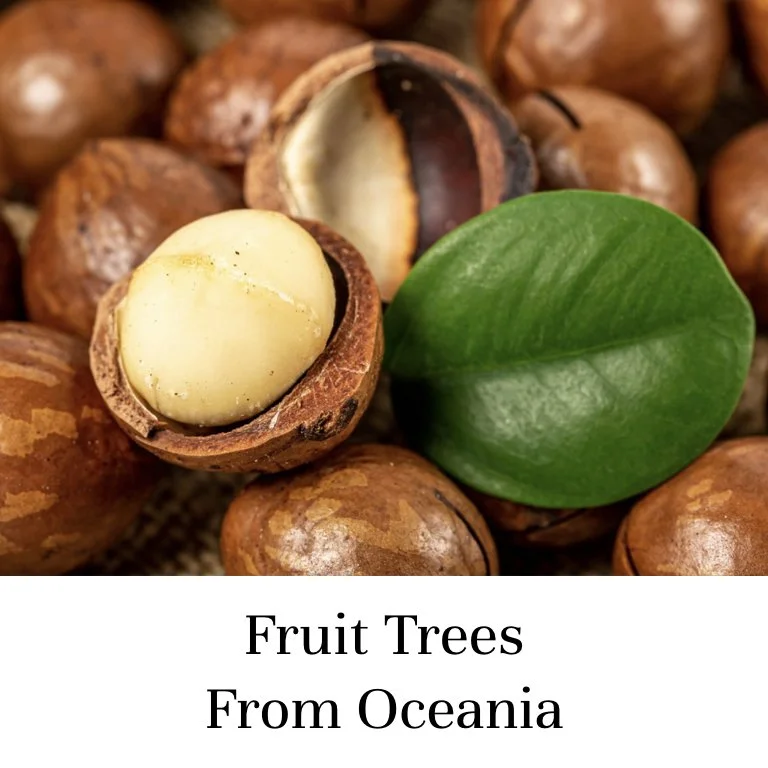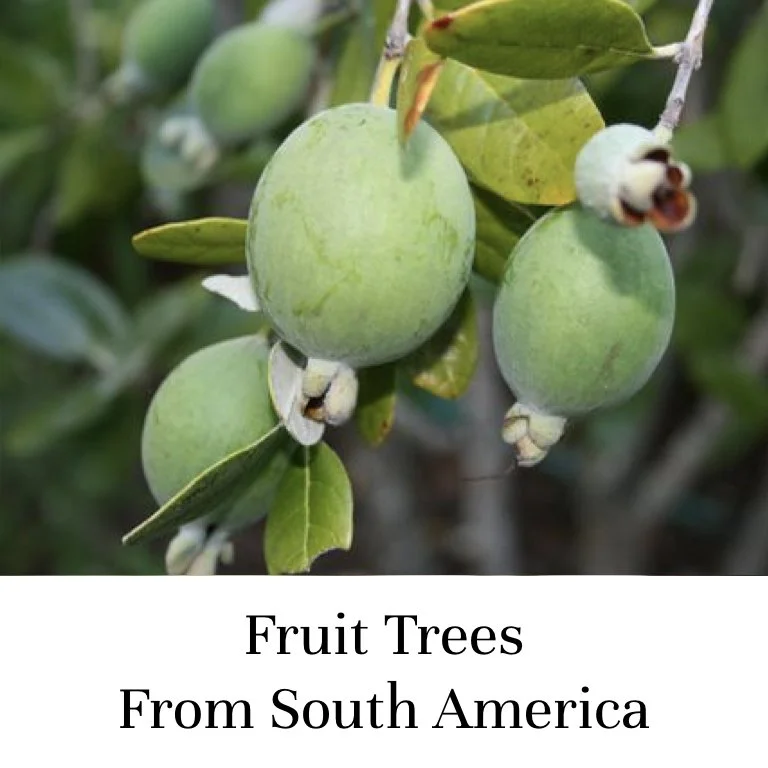Fruit trees from Asia
Join us on an amazing trip to the Asian ‘corner’ of the Orchard and explore the wonderful and diverse edible species to be found there. Learn about their names, varieties and edibility purposes.
If you wish to know more about each of the many many different species and varieties present at the Orchard of Flavours, feel free to dive into the complete database. Or even better, come for a visit and get to know us!
Looking for a particular edible species? Save yourself some scrolling time by using the shortcuts below (by botanical name):
A - C - D — E — F — H — J — L — M — P — S — ZAkebia quinata
Chocolate vine, five-leaf chocolate vine
edible parts
The fruit contains a sweet soft pulp resembling a white dragonfruit, eaten primarily in Japan as a seasonal delicacy. The rind, with a slight bitter taste, is used as vegetable, e.g., stuffed with ground meat and deep-fried. The vines are traditionally used for basket-weaving.
Alpinia galanga
Gingembre rustique du Laos, grand galanga, gingembre thai, galangal
edible parts
This plant's rhizome is the "galangal" used most often in cookery. It is valued for its use in food and traditional medicine, and is regarded as being superior to ginger. The rhizome has a pungent smell and strong taste reminiscent of black pepper and pine needles. The roots are harvested when 4 - 6 years old and can be used fresh or dried.
Artocarpus heterophyllus
Jackfruit, jaca, yaca
edible parts
The fruit is eaten raw or cooked in a variety of ways. The pulp of the young fruit is rich in carbohydrates and is usually cooked as a vegetable. The seeds are delicious when boiled or roasted, with a flavour and texture similar to chestnuts. They can be ground into a powder and used in making biscuits. The seeds have a high starch content and about 5% protein.
VARIETIES AT THE ORCHARD
Black gold
Averrhoa carambola
Star fruit, carambola
edible parts
Fruit is eaten raw. The fruit is crisp and juicy with a waxy yellow skin when ripe. The best forms are delicious on their own, they also go very well in fruit salads, juiced and mixed with other fruits etc. The fruit flavour is enhanced by peeling off the ‘wing’ edges, which removes most of the oxalic acid. Flowers are eaten raw. An acid flavour, they are added to salads. Leaves are eaten raw or cooked.
Chrysopogon zizanioides
Vetiver, khus
edible parts
Essential oil obtained from vetiver roots has one of the woodiest scents of all aromatic plants and is very often used in perfumery, as well as a flavouring in canned asparagus and peas, fruit drinks, syrup sweets, etc. Additionally, vetiver oil is sometimes applied directly to the skin for relieving stress, as well as for emotional traumas and shock, lice, and repelling insects.
We discuss other wonderful benefits of growing this plant in our Learn article, Vetiver, a true miracle grass.
VARIETIES AT THE ORCHARD
Sunshine
Cinnamomum camphora
Camphor tree, camphorwood, camphor laurel
edible parts
Camphor has been used for many centuries as a culinary spice, a component of incense, and as a medicine. It is also an insect repellent and a flea-killing substance. Its essential oil is called Ravintsara and is empirically known for its antiviral and immunostimulating properties.
Citrus bergamia
Bergamot, bergamotier
edible parts
The fruit is spherical, not too small with yellow, thin and aromatic rind. Its essential oils are mainly used in aromatherapy, improving the Earl Grey tea, and making ice-cream.
VARIETIES AT THE ORCHARD
Fantastico
Citrus fortunella
Kumquat
edible parts
Fruit can be eaten raw or cooked. They can be used in jellies, marmalade, preserves, etc, or as a flavouring. The whole fruit, rind as well, is eaten raw. It is best to first squeeze and massage the fruit in order to combine the flavours of the flesh and the rind. The fruit is rich in pectin, the inner peel containing about 10%.
VARIETIES AT THE ORCHARD
Centennial variegated, Fukushu, Marumi
Citrus hystrix
Kaffir lime, combava
edible parts
The leaves have a lime flavour and can be cut finely then added as a flavouring in salads or cooked foods. Very commonly used in Thai cuisine, they add a pleasant flavour to soups and curries. The lemon-scented fruit is rough skinned with a bitter flavour and only produces a small amount of juice, though this is very powerful and can be added to other fruit juices to make them taste more 'alive'.
Citrus ichangensis
Ichang papeda, citrus cavaleriei
edible parts
Fruit can be had raw or cooked. Juicy but too acid for most people to eat raw, the fruit can be used as a lemon substitute. The fruit is quite large, up to 10cm x 5cm but with large seeds about 15mm long and 8mm thick.
Citrus maxima
Pomelo, pummelo, vrai pamplemousse
Edible Parts
A delicacy in South East Asia. The pulp is somewhat acid, but very tasty. Excellent to eat fresh, the fruit can also be added to fruit salads or make into jams, marmalade, etc. The fruit is very large, occasionally up to 30cm.
VARIETIES AT THE ORCHARD
Czeh, Red madoka
Citrus medica digitata
Main de Boudha, fingered citron, Buddha's hand
Edible Parts
Buddah's hand produces very unusual large yellow fruit which split into what look like fingers or tentacles. Although there is very little or no flesh to the fruit the thick rind is used for it's amazing flavour in variety of ways; in drinks, desserts, savoury dishes, candied or as marmalade, etc.
Citrus tavares
Limequat
Edible Parts
The limequat is a hybrid that is the result of a cross between the key lime and the kumquat. Limequats are used in cocktails, fruit salads, they can be candied whole, they can be cooked if the seeds are removed as they impart a bitter taste, and they can also be made into conserves.
Citrus x latifolia
Tahiti lime, Persian lime, lima
Edible Parts
The Citrus x Latifolia, or Tahiti Lime Tree produces large, oval and usually seedless fruit up to 2-3 inches across, green in colour, turning paler when ripe. The skin has oil glands dotted over the surface and the flesh is a juicy greenish-yellow pulp with a tangy flavour.
Cydonia oblonga
Quince, coing, marmeleiro
Edible Parts
When grown in warm temperate or tropical climates, the fruit can be eaten raw as it becomes soft and juicy. In cooler climates with cold winters however, it astringent and needs to be cooked before being eaten.
VARIETIES AT THE ORCHARD
Gamboa: This variety comes from Portugal. It produces pear-shaped fruits, very sweet, with bright yellow epidermis and white pulp.
Gigantesque de Vran: The variety 'Géant de Vranja' or simply 'Vranja' is a very productive variety, with large, light green to yellow pyriform fruits. The pulp is fragrant and of good quality.
Dimocarpus longan
Longan
Edible Parts
The mucilaginous flesh is whitish, translucent and somewhat sweet, though not as flavoursome as the related lychee (Litchi chinensis). It is delicious eaten raw and can also be dried, preserved in syrup, cooked in sweet and sour dishes or in soups. The globose fruits are 12 - 25mm in diameter, with a thin, brittle, yellow-brown to light reddish-brown rind.
VARIETIES AT THE ORCHARD
Haew, Sri Chompoo
Diospyros kaki
Kaki, persimmon, plaqueminier
EDIBLE PARTS / VARIETIES
Fau fau: The leaves are commonly removed before serving. Though the skin is often removed, it may be eaten, especially when the fruit has ripened and the tannins have significantly broken down, reducing the acridity. They can also be dried.
Rojo brillante: The fruit of Rojo Brillante ripen fully only once they have been picked, and they need a period of resting (like medlars) before they are ready to eat. The rich, delicious taste is somewhere between a peach and a mango, with a unique texture. The fruit has a creamy/yellow/orange flesh that is spicy/tangy yet sweet.
Elaeagnus umbellata
Japanese silverberry, umbellata oleaster, autumn olive
Edible Parts
Elaeagnus umbellata has very large berries. The berries have a pleasant flavour with lots of sweetness and sourness, much more pleasant than a red currant. When fully ripe there is no astringency. The color of the berries changes depending on the varieties.
VARIETIES AT THE ORCHARD
Fortunella, Amoroso, Sweet and Sour, Sweet Scarlet
Elaeagnus x ebbingei
Ebbing's silverberry
Edible Parts
The fruits develop in winter and mature in spring. Frankly astringent when immature, they take on an appreciable taste when ripe. Elaeagnus x ebbingei produces fruit of a nutritional quality equivalent to that of sea buckthorn (Hippophae rhamnoides), a close relative. They are rich in Vitamins A, C and E, and sources of essential fatty acids (unusual for a fruit). It also appears to have anti-cancer properties. The peeled seeds are also edible.
VARIETIES AT THE ORCHARD
Chalef
Elettaria cardamomum
Cardamom, cardamome, cardamomo
Edible Parts
The aromatic fruit and seeds are much used as a spice in a range of dishes, especially in India. The young shoots can be eaten raw, steamed or roasted. The leaves are used to wrap other foods whilst cooking. Cardamom comes into bearing only about 3 years after planting out and can last up to 15 years.
Eriobotrya japonica
Nispero, loquat, néflier du Japon, bibacier, Japanese plum, nespereira
EDIBLE PARTS / VARIETIES
Argelino: Fruit can be had raw, cooked or preserved. A slightly acid, sweet aromatic flavour they can be eaten out of hand or cooked in pies, sauces, jellies etc. The roasted seed is a coffee substitute.
Gold Nugget: The Gold Nugget loquat tree produces clusters of small, round to oval, pear shape yellow-orange fruit with about 3 smooth seeds in the center. The skin is smooth and sometimes has a red blush on top of the orangish yellow color. The flesh is sweet and juicy, somewhat like an apricot.
Tanaka: The fruit’s skin is orange or orange-yellow; flesh brownish-orange, medium thick, coarse, firm, juicy, sweet or subacid, of excellent taste. Usually has 2 to 4 seeds.
Ficus carica
Figuier, fig tree
EDIBLE PARTS / VARIETIES
Lampo Preto: The fruit is very sweet, usually eaten raw or dried. The seeds, which give the figs their texture, contain a good dose of dietary fibre. Figs also offer potassium, iron and calcium.
Assel: Fruit can be eaten raw or cooked. Sweet and succulent, a fully ripe specimen is an exquisite fruit that almost literally melts in the mouth. The fruit is often dried for later use and this dried fruit is a major item of commerce. Figs are usually pear-shaped and up to 5cm in diameter.
Bourjasotte Panaché: Produce small oblong fruits 2 cm long, containing a stone. Both the fruits and the seeds are edible and have good nutritional qualities.
Violette de Solliès: The figs of the Violette de Solliès are very large and almost black in colour with a very scented red flesh. These figs are particularly tasty and sweet. They are best eaten straight after picking or they can be dried. They can also be used to make jam. It is important to use only female stock, as it is the unfertilized flowers that will form the figs.
Hibiscus rosa sinensis
Chinese hibiscus, China rose, Hawaiian hibiscus, rose mallow and shoeblackplant
Edible Parts
The flowers of Hibiscus rosa-sinensis are edible and are used in salads in the Pacific Islands. In several countries the flowers are dried to use in a beverage, usually tea.
Hippophae rhamnoides
Sea-buckthorn, argousier, espinheiro-marítimo
EDIBLE PARTS
Fruit - raw or cooked. Succulent and aromatic. They are too acid when raw for most people’s tastes. The fruit becomes less acid after a frost or if cooked. They are more commonly used for making fruit juice since they are high in vitamins and have an attractive aroma. The fruits can also be used in many of the ways lemon juice is used in salads, smoothies and various cooked dishes.
VARIETIES AT THE ORCHARD
Ascola, Frugana, Polmix
Hovenia dulcis
Raisinier de Chine, raisin tree, Japanese raisin tree
Edible Parts
The small drupes are not eaten, but the petiole of the sweet, thick, brown, twisted Hovenia is edible. It contains a juicy, sweet pulp with a taste reminiscent of grapes, pears or figs, hence its popular name of Raisin Tree. The stalks are eaten when the fruit falls to the ground. Japanese people also use an extract of the seeds as a substitute for honey.
Jasminum grandiflorum
Jasmine, Spanish jasmine, royal jasmine, Catalan jasmine
Edible Parts
Jasmin is highly valued for its very fragrant flowers which are source of essential oil used in perfumery. The oil also has medicinal uses specifically as a muscle relaxant and an aphrodisiac. Moreover, Jasmin flowers are used for coughs, headache, weak eyes, scorpion stings, and skin diseases. It is also a popular flavoring in tea. The leaves are used against ulcers.
Litchi chinensis
Lychee
EDIBLE PARTS / VARIETIES
Kwai Mai Pink / Bosworth 3: Small and very sweet. Lacks some of the more complex flavors present in other cultivars.
Wai Chee: Fruit has a deep red colour with a smooth thin skin. The fruit is round in shape and the size will vary as the fruit matures. The flesh is sweet and juicy with a good flavour.
Lycium barbarum
Goji, wolfberry
Edible Parts
The fruit can be eaten raw or cooked. Only the fully ripe fruits should be eaten. Young shoots are cooked and used mainly as a flavouring. They can also be lightly cooked for 3 - 4 minutes and used as a vegetable, the flavour is somewhat cress-like but has also been described as peppermint-like. The leaves are a tea substitute. Lycium barbarum has been used for centuries in China as a traditional medicinal and food supplement.
Malus communis
Apple, pomme, macieira
EDIBLE PARTS / VARIETIES
Almata / Red Flesh apple: Yellow-red skin-red flesh apple, sour but juicy-extremely suitable for kitchen preparations and with color retention in cooking preparations. Almata has proven quite popular because of its apparent health benefits - the anthocyanin pigments which give the apple its distinctive dark red appeance are rich in anti-oxidants.
Mangifera indica
Mangues, mango, manga
EDIBLE PARTS / VARIETIES
Kensington Pride: The 'Kensington Pride' mango is a named commercial mango cultivar that originated in Australia. It is sometimes called the KP, Bowen or Bowen special. It is Australia's most popular mango. It is considered to have a distinctive flavour and aroma when compared with the Florida-bred cultivars grown by most mango-exporting countries.
Ataulfo: It's one of the smoothest-eating varieties of mango and doesn't have the fibrous texture found in other types. When ripe, it will be soft to the touch (and possibly even wrinkled). The fruit will have a velvety texture and a sweet mango taste. It contains a narrow and very thin pit.
Irwin: Irwin fruit is of ovate shape, with a rounded base and a pointed apex, lacking a beak. The smooth skin develops an eye-catching dark red blush at maturity. The flesh is yellow and has a mild but sweet flavor and a pleasant aroma. It is fiberless.
Kent: The fruit typically weighs 20 to 26 ounces (570–740 g), is of oval shape, and has a rich, sweet flavor. It will usually turn a greenish-yellow color with some red blush as it matures. Kent quickly rose in popularity in Florida for its excellent taste and lack of fiber. The fruit's poor shelf life limited its commercial scale.
Osteen: The fruit is of oblong shape with a rounded base and apex that sometimes contains a small beak. It averages a little over a pound in weight at maturity. The smooth skin has a yellow background color but usually turns dark purple. The flesh is nearly fiberless and has a mild yet sweet flavor.
Sensation: Purple small fruits, orange inside, with excellent taste and fragrance. Low fibres. Average-late fruiting season.
Tommy Atkins: Although generally not considered to be the best in terms of sweetness and flavor, it is valued for its very long shelf life and tolerance of handling and transportation with little or no bruising or degradation.
Moringa oleifera
Moringa
edible parts
The leaves are cooked and used like spinach, and are commonly dried and crushed into a powder used in soups and sauces. Dried leaves are also used to prepare a delicious herbal tea. All the other parts of the plant are either edible or have medicinal uses, namely moringa oil which, produced through a variety of industrial processes, is an healthy alternative to other cooking oils, being high in protein and oleic acid.
Morus alba
White mulberry, murier commun, amoreira branca
edible parts
White mulberry leaves are the preferred feedstock for silkworms, and are also cut for food for livestock (cattle, goats, etc.) in areas where dry seasons restrict the availability of ground vegetation. The leaves are prepared as tea in Korea. The fruit are also eaten, often dried or made into wine.
Morus nigra
Black mulberry, blackberry, murier noir, amoreira negra
edible parts
The edible fruit is dark purple, almost black, when ripe, 2–3 centimetres (0.8–1.2 in) long, a compound cluster of several small drupes; it is richly flavoured, similar to the red mulberry (Morus rubra) but unlike the more insipid fruit of the white mulberry (Morus alba).
Morus rotundiloba
Charlotte russe, mojoberry, dwarf mulberry
edible parts
The edible fruit is dark purple, almost black, when ripe, 2–3 centimetres (0.8–1.2 in) long, a compound cluster of several small drupes; it is richly flavoured, similar to the red mulberry (Morus rubra) but unlike the more insipid fruit of the white mulberry (Morus alba). Much longer period of fruiting, and even after just a year !
Murraya koenigii
Curry plant
Edible parts
Its leaves are used in many dishes in the Indian subcontinent. Often used in curries, the leaves are generally called by the name "curry leaves". Other parts of the plants are used for medicinal purpose. Fruit is edible but seeds are poisonous.
Musa
Banana, plantain
EDIBLE PARTS / VARIETIES
Chini Champa: Small size fruits, thin peel, creamy pulp and sub-acid taste.
Dwarf Orinoco / Dwarf Topocho: Thick fruits, triangular or square in section. They can show some typical dark small cracks when ripe. These bananas can be eaten in both ways: green and yellow. They are different from the common bananas of the supermarket, because their texture is fluffier and their taste is more sweet and acid. The bunch is about 1/3 in weight than the typical commercial bunch of the Cavendish bananas.
Lep Chang Kut / Elephant's toe: It has a distinct flavour. It is perfect for cooking, especially for banana pancake. Fruits are somehow squared, grey-green when unripe... just like an elephant's toe!
Pisang Awak / Dwarf Namwah: Pisang Awak are triangular in section, rather short and thick. Green, they are eaten fried, as a vegetable. Yellow, the fruit is delicious, with a sweet vanilla taste. The flower is also used and eaten cooked.
Dwarf Cavendish: The fruits of the Cavendish bananas are eaten raw, used in baking, fruit salads, fruit compotes, and to complement foods.
Red Dacca / Red banana: When ripe, raw red bananas have a flesh that is cream to light pink in color. They are also softer and sweeter than the yellow Cavendish varieties, some with a slight raspberry flavor and others with an earthy one. The red banana has more beta carotene and vitamin C than yellow banana varieties.
Dajiao / Musa fen ba jao: “Da” means "big" and “jiao” = "banana". It is a cross between the Musa sikkimensis and Musa balbisiana. It is a large, well-edible banana that tends to "Namwah" in taste.
Manzano / Apple banana: Its sub-acid flavor is reminiscent of a cross between an apple and a very sweet banana, which make a pleasing combination. It must be allowed to ripen fully before eating.
Pandanus amaryllifolius
Pandan
Edible parts
The fragrant young leaves are cooked and eaten. They are also often used, both fresh or dried, to flavour rice, cassava etc, especially in sweet dishes. The aromatic leaves give a garlic-like flavour to food. Delicious, they add a distinctive musky odour and a natural green colour. The leaves are also used to wrap other foods, such as rice dumplings.
Phyllanthus emblica
Amla, emblic, Indian gooseberry, Malacca tree
Edible parts
Fruit is eaten raw or cooked. An acid, rather astringent flavour, they are not often eaten raw unless accompanied with sugar, salt or chillies to moderate them. The astringency can be removed by steeping the fruits in brine for a few days. The fruits are more commonly used to make jams, jellies, tarts, chutneys etc. the fruit is rich in pectin.
Phyllostachys bissetii
Edible parts
It is one of the first species of the genus to shoot in spring. Shoots are edible but the grove needs to mature to produce a diameter to make harvest worthwhile.
Phyllostachys edulis
Mōsō bamboo, tortoise-shell bamboo
edible parts
Young shoots are edible when cooked. Highly prized in China, both for their earliness and their delicate flavour, they taste somewhat like hominy corn. Neither acrid nor bitter, even in the raw state. The shoots are harvested in the spring when they are about 8cm above the ground, cutting them about 5cm below soil level.
Prunus tomentosa
Ragoumier, cerisier de Nankin, cerisier du Canada, Nanking cherry
edible parts
The fruit is edible, being an ingredient of juice, jam, and wine, and in pickled vegetables and mushrooms. It is also grown as an ornamental plant, prized for its flowers and fruit, and pruned for bonsai, twin-trunk or clump shapes, or left upright. It is used for dwarfing root stock for other cherries. In Manchuria and the Midwest United States, the shrub is planted in hedgerows to provide a windbreak.
Pyrus pyrifolia
Nashi, pomme-poire, poire asiatique, poire japonaise, poire cristal, poire des sables
Edible Parts
Fruit raw or cooked. Crisp, juicy with a fine flavour. In cooking, ground pears are used in vinegar- or soy sauce-based sauces as a sweetener, instead of sugar. They are also used when marinating meat, especially beef.
VARIETIES AT THE ORCHARD
Hosui, Shinseiki
Saccharum officinarum
Sugar cane
Edible parts
The stems contain a very sweet sap. They are crushed to extract this sap, which is then used in a variety of ways. It can be used as a sweet, refreshing drink, though it is more commonly concentrated to make syrups or dried to make sugar, molasses etc.
VARIETIES AT THE ORCHARD
Ceniza bengala, Ko Honua Ula
Solanum torvum
Thai eggplant, pea eggplant
Edible parts
Both the young shoots and the fruit can be eaten raw or cooked. Has a distinctive, bitter flavour, and it tends to be more appreciated by older people. The fruit is eaten raw in Asia, where it is also cooked and served as a side dish with rice, or is added to stews, soups, curries, etc. An extract of the plant is sometimes used as a curdling agent.
Syzygium cumini
Indian blackberry, prune de Java, Jambolan plum
Edible parts
The fruits are edible, either raw or made into jams, sherbet, jellies, juice, tarts, puddings, etc. They are juicy, almost odourless, with a pleasant, slightly bitter, astringent taste. These rare fruits are extremely nutritious and beneficial for people who have diabetes.
Syzygium jambos
Jambosier, pomme-rose, rose-apple tree
Edible parts
The bluish berries are delicious with a crunchy, sweet watery flavor that has hints of lavender and ginger. Fresh fruit can be eaten right off the tree or transformed into amazing jams and jellies. The leaves contain oil dots and are highly aromatic when crushed.
Zanthoxylum piperitum
Szechuan pepper, poivre du Sichuan
Edible parts
The fruit is dried and used as a condiment. A pepper flavour, it is stronger and more pungent than black pepper. It can be used whole or ground into a powder and used as a table seasoning. A light roasting brings out more of the flavour. It is an ingredient of the famous Chinese 'five spice' mixture.
Ziziphus jujuba
Jujubier, Chinese date
EDIBLE PARTS / VARIETIES
Gordo: Big fruit with a pear shape. Mealy and sweet. A sourish-sweet flavor. The fruit can be eaten fresh, dried like dates or cooked. The fruits are often left to become wrinkled and spongy, which increases their sweetness, and are then eaten fresh or cooked. The dried fruit can also be ground into a powder used in the preparation of 'kochujang', a fermented hot pepper-soybean paste that resembles miso.
Provence: Mealy and sweet. A sourish-sweet flavor. The fruit can be eaten fresh, dried like dates or cooked. The fruits are often left to become wrinkled and spongy, which increases their sweetness, and are then eaten fresh or cooked. The dried fruit can also be ground into a powder used in the preparation of 'kochujang', a fermented hot pepper-soybean paste that resembles miso.
Ziziphus mauritiana
Indian jujube
edible parts
The fruit is eaten raw or preserved. A sourish to sweet flavour, depending on the variety. The fruit can be made into a floury meal, butter, or a cheese-like paste, used as a condiment. The yellow-orange to brown fruit turns black at maturity. The seeds have a sweet flavour, they are eaten as a snack. Young leaves can be cooked as a vegetable.
